Plurality Of Host Materials And Organic Electroluminescent Device Comprising The Same
Kim; Bitnari ; et al.
U.S. patent application number 17/264745 was filed with the patent office on 2022-03-31 for plurality of host materials and organic electroluminescent device comprising the same. The applicant listed for this patent is ROHM AND HAAS ELECTRONIC MATERIALS KOREA LTD.. Invention is credited to Sang-Hee CHO, Tae-Jun HAN, So-Young JUNG, Bitnari Kim, Su-Hyun LEE, Hyo-Soon PARK, Jeong-Eun YANG.
| Application Number | 20220102645 17/264745 |
| Document ID | / |
| Family ID | |
| Filed Date | 2022-03-31 |


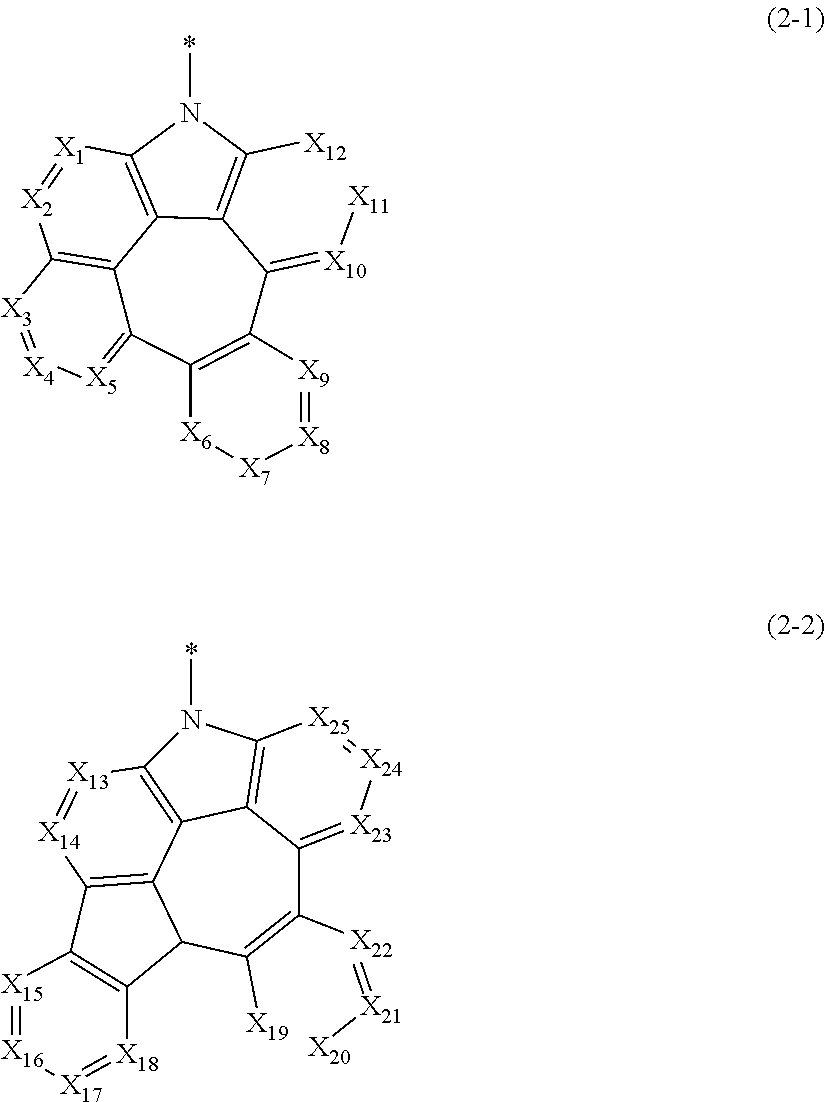
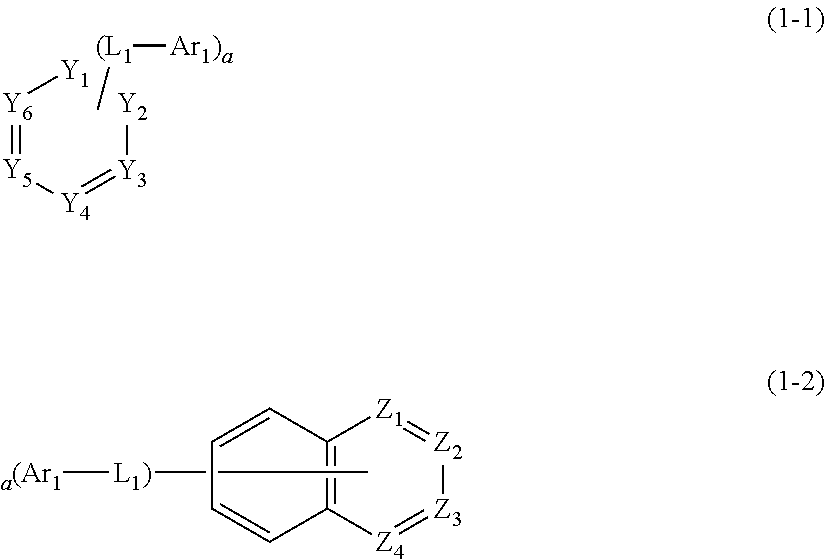




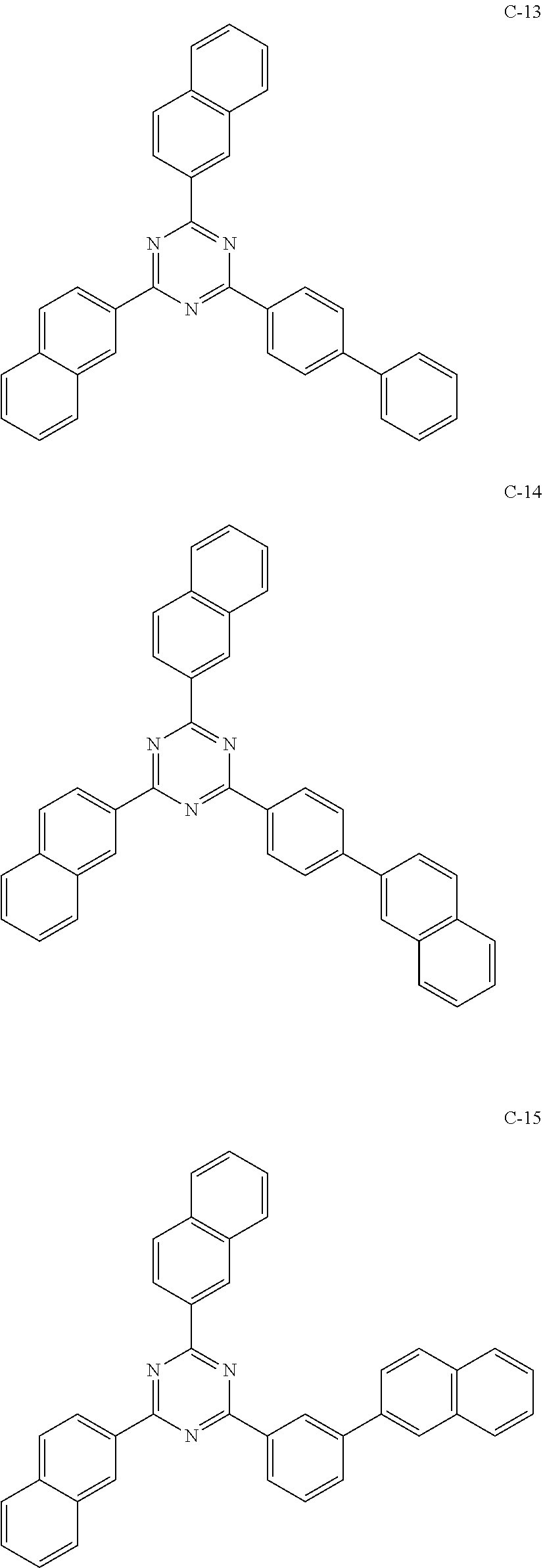
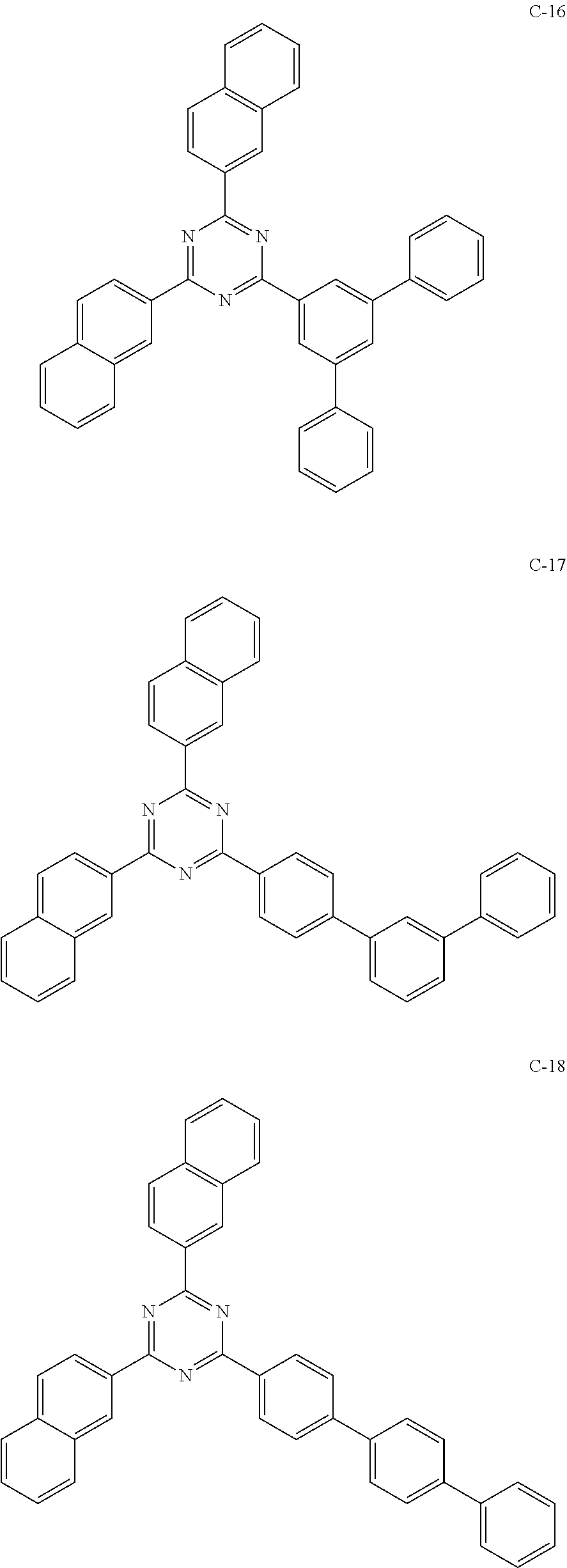


View All Diagrams
| United States Patent Application | 20220102645 |
| Kind Code | A1 |
| Kim; Bitnari ; et al. | March 31, 2022 |
PLURALITY OF HOST MATERIALS AND ORGANIC ELECTROLUMINESCENT DEVICE COMPRISING THE SAME
Abstract
The present disclosure relates to a plurality of host materials comprising at least one of a first host compound represented by formula 1 and at least one of a second host compound represented by formula 2 and an organic electroluminescent device comprising the same. By comprising the host materials, an organic electroluminescent device having low driving voltage and/or a high luminous efficiency and/or long lifespan can be provided.
| Inventors: | Kim; Bitnari; (Gyeonggi-do, KR) ; LEE; Su-Hyun; (Gyeonggi-do, KR) ; JUNG; So-Young; (Gyeonggi-do, KR) ; HAN; Tae-Jun; (Gyeonggi-do, KR) ; PARK; Hyo-Soon; (Gyeonggi-do, KR) ; CHO; Sang-Hee; (Gyeonggi-do, KR) ; YANG; Jeong-Eun; (Gyeonggi-do, KR) | ||||||||||
| Applicant: |
|
||||||||||
|---|---|---|---|---|---|---|---|---|---|---|---|
| Appl. No.: | 17/264745 | ||||||||||
| Filed: | June 28, 2019 | ||||||||||
| PCT Filed: | June 28, 2019 | ||||||||||
| PCT NO: | PCT/KR2019/007865 | ||||||||||
| 371 Date: | January 29, 2021 |
| International Class: | H01L 51/00 20060101 H01L051/00 |
Foreign Application Data
| Date | Code | Application Number |
|---|---|---|
| Jul 31, 2018 | KR | 10-2018-0089206 |
| May 30, 2019 | KR | 10-2019-0063914 |
Claims
1. A plurality of host materials comprising at least one of a first host compound and at least one of a second host compound, wherein the first host compound is represented by the following formula 1 and the second host compound is represented by the following formula 2: HAr-(L.sub.1-Ar.sub.1).sub.a (1) wherein, HAr represents a substituted or unsubstituted nitrogen-containing (3- to 10-membered)heteroaryl; L.sub.1 represents a single bond or a substituted or unsubstituted (C6-C30)arylene; Ar.sub.1 represents a substituted or unsubstituted (C6-C30)aryl; a represents an integer of 1 to 3; and when a is 2 or more, each of (L.sub.1-Ar.sub.1) may be the same or different; ##STR00126## wherein, L.sub.2 represents a single bond, a substituted or unsubstituted (C1-C30)alkylene, a substituted or unsubstituted (C3-C30)cycloalkylene, a substituted or unsubstituted (C6-C30)arylene, or a substituted or unsubstituted (3- to 30-membered)heteroarylene; Ar represents hydrogen, deuterium, halogen, cyano, a substituted or unsubstituted (C1-C30)alkyl, a substituted or unsubstituted (C3-C30) cycloalkyl, a substituted or unsubstituted (C3-C30)cycloalkenyl, a substituted or unsubstituted (3- to 7-membered)heterocycloalkyl, a substituted or unsubstituted (C6-C30)aryl, a substituted or unsubstituted (3- to 30-membered)heteroaryl, --NR.sub.16R.sub.17, or --SiR.sub.18R.sub.19R.sub.20; or may be linked to adjacent substituents to form a ring; R.sub.16 to R.sub.20 each independently represent a substituted or unsubstituted (C1-C30)alkyl, a substituted or unsubstituted (C6-C30)aryl, or a substituted or unsubstituted (3- to 30-membered)heteroaryl; and ##STR00127## is represented by the following formula 2-1 or 2-2; ##STR00128## wherein, X.sub.1 to X.sub.25 each independently represent N or CR.sub.a; and R.sub.a each independently represents hydrogen, deuterium, halogen, cyano, a substituted or unsubstituted (C1-C30)alkyl, a substituted or unsubstituted (C6-C30)aryl, a substituted or unsubstituted (3- to 30-membered)heteroaryl, a substituted or unsubstituted (C3-C30)cycloalkyl, a substituted or unsubstituted (C1-C30)alkoxy, a substituted or unsubstituted tri(C1-C30)alkylsilyl, a substituted or unsubstituted di(C1-C30)alkyl(C6-C30)arylsilyl, a substituted or unsubstituted (C1-C30)alkyldi(C6-C30)arylsilyl, a substituted or unsubstituted tri(C6-C30)arylsilyl, a substituted or unsubstituted mono- or di-(C1-C30)alkylamino, a substituted or unsubstituted mono- or di-(C6-C30)arylamino, or a substituted or unsubstituted (C1-C30)alkyl(C6-C30)arylamino; or may be linked to adjacent substituents to form a ring.
2. The host materials according to claim 1, wherein the formula 1 is represented by the following formula 1-1 or 1-2: ##STR00129## wherein, Y.sub.1 to Y.sub.6 and Z.sub.1 to Z.sub.4 each independently represent CR.sub.4 or N, provided that at least one of Y.sub.1 to Y.sub.6 represents N, and at least one of Z.sub.1 to Z.sub.4 represents N; R.sub.4 each independently represents hydrogen, a substituted or unsubstituted (C1-C30)alkyl, a substituted or unsubstituted (C2-C30)alkenyl, or a substituted or unsubstituted (C6-C30)aryl; or may be linked to adjacent substituents to form a ring; L.sub.1, Ar.sub.1, and a are as defined in claim 1.
3. The host materials according to claim 1, wherein the formula 2 is represented by the following formula 2-1-1: ##STR00130## wherein, R.sub.41 to R.sub.43 each independently represent hydrogen, deuterium, halogen, cyano, a substituted or unsubstituted (C1-C30)alkyl, a substituted or unsubstituted (C6-C30)aryl, a substituted or unsubstituted (3- to 30-membered)heteroaryl, a substituted or unsubstituted (C3-C30)cycloalkyl, a substituted or unsubstituted (C1-C30)alkoxy, a substituted or unsubstituted tri(C1-C30)alkylsilyl, a substituted or unsubstituted di(C1-C30)alkyl(C6-C30)arylsilyl, a substituted or unsubstituted (C1-C30)alkyldi(C6-C30)arylsilyl, a substituted or unsubstituted tri(C6-C30)arylsilyl, a substituted or unsubstituted mono- or di-(C1-C30)alkylamino, a substituted or unsubstituted mono- or di-(C6-C30)arylamino, or a substituted or unsubstituted (C1-C30)alkyl(C6-C30)arylamino; or may be linked to adjacent substituents to form a ring; ba represents an integer of 1 to 3, bb represents an integer of 1 to 4, and bc represents an integer of 1 to 5; and when ba, bb, and bc are 2 or more, each of R.sub.41, each of R.sub.42 or each of R.sub.43 may be the same or different.
4. The host materials according to claim 1, wherein the formula 2-2 is represented by the following formula 2-2-1: ##STR00131## wherein, R.sub.31 to R.sub.34 each independently represent hydrogen, deuterium, halogen, cyano, a substituted or unsubstituted (C1-C30)alkyl, a substituted or unsubstituted (C6-C30)aryl, a substituted or unsubstituted (3- to 30-membered)heteroaryl, a substituted or unsubstituted (C3-C30)cycloalkyl, a substituted or unsubstituted (C1-C30)alkoxy, a substituted or unsubstituted tri(C1-C30)alkylsilyl, a substituted or unsubstituted di(C1-C30)alkyl(C6-C30)arylsilyl, a substituted or unsubstituted (C1-C30)alkyldi(C6-C30)arylsilyl, a substituted or unsubstituted tri(C6-C30)arylsilyl, a substituted or unsubstituted mono- or di-(C1-C30)alkylamino, a substituted or unsubstituted mono- or di-(C6-C30)arylamino, or a substituted or unsubstituted (C1-C30)alkyl(C6-C30)arylamino; or may be linked to adjacent substituents to form a ring; aa represents an integer of 1 to 3, ab and ac each independently represent an integer of 1 to 4, ad represents an integer of 1 or 2; and when aa, ab, ac, and ad are 2 or more, each of R.sub.31, each of R.sub.32, each of R.sub.33, or each of R.sub.34 may be the same or different.
5. The host materials according to claim 1, wherein Ar represents a substituted or unsubstituted phenyl, a substituted or unsubstituted naphthyl, a substituted or unsubstituted o-biphenyl, a substituted or unsubstituted m-biphenyl, a substituted or unsubstituted p-biphenyl, a substituted or unsubstituted naphthylphenyl, a substituted or unsubstituted phenylnaphthyl, a substituted or unsubstituted o-terphenyl, a substituted or unsubstituted m-terphenyl, a substituted or unsubstituted p-terphenyl, a substituted or unsubstituted carbazolyl, a substituted or unsubstituted benzocarbazolyl, a substituted or unsubstituted dibenzocarbazolyl, a substituted or unsubstituted dibenzothiophenyl, a substituted or unsubstituted benzothiophenyl, a substituted or unsubstituted benzonaphthothiophenyl, a substituted or unsubstituted dibenzofuranyl, a substituted or unsubstituted benzofuranyl, a substituted or unsubstituted benzonaphthofuranyl, a substituted or unsubstituted fluorenyl, a substituted or unsubstituted benzofluorenyl, a substituted or unsubstituted spirobifluorenyl, a substituted or unsubstituted diphenylamino, a substituted or unsubstituted phenylbiphenylamino, a substituted or unsubstituted naphthylphenylamino, a substituted or unsubstituted naphthylbiphenylamino, a substituted or unsubstituted dibiphenylamino, a substituted or unsubstituted biphenylfluorenylamino, or a substituted or unsubstituted biphenyldibenzofuranylamino.
6. The host materials according to claim 1, wherein the compound represented by formula 1 is selected from the group consisting of: ##STR00132## ##STR00133## ##STR00134## ##STR00135## ##STR00136## ##STR00137## ##STR00138## ##STR00139## ##STR00140## ##STR00141## ##STR00142## ##STR00143## ##STR00144## ##STR00145## ##STR00146## ##STR00147## ##STR00148## ##STR00149## ##STR00150## ##STR00151## ##STR00152## ##STR00153## ##STR00154## ##STR00155## ##STR00156## ##STR00157## ##STR00158## ##STR00159## ##STR00160## ##STR00161## ##STR00162## ##STR00163## ##STR00164## ##STR00165## ##STR00166## ##STR00167## ##STR00168## ##STR00169## ##STR00170## ##STR00171##
7. The host materials according to claim 1, wherein the compound represented by formula 2 is selected from the group consisting of: ##STR00172## ##STR00173## ##STR00174## ##STR00175## ##STR00176## ##STR00177## ##STR00178## ##STR00179## ##STR00180## ##STR00181## ##STR00182## ##STR00183## ##STR00184## ##STR00185## ##STR00186## ##STR00187## ##STR00188## ##STR00189## ##STR00190## ##STR00191## ##STR00192## ##STR00193##
8. An organic electroluminescent device comprising: an anode, a cathode, and at least one light-emitting layer between the anode and the cathode, wherein the at least one light-emitting layer comprises the plurality of host materials according to claim 1.
Description
TECHNICAL FIELD
[0001] The present disclosure relates to a plurality of host materials and an organic electroluminescent device comprising the same.
BACKGROUND ART
[0002] An electroluminescent device (EL device) is a self-light-emitting display device which has advantages in that it provides a wider viewing angle, a greater contrast ratio, and a faster response time. The first organic EL device was developed by Eastman Kodak in 1987, by using small aromatic diamine molecules and aluminum complexes as materials for forming a light-emitting layer [Appl. Phys. Lett. 51, 913, 1987].
[0003] An organic EL device (OLED) changes electric energy into light by applying electricity to an organic electroluminescent material, and commonly comprises an anode, a cathode, and an organic layer formed between the two electrodes. The organic layer of the organic EL device may comprise a hole injection layer, a hole transport layer, a hole auxiliary layer, a light-emitting auxiliary layer, an electron blocking layer, a light-emitting layer (containing host and dopant materials), an electron buffer layer, a hole blocking layer, an electron transport layer, an electron injection layer, etc. The materials used in the organic layer can be classified into a hole injection material, a hole transport material, a hole auxiliary material, a light-emitting auxiliary material, an electron blocking material, a light-emitting material, an electron buffer material, a hole blocking material, an electron transport material, an electron injection material, etc., depending on their functions. In such an organic EL device, holes from the anode and electrons from the cathode are injected into a light-emitting layer by the application of electric voltage, and excitons having high energy are produced by the recombination of the holes and electrons. The organic light-emitting compound moves into an excited state by the energy and emits light from an energy when the organic light-emitting compound returns to the ground state from the excited state.
[0004] The most important factor determining luminous efficiency in an organic EL device is light-emitting materials. The light-emitting materials are required to have the following features: high quantum efficiency, high movement degree of an electron and a hole, and uniformity and stability of the formed light-emitting material layer. The light-emitting material is classified into blue, green, and red light-emitting materials according to the light-emitting color, and further includes yellow or orange light-emitting materials. Furthermore, the light-emitting material is classified into a host material and a dopant material in a functional aspect. Recently, an urgent task is the development of an organic EL device having high efficiency and long lifespan. In particular, the development of highly excellent light-emitting material over conventional materials is urgently required, considering the EL properties necessary for medium and large-sized OLED panels. For this, preferably, as a solvent in a solid state and an energy transmitter, the preferable characteristics of a host material should have high purity and a suitable molecular weight in order to be deposited under vacuum. Furthermore, a host material is required to have high glass transition temperature and pyrolysis temperature to achieve thermal stability, high electrochemical stability to achieve long lifespan, easy formability of an amorphous thin film, good adhesion with adjacent layers, and no movement between layers.
[0005] A light-emitting material can be used as a combination of a host and a dopant to improve color purity, luminous efficiency, and stability. Generally, a device having EL excellent characteristics has a structure comprising a light-emitting layer formed by doping a dopant to a host. When using such a dopant/host material system as a light-emitting material, their selection is important since host materials greatly influence the efficiency and lifespan of the EL device.
[0006] Korean Patent Publication No. 2018-0012709 A discloses a compound having a fused structure including indolocarbazole and azepine as a host material; however, said reference does not specifically disclose a plurality of host materials having a specific combination as the present disclosure.
DISCLOSURE OF INVENTION
Technical Problem
[0007] The object of the present disclosure is firstly, to provide a plurality of host materials which is able to produce an organic electroluminescent device having low driving voltage and/or high luminous efficiency, and/or long lifespan, and secondly, to provide an organic electroluminescent device comprising the host materials.
Solution to Problem
[0008] As a result of intensive studies to solve the technical problem above, the present inventors found that the aforementioned objective can be achieved by a plurality of host materials comprising at least one first host compound represented by the following formula 1 and at least one second host compound represented by the following formula 2, so that the present invention was completed.
HAr-(L.sub.1-Ar.sub.1).sub.a (1)
[0009] In formula 1,
[0010] HAr represents a substituted or unsubstituted nitrogen-containing (3- to 10-membered)heteroaryl;
[0011] L.sub.1 represents a single bond or a substituted or unsubstituted (C6-C30)arylene;
[0012] Ar.sub.1 represents a substituted or unsubstituted (C6-C30)aryl;
[0013] a represents an integer of 1 to 3; and
[0014] when a is 2 or more, each of (L.sub.1-Ar.sub.1) may be the same or different.
##STR00001##
[0015] In formula 2,
[0016] L.sub.2 represents a single bond, a substituted or unsubstituted (C1-C30)alkylene, a substituted or unsubstituted (C3-C30)cycloalkylene, a substituted or unsubstituted (C6-C30)arylene, or a substituted or unsubstituted (3- to 30-membered)heteroarylene;
[0017] Ar represents hydrogen, deuterium, halogen, cyano, a substituted or unsubstituted (C1-C30)alkyl, a substituted or unsubstituted (C3-C30)cycloalkyl, a substituted or unsubstituted (C3-C30)cycloalkenyl, a substituted or unsubstituted (3- to 7-membered)heterocycloalkyl, a substituted or unsubstituted (C6-C30)aryl, a substituted or unsubstituted (3- to 30-membered)heteroaryl, --NR.sub.16R.sub.17, or --SiR.sub.16R.sub.19R.sub.20; or may be linked to adjacent substituents to form a ring;
[0018] R.sub.16 to R.sub.20 each independently represent a substituted or unsubstituted (C1-C30)alkyl, a substituted or unsubstituted (C6-C30)aryl, or a substituted or unsubstituted (3- to 30-membered)heteroaryl; and
##STR00002##
is represented by the following formula 2-1 or 2-2.
##STR00003##
[0019] In formulae 2-1 and 2-2.
[0020] X.sub.1 to X.sub.25 each independently represent N or CR.sub.a; and
[0021] R.sub.a each independently represent hydrogen, deuterium, halogen, cyano, a substituted or unsubstituted (C1-C30)alkyl, a substituted or unsubstituted (C6-C30)aryl, a substituted or unsubstituted (3- to 30-membered)heteroaryl, a substituted or unsubstituted (C3-C30)cycloalkyl, a substituted or unsubstituted (C1-C30)alkoxy, a substituted or unsubstituted tri(C1-C30)alkylsilyl, a substituted or unsubstituted di(C1-C30)alkyl(C6-C30)arylsilyl, a substituted or unsubstituted (C1-C30)alkyldi(C6-C30)arylsilyl, a substituted or unsubstituted tri(C6-C30)arylsilyl, a substituted or unsubstituted mono- or di-(C1-C30)alkylamino, a substituted or unsubstituted mono- or di-(C6-C30)arylamino, or a substituted or unsubstituted (C1-C30)alkyl(C6-C30)arylamino; or may be linked to adjacent substituents to form a ring.
Advantageous Effects of Invention
[0022] By using a plurality of host materials according to the present disclosure, an organic electroluminescent device having a low driving voltage and/or a high luminous efficiency and/or long lifespan can be prepared.
MODE FOR THE INVENTION
[0023] Hereinafter, the present disclosure will be described in detail. However, the following description is intended to explain the invention, and is not meant in any way to restrict the scope of the invention.
[0024] The present disclosure relates to a plurality of host materials comprising at least one first host compound represented by the above formula 1 and at least one second host compound represented by the above formula 2, and an organic electroluminescent device comprising the host materials.
[0025] Herein, "organic electroluminescent material" means a material that may be used in an organic electroluminescent device, and may comprise at least one compound. The organic electroluminescent material may be comprised in any layer constituting an organic electroluminescent device, as necessary. For example, the organic electroluminescent material may be a hole injection material, a hole transport material, a hole auxiliary material, a light-emitting auxiliary material, an electron blocking material, a light-emitting material (containing host and dopant materials), an electron buffer material, a hole blocking material, an electron transport material, or an electron injection material, etc.
[0026] Herein, "a plurality of host materials" means a host material comprising a combination of at least two compounds, which may be comprised in any light-emitting layer constituting an organic electroluminescent device. It may mean both a material before being comprised in an organic electroluminescent device (e.g., before vapor deposition) and a material after being comprised in an organic electroluminescent device (e.g., after vapor deposition). In one embodiment, a plurality of host materials of the present disclosure may be a combination of at least two host materials, and selectively, conventional materials comprised in organic electroluminescent materials may be additionally comprised. The at least two compounds comprised in the plurality of host materials of the present disclosure may be comprised together in one light-emitting layer, or may each be comprised in separate light-emitting layers by a method known in the field. For example, the at least two compounds may be mixture-evaporated or co-evaporated, or may be individually evaporated.
[0027] Herein, "(C1-C30)alkyl(ene)" is meant to be a linear or branched alkyl having 1 to 30 carbon atoms constituting the chain, in which the number of carbon atoms is preferably 1 to 20, and more preferably 1 to 10. The above alkyl may include methyl, ethyl, n-propyl, isopropyl, n-butyl, isobutyl, tert-butyl, etc. "(C3-C30)cycloalkyl(ene)" is a mono- or polycyclic hydrocarbon having 3 to 30 ring backbone carbon atoms, in which the number of carbon atoms is preferably 3 to 20, and more preferably 3 to 7. The above cycloalkyl may include cyclopropyl, cyclobutyl, cyclopentyl, cyclohexyl, etc. "(C3-C30)cycloalkenyl" is meant to be a mono- or polycyclic hydrocarbon having a 3 to 30 carbon atom ring backbone, which has a double bond(s), in which the number of carbon atoms is preferably 3 to 20, and more preferably 3 to 7. The above cycloalkenyl may include cyclopropenyl, cyclobutenyl, cyclopentenyl, etc. "(3- to 7-membered)heterocycloalkyl" is a cycloalkyl having 3 to 7 ring backbone atoms, preferably 5 to 7 ring backbone atoms and at least one heteroatom selected from the group consisting of B, N, O, S, Si, and P, preferably O, S. and N, and includes tetrahydrofuran, pyrrolidine, thiolan, tetrahydropyran, etc. "(C6-C30)aryl(ene)" is a monocyclic or fused ring radical derived from an aromatic hydrocarbon having 6 to 30 ring backbone carbon atoms, in which the number of the ring backbone carbon atoms is preferably 6 to 20, more preferably 6 to 15, may be partially saturated, and may comprise a spiro structure. Examples of the aryl specifically include phenyl, biphenyl, terphenyl, quaterphenyl, naphthyl, binaphthyl, phenylnaphthyl, naphthylphenyl, fluorenyl, phenylfluorenyl, dimethylfluorenyl, diphenylfluorenyl, benzofluorenyl, diphenylbenzofluorenyl, dibenzofluorenyl, phenanthrenyl, benzophenanthrenyl, phenylphenanthrenyl, anthracenyl, benzanthracenyl, indenyl, triphenylenyl, pyrenyl, tetracenyl, perylenyl, chrysenyl, benzochrysenyl, naphthacenyl, fluoranthenyl, benzofluoranthenyl, tolyl, xylyl, mesityl, cumenyl, spiro[fluorene-fluorene]yl, spiro[fluorene-benzofluorene]yl, azulenyl, etc. More specifically, the aryl may be o-tolyl, m-tolyl, p-tolyl, 2,3-xylyl, 3,4-xylyl, 2,5-xylyl, mesityl, o-cumenyl, m-cumenyl, p-cumenyl, p-t-butylphenyl, p-(2-phenylpropyl)phenyl, 4'-methylbiphenyl, 4''-t-butyl-p-terphenyl-4-yl, o-biphenyl, m-biphenyl, p-biphenyl, o-terphenyl, m-terphenyl-4-yl, m-terphenyl-3-yl, m-terphenyl-2-yl, p-terphenyl-4-yl, p-terphenyl-3-yl, p-terphenyl-2-yl, m-quaterphenyl, 1-naphthyl, 2-naphthyl, 1-fluorenyl, 2-fluorenyl, 3-fluorenyl, 4-fluorenyl, 9-fluorenyl, 9,9-dimethyl-1-fluorenyl, 9,9-dimethyl-2-fluorenyl, 9,9-dimethyl-3-fluorenyl, 9,9-dimethyl-4-fluorenyl, 9,9-diphenyl-1-fluorenyl, 9,9-diphenyl-2-fluorenyl, 9,9-diphenyl-3-fluorenyl, 9,9-diphenyl-4-fluorenyl, 1-anthryl, 2-anthryl, 9-anthryl, 1-phenanthryl, 2-phenanthryl, 3-phenanthryl, 4-phenanthryl, 9-phenanthryl, 1-chrysenyl, 2-chrysenyl, 3-chrysenyl, 4-chrysenyl, 5-chrysenyl, 6-chrysenyl, benzo[c]phenanthryl, benzo[g]chrysenyl, 1-triphenylenyl, 2-triphenylenyl, 3-triphenylenyl, 4-triphenylenyl, 3-fluoranthenyl, 4-fluoranthenyl, 8-fluoranthenyl, 9-fluoranthenyl, benzofluoranthenyl, etc. "(3- to 30-membered)heteroaryl(ene)" is an aryl having 3 to 30 ring backbone atoms, in which the number of ring backbone atoms is preferably 5 to 25, including at least one, preferably 1 to 4 heteroatoms selected from the group consisting of B, N, O, S, Si, P, and Ge. The above heteroaryl may be a monocyclic ring, or a fused ring condensed with at least one benzene ring; and may be partially saturated. The above heteroatom may be linked with at least one substituent selected from the group consisting of hydrogen, deuterium, halogen, cyano, a substituted or unsubstituted (C1-C30)alkyl, a substituted or unsubstituted (C6-C30)aryl, a substituted or unsubstituted (5- to 30-membered)heteroaryl, a substituted or unsubstituted (C3-C30)cycloalkyl, a substituted or unsubstituted (C1-C30)alkoxy, a substituted or unsubstituted tri(C1-C30)alkylsilyl, a substituted or unsubstituted di(C1-C30)alkyl(C6-C30)arylsilyl, a substituted or unsubstituted (C1-C30)alkyldi(C6-C30)arylsilyl, a substituted or unsubstituted tri(C6-C30)arylsilyl, a substituted or unsubstituted mono- or di-(C1-C30)alkylamino, a substituted or unsubstituted mono- or di-(C6-C30)arylamino, and a substituted or unsubstituted (C1-C30)alkyl(C6-30)arylamino. Also, the above heteroaryl may be one formed by linking at least one heteroaryl or aryl group to a heteroaryl group via a single bond(s); and may comprise a spiro structure. Examples of the heteroaryl specifically may include a monocyclic ring-type heteroaryl including furyl, thiophenyl, pyrrolyl, imidazolyl, pyrazolyl, thiazolyl, thiadiazolyl, isothiazolyl, isoxazolyl, oxazolyl, oxadiazolyl, triazinyl, tetrazinyl, triazolyl, tetrazolyl, furazanyl, pyridyl, pyrazinyl, pyrimidinyl, pyridazinyl, etc., and a fused ring-type heteroaryl including benzofuranyl, benzothiophenyl, isobenzofuranyl, dibenzofuranyl, dibenzothiophenyl, benzoimidazolyl, benzothiazolyl, benzoisothiazolyl, benzoisoxazolyl, benzoxazolyl, imidazopyridinyl, isoindolyl, indolyl, benzoindolyl, indazolyl, benzothiadiazolyl, quinolyl, isoquinolyl, cinnolinyl, quinazolinyl, quinoxalinyl, carbazolyl, azacarbazolyl, benzocarbazolyl, dibenzocarbazolyl, phenoxazinyl, phenanthridinyl, benzodioxolyl, indolizidinyl, acrylidinyl, silafluorenyl, germafluorenyl, etc. More specifically, the heteroaryl may be 1-pyrrolyl, 2-pyrrolyl, 3-pyrrolyl, 2-pyridinyl, 3-pyridinyl, 4-pyridinyl, 2-pyrimidinyl, 4-pyrimidinyl, 5-pyrimidinyl, 6-pyrimidinyl, 1,2,3-triazin-4-yl, 1,2,4-triazin-3-yl, 1,3,5-triazin-2-yl, 1-imidazolyl, 2-imidazolyl, 1-pyrazolyl, 1-indolizidinyl, 2-indolizidinyl, 3-indolizidinyl, 5-indolizidinyl, 6-indolizidinyl, 7-indolizidinyl, 8-indolizidinyl, 2-imidazopyridinyl, 3-imidazopyridinyl, 5-imidazopyridinyl, 6-imidazopyridinyl, 7-imidazopyridinyl, 8-imidazopyridinyl, 1-indolyl, 2-indolyl, 3-indolyl, 4-indolyl, 5-indolyl, 6-indolyl, 7-indolyl, 1-isoindolyl, 2-isoindolyl, 3-isoindolyl, 4-isoindolyl, 5-isoindolyl, 6-isoindolyl, 7-isoindolyl, 2-furyl, 3-furyl, 2-benzofuranyl, 3-benzofuranyl, 4-benzofuranyl, 5-benzofuranyl, 6-benzofuranyl, 7-benzofuranyl, 1-isobenzofuranyl, 3-isobenzofuranyl, 4-isobenzofuranyl, 5-isobenzofuranyl, 6-isobenzofuranyl, 7-isobenzofuranyl, 2-quinolyl, 3-quinolyl, 4-quinolyl, 5-quinolyl, 6-quinolyl, 7-quinolyl, 8-quinolyl, 1-isoquinolyl, 3-isoquinolyl, 4-isoquinolyl, 5-isoquinolyl, 6-isoquinolyl, 7-isoquinolyl, 8-isoquinolyl, 2-quinoxalinyl, 5-quinoxalinyl, 6-quinoxalinyl, 1-carbazolyl, 2-carbazolyl, 3-carbazolyl, 4-carbazolyl, 9-carbazolyl, azacarbazole-1-yl, azacarbazole-2-yl, azacarbazole-3-yl, azacarbazole-4-yl, azacarbazole-5-yl, azacarbazole-6-yl, azacarbazole-7-yl, azacarbazole-8-yl, azacarbazole-9-yl, 1-phenanthridinyl, 2-phenanthridinyl, 3-phenanthridinyl, 4-phenanthridinyl, 6-phenanthridinyl, 7-phenanthridinyl, 8-phenanthridinyl, 9-phenanthridinyl, 10-phenanthridinyl, 1-acrylidinyl, 2-acrylidinyl, 3-acrylidinyl, 4-acrylidinyl, 9-acrylidinyl, 2-oxazolyl, 4-oxazolyl, 5-oxazolyl, 2-oxadiazolyl, 5-oxadiazolyl, 3-furazanyl, 2-thienyl, 3-thienyl, 2-methylpyrrole-1-yl, 2-methylpyrrole-3-yl, 2-methylpyrrole-4-yl, 2-methylpyrrole-5-yl, 3-methylpyrrole-1-yl, 3-methylpyrrole-2-yl, 3-methylpyrrole-4-yl, 3-methylpyrrole-5-yl, 2-t-butylpyrrole-4-yl, 3-(2-phenylpropyl)pyrrole-1-yl, 2-methyl-1-indolyl, 4-methyl-1-indolyl, 2-methyl-3-indolyl, 4-methyl-3-indolyl, 2-t-butyl-1-indolyl, 4-t-butyl-1-indolyl, 2-t-butyl-3-indolyl, 4-t-butyl-3-indolyl, 1-dibenzofuranyl, 2-dibenzofuranyl, 3-dibenzofuranyl, 4-dibenzofuranyl, 1-dibenzothiophenyl, 2-dibenzothiophenyl, 3-dibenzothiophenyl, 4-dibenzothiophenyl, 1-silafluorenyl, 2-silafluorenyl, 3-silafluorenyl, 4-silafluorenyl, 1-germafluorenyl, 2-germafluorenyl, 3-germafluorenyl, 4-germafluorenyl, etc. Herein, "Halogen" includes F, Cl, Br, and I.
[0028] In addition, "ortho (o)." "meta (m)," and "para (p)" are meant to signify the substitution position of all substituents. Ortho position is a compound with substituents, which are adjacent to each other, e.g., at the 1 and 2 positions on benzene. Meta position is the next substitution position of the immediately adjacent substitution position, e.g., a compound with substituents at the 1 and 3 positions on benzene. Para position is the next substitution position of the meta position, e.g., a compound with substituents at the 1 and 4 positions on benzene.
[0029] Herein, "a substituted or unsubstituted ring formed in linking to an adjacent substituent" means a substituted or unsubstituted (3- to 30-membered) mono- or polycyclic, alicyclic, aromatic ring, or a combination thereof, formed by linking or fusing two or more adjacent substituents; preferably, may be a substituted or unsubstituted (3- to 26-membered) mono- or polycyclic, alicyclic, aromatic ring, or a combination thereof. In addition, at least one of the carbon atoms in the formed ring may be replaced with at least one heteroatom selected from the group consisting of B, N, O, S, Si, and P, preferably, N, O, and S. According to one embodiment, the ring formed in linking to an adjacent substituent may be a (5- to 20-membered) polycyclic aromatic ring, which may contain at least one heteroatom selected from the group consisting of N, O, and S.
[0030] In addition, "substituted" in the expression "substituted or unsubstituted" means that a hydrogen atom in a certain functional group is replaced with another atom or functional group, i.e., a substituent. The substituents of the substituted (C1-C30)alkyl(ene), the substituted (C6-C30)aryl(ene), the substituted (3- to 30-membered)heteroaryl(ene), the substituted (C3-C30)cycloalkyl(ene), the substituted (C3-C30)cycloalkenyl, the substituted (3- to 7-membered)heterocycloalkyl, the substituted (C1-C30)alkoxy, the substituted tri(C1-C30)alkylsilyl, the substituted di(C1-C30)alkyl(C6-C30)arylsilyl, the substituted (C1-C30)alkyldi(C6-C30)arylsilyl, the substituted tri(C6-C30)arylsilyl, the substituted mono- or di-(C1-C30)alkylamino, the substituted mono- or di-(C6-C30)arylamino, and the substituted (C1-C30)alkyl(C6-C30)arylamino in HAr, L.sub.1, Ar.sub.1, L.sub.2, Ar, R.sub.16 to R.sub.20, and R.sub.a of formulae 1 and 2, are each independently at least one selected from the group consisting of deuterium, halogen, cyano, carboxyl, nitro, hydroxyl, (C1-C30)alkyl, halo(C1-C30)alkyl, (C2-C30)alkenyl, (C2-C30)alkynyl, (C1-C30)alkoxy, (C1-C30)alkylthio, (C3-C30)cycloalkyl, (C3-C30)cycloalkenyl, (3- to 7-membered)heterocycloalkyl, (C6-C30)aryloxy, (C6-C30)arylthio, (C6-C30)aryl-substituted or unsubstituted (5- to 30-membered)heteroaryl, (5- to 30-membered)heteroaryl-substituted or unsubstituted (C6-C30)aryl, tri(C1-C30)alkylsilyl, tri(C6-C30)arylsilyl, di(C1-C30)alkyl(C6-C30)arylsilyl, (C1-C30)alkyldi(C6-C30)arylsilyl, amino, mono- or di-(C1-C30)alkylamino, (C1-C30)alkyl-substituted or unsubstituted mono- or di-(C6-C30)arylamino, (C1-C30)alkyl(C6-C30)arylamino, (C1-C30)alkylcarbonyl, (C1-C30)alkoxycarbonyl, (C6-C30)arylcarbonyl, di(C6-C30)arylboronyl, di(C1-C30)alkylboronyl, (C1-C30)alkyl(C6-C30)arylboronyl, (C6-C30)ar(C1-C30)alkyl, and (C1-C30)alkyl(C6-C30)aryl, e.g., the substituents may be a substituted or unsubstituted methyl, a substituted or unsubstituted phenyl, a substituted or unsubstituted biphenyl, a substituted or unsubstituted naphthyl, a substituted or unsubstituted fluorenyl, a substituted or unsubstituted carbazolyl, a substituted or unsubstituted dibenzofuranyl, a substituted or unsubstituted dibenzothiophenyl, a substituted or unsubstituted diphenylamino, or a substituted or unsubstituted phenylbiphenylamino.
[0031] Hereinafter, the host material according to one embodiment will be described.
[0032] Host materials according to the present disclosure comprise at least one first host compound represented by the above formula 1 and at least one second host compound represented by the above formula 2; and the host material may be contained in the light-emitting layer of an organic electroluminescent device according to one embodiment.
[0033] The first host compound as the host material according to one embodiment may be represented by the following formula 1.
HAr-(L.sub.1-Ar.sub.1).sub.a (1)
[0034] In formula 1,
[0035] HAr represents a substituted or unsubstituted nitrogen-containing (3- to 10-membered)heteroaryl;
[0036] L.sub.1 represents a single bond or a substituted or unsubstituted (C6-C30)arylene;
[0037] Ar.sub.1 represents a substituted or unsubstituted (C6-C30)aryl;
[0038] a represents an integer of 1 to 3; and
[0039] when a is 2 or more, each of (L.sub.1-Ar.sub.1) may be the same or different.
[0040] In one embodiment, HAr may be a substituted or unsubstituted nitrogen-containing (5-to 10-membered)heteroaryl, preferably, an unsubstituted nitrogen-containing (6- to 10-membered)heteroaryl. For example, HAr may be pyrimidinyl, triazinyl, quinolinyl, quinoxalinyl, or quinazolinyl.
[0041] In one embodiment, L.sub.1 may be a single bond or a substituted or unsubstituted (C6-C25)arylene, preferably, a single bond or an unsubstituted (C6-C20)arylene. For example, L.sub.1 may be a single bond, naphthyl- or fluorenyl-substituted or unsubstituted phenylene, m-biphenylene, p-biphenylene, naphthylene, phenyl-substituted or unsubstituted fluorenylene, or phenyl-substituted or unsubstituted benzofluorenylene.
[0042] In one embodiment, Ar.sub.1 may be a substituted or unsubstituted (C6-C25)aryl, preferably, (C1-C6)alkyl- or (C6-C18)aryl-substituted or unsubstituted (C6-C18)aryl. For example, Ar.sub.1 may be fluorenyl-substituted or unsubstituted phenyl, m-biphenyl, p-biphenyl, naphthyl, m-terphenyl, p-terphenyl, triphenylenyl, phenanthrenyl, at least one phenyl- or at least one methyl-substituted fluorenyl (e.g., phenylfluorenyl, diphenylfluorenyl, or dimethylfluorenyl), or at least one phenyl- or at least one methyl-substituted benzofluorenyl (e.g., dimethylbenzofluorenyl or diphenylbenzofluorenyl).
[0043] In one embodiment, a may be an integer of 2 or 3, wherein each of (L.sub.1-Ar.sub.1) may be the same or different.
[0044] The compound represented by formula 1 may be represented by the following formula 1-1 or 1-2.
##STR00004##
[0045] In formulae 1-1 and 1-2,
[0046] Y.sub.1 to Y.sub.6 and Z.sub.1 to Z.sub.4 each independently represent CR.sub.4 or N, provided that at least one of Y.sub.1 to Y.sub.6 represents N, and at least one of Z.sub.1 to Z.sub.4 represents N;
[0047] R.sub.4 each independently represents hydrogen, a substituted or unsubstituted (C1-C30)alkyl, a substituted or unsubstituted (C2-C30)alkenyl, or a substituted or unsubstituted (C6-C30)aryl; or may be linked to adjacent substituents to form a ring; and
[0048] L.sub.1, Ar.sub.1, and a are as defined in formula 1.
[0049] In one embodiment, in formula 1-1, at least one Y.sub.1 to Y.sub.6 may be N, preferably, at least two Y.sub.1 to Y.sub.6 may be N, more preferably, at least three Y.sub.1 to Y.sub.6 may be N. For example, the compound represented by formula 1-1 may be (L.sub.1-Ar.sub.1).sub.a-substituted, pyrimidine or triazine.
[0050] In one embodiment, in formula 1-2, at least one Z.sub.1 to Z.sub.4 may be N, preferably, at least two Z.sub.1 to Z.sub.4 may be N. For example, the compound represented by formula 1-2 may be (L.sub.1-Ar.sub.1).sub.a-substituted, quinoline, quinoxaline, or quinazoline.
[0051] In one embodiment, R.sub.4 each independently represent hydrogen, a substituted or unsubstituted (C1-C20)alkyl, a substituted or unsubstituted (C2-C20)alkenyl, or a substituted or unsubstituted (C6-C18)aryl; or two adjacent R.sub.4s may be linked to each other to form a substituted or unsubstituted (3- to 30-membered) mono- or polycyclic ring, preferably, hydrogen or two adjacent R.sub.4s may be linked to each other to form an unsubstituted (3- to 18-membered) mono- or polycyclic ring, more preferably, hydrogen or two adjacent R.sub.4s may be linked to each other to form an unsubstituted (3- to 10-membered) monocyclic ring. For example, R.sub.4 each independently represents hydrogen or two adjacent R.sub.4s may be fused to each other to form an unsubstituted benzene ring.
[0052] According to one embodiment, the first host compound represented by formula 1 may be illustrated by the following compounds, but is not limited thereto.
##STR00005## ##STR00006## ##STR00007## ##STR00008## ##STR00009## ##STR00010## ##STR00011## ##STR00012## ##STR00013## ##STR00014## ##STR00015## ##STR00016## ##STR00017## ##STR00018## ##STR00019## ##STR00020## ##STR00021## ##STR00022## ##STR00023## ##STR00024## ##STR00025## ##STR00026## ##STR00027## ##STR00028## ##STR00029## ##STR00030## ##STR00031## ##STR00032## ##STR00033## ##STR00034## ##STR00035## ##STR00036## ##STR00037## ##STR00038## ##STR00039## ##STR00040## ##STR00041## ##STR00042## ##STR00043## ##STR00044##
[0053] The compound of formula 1 according to the present disclosure may be produced by a synthetic method known to a person skilled in the art, for example, the compound represented by formula 1-1 or 1-2 may be synthesized referring to the following reaction scheme 1 or 2, but is not limited thereto:
##STR00045##
[0054] In reaction schemes 1 and 2, L.sub.1, Ar.sub.1 and a are as defined in formula 1, Y.sub.1 to Y.sub.6 and Z.sub.1 to Z.sub.4 are as defined in formulae 1-1 and 1-2.
[0055] As described above, exemplary synthesis examples of the compounds represented by formula 1-1 or 1-2 according to one embodiment are described, but they are based on Buchwald-Hartwig cross coupling reaction, N-arylation reaction. H-mont-mediated etherification reaction, Miyaura borylation reaction, Suzuki cross-coupling reaction, Intramolecular acid-induced cyclization reaction, Pd(II)-catalyzed oxidative cyclization reaction, Grignard reaction, Heck reaction, Cyclic Dehydration reaction, SN.sub.1 substitution reaction, SN.sub.2 substitution reaction, Phosphine-mediated reductive cyclization reaction, etc. It will be understood by one skilled in the art that the above reaction proceeds even if other substituents defined in the formula 1-1 or 1-2 other than the substituents described in the specific synthesis examples, are bonded.
[0056] The second host compound as another host material according to one embodiment may be represented by the following formula 2.
##STR00046##
[0057] In formula 2,
[0058] L.sub.2 represents a single bond, a substituted or unsubstituted (C1-C30)alkylene, a substituted or unsubstituted (C6-C30)arylene, a substituted or unsubstituted (3- to 30-membered)heteroarylene, or a substituted or unsubstituted (C3-C30)cycloalkylene;
[0059] Ar represents hydrogen, deuterium, halogen, cyano, a substituted or unsubstituted (C1-C30)alkyl, a substituted or unsubstituted (C3-C30)cycloalkyl, a substituted or unsubstituted (C3-C30)cycloalkenyl, a substituted or unsubstituted (3- to 7-membered)heterocycloalkyl, a substituted or unsubstituted (C6-C30)aryl, a substituted or unsubstituted (3- to 30-membered)heteroaryl, --NR.sub.16R.sub.17, or --SiR.sub.18R.sub.19R.sub.20; or may be linked to adjacent substituents to form a ring;
[0060] R.sub.16 to R.sub.20 each independently represent a substituted or unsubstituted (C1-C30)alkyl, a substituted or unsubstituted (C6-C30)aryl, or a substituted or unsubstituted (3- to 30-membered)heteroaryl; and
##STR00047##
is represented by the following formula 2-1 or 2-2.
##STR00048##
[0061] In formulae 2-1 and 2-2,
[0062] X.sub.1 to X.sub.25 each independently represent N or CR.sub.a; and
[0063] R.sub.a each independently represents hydrogen, deuterium, halogen, cyano, a substituted or unsubstituted (C1-C30)alkyl, a substituted or unsubstituted (C6-C30)aryl, a substituted or unsubstituted (3- to 30-membered)heteroaryl, a substituted or unsubstituted (C3-C30)cycloalkyl, a substituted or unsubstituted (C1-C30)alkoxy, a substituted or unsubstituted tri(C1-C30)alkylsilyl, a substituted or unsubstituted di(C1-C30)alkyl(C6-C30)arylsilyl, a substituted or unsubstituted (C1-C30)alkyldi(C6-C30)arylsilyl, a substituted or unsubstituted tri(C6-C30)arylsilyl, a substituted or unsubstituted mono- or di-(C1-C30)alkylamino, a substituted or unsubstituted mono- or di-(C6-C30)arylamino, or a substituted or unsubstituted (C1-C30)alkyl(C6-C30)arylamino; or may be linked to adjacent substituents to form a ring.
[0064] In one embodiment, L.sub.2 may be a single bond, a substituted or unsubstituted (C6-C30)arylene, or a substituted or unsubstituted (3- to 30-membered)heteroarylene, preferably, a single bond, a substituted or unsubstituted (C6-C25)arylene, or a substituted or unsubstituted (5- to 25-membered)heteroarylene, more preferably, a single bond, a substituted or unsubstituted (C6-C18)arylene, or a substituted or unsubstituted (5- to 18-membered)heteroarylene. For example, L.sub.2 may be a single bond, or a substituted or unsubstituted phenylene, a substituted or unsubstituted o-biphenylene, a substituted or unsubstituted m-biphenylene, a substituted or unsubstituted p-biphenylene, a substituted or unsubstituted naphthylene, or a substituted or unsubstituted carbazolylene.
[0065] In one embodiment, Ar may be hydrogen, deuterium, a substituted or unsubstituted (C6-C30)aryl, or a substituted or unsubstituted (3- to 30-membered)heteroaryl, preferably, hydrogen, deuterium, a substituted or unsubstituted (C6-C25)aryl, or a substituted or unsubstituted (5- to 25-membered)heteroaryl, more preferably, a substituted or unsubstituted (C6-C18)aryl or a substituted or unsubstituted (5- to 18-membered)heteroaryl.
[0066] Specifically, Ar may be a substituted or unsubstituted phenyl, a substituted or unsubstituted naphthyl, a substituted or unsubstituted o-biphenyl, a substituted or unsubstituted m-biphenyl, a substituted or unsubstituted p-biphenyl, a substituted or unsubstituted naphthylphenyl, a substituted or unsubstituted phenylnaphthyl, a substituted or unsubstituted o-terphenyl, a substituted or unsubstituted m-terphenyl, a substituted or unsubstituted p-terphenyl, a substituted or unsubstituted carbazolyl, a substituted or unsubstituted benzocarbazolyl, a substituted or unsubstituted dibenzocarbazolyl, a substituted or unsubstituted dibenzothiophenyl, a substituted or unsubstituted benzothiophenyl, a substituted or unsubstituted benzonaphthothiophenyl, a substituted or unsubstituted dibenzofuranyl, a substituted or unsubstituted benzofuranyl, a substituted or unsubstituted benzonaphthofuranyl, a substituted or unsubstituted fluorenyl, a substituted or unsubstituted benzofluorenyl, a substituted or unsubstituted spirobifluorenyl, a substituted or unsubstituted diphenylamino, a substituted or unsubstituted phenylbiphenylamino, a substituted or unsubstituted naphthylphenylamino, a substituted or unsubstituted naphthylbiphenylamino, a substituted or unsubstituted dibiphenylamino, a substituted or unsubstituted biphenylfluorenylamino, or a substituted or unsubstituted biphenyldibenzofuranylamino, for example, Ar may be a substituted or unsubstituted phenyl, a substituted or unsubstituted naphthyl, a substituted or unsubstituted o-biphenyl, a substituted or unsubstituted m-biphenyl, a substituted or unsubstituted p-biphenyl, a substituted or unsubstituted o-terphenyl, a substituted or unsubstituted m-terphenyl, a substituted or unsubstituted p-terphenyl, a substituted or unsubstituted carbazolyl, a substituted or unsubstituted dibenzothiophenyl, a substituted or unsubstituted dibenzofuranyl, a substituted or unsubstituted fluorenyl, a substituted or unsubstituted benzofluorenyl, a substituted or unsubstituted spirobifluorenyl, a substituted or unsubstituted diphenylamino, a substituted or unsubstituted phenylbiphenylamino, or a substituted or unsubstituted naphthylphenyl amino.
[0067] According to one embodiment, in formula 2,
##STR00049##
may be represented by the following formula 2-1.
##STR00050##
[0068] In formula 2-1,
[0069] X.sub.1 to X.sub.12 each independently represent N or CR.sub.a; and
[0070] R.sub.a each independently represents hydrogen, deuterium, halogen, cyano, a substituted or unsubstituted (C1-C30)alkyl, a substituted or unsubstituted (C6-C30)aryl, a substituted or unsubstituted (3- to 30-membered)heteroaryl, a substituted or unsubstituted (C3-C30)cycloalkyl, a substituted or unsubstituted (C1-C30)alkoxy, a substituted or unsubstituted tri(C1-C30)alkylsilyl, a substituted or unsubstituted di(C1-C30)alkyl(C6-C30)arylsilyl, a substituted or unsubstituted (C1-C30)alkyldi(C6-C30)arylsilyl, a substituted or unsubstituted tri(C6-C30)arylsilyl, a substituted or unsubstituted mono- or di-(C1-C30)alkylamino, a substituted or unsubstituted mono- or di-(C6-C30)arylamino, or a substituted or unsubstituted (C1-C30)alkyl(C6-C30)arylamino; or may be linked to adjacent substituents to form a ring.
[0071] In one embodiment, R.sub.a each independently may be hydrogen, deuterium, or a substituted or unsubstituted (C6-C30)aryl; or may be linked to adjacent substituents to form a ring, preferably, hydrogen, deuterium, or a substituted or unsubstituted (C6-C25)aryl; or may be linked or fused to adjacent substituents to form a substituted or unsubstituted (3- to 30-membered) mono- or polycyclic, alicyclic, aromatic ring, or a combination thereof, more preferably, hydrogen, deuterium, or a substituted or unsubstituted (C6-C18) aryl; or may be linked or fused to adjacent substituents to form a substituted or unsubstituted (5- to 30-membered) mono- or polycyclic, aromatic ring, or a combination thereof. For example, R.sub.a each independently may be hydrogen or a substituted or unsubstituted phenyl; or may be fused with each other to form a substituted or unsubstituted aromatic ring.
[0072] In one embodiment, X.sub.1 and X.sub.2 each independently may be CR.sub.a, wherein R.sub.a may be fused with each other to form benzene ring.
[0073] Specifically, the formula 2-1 according to one embodiment may be represented by formula 2-1-1.
##STR00051##
[0074] In formula 2-1-1,
[0075] R.sub.41 to R.sub.43 each independently represent hydrogen, deuterium, halogen, cyano, a substituted or unsubstituted (C1-C30)alkyl, a substituted or unsubstituted (C6-C30)aryl, a substituted or unsubstituted (3- to 30-membered)heteroaryl, a substituted or unsubstituted (C3-C30)cycloalkyl, a substituted or unsubstituted (C1-C30)alkoxy, a substituted or unsubstituted tri(C1-C30)alkylsilyl, a substituted or unsubstituted di(C1-C30)alkyl(C6-C30)arylsilyl, a substituted or unsubstituted (C1-C30)alkyldi(C6-C30)arylsilyl, a substituted or unsubstituted tri(C6-C30)arylsilyl, a substituted or unsubstituted mono- or di-(C1-C30)alkylamino, a substituted or unsubstituted mono- or di-(C6-C30)arylamino, or a substituted or unsubstituted (C1-C30)alkyl(C6-C30)arylamino; or may be linked to adjacent substituents to form a ring;
[0076] ba represents an integer of 1 to 3, bb represents an integer of 1 to 4, bc represents an integer of 1 to 5; and
[0077] when ba, bb, and bc are 2 or more, each of R.sub.41, each of R.sub.42 or each of R.sub.43 may be the same or different.
[0078] In one embodiment, R.sub.41 to R.sub.43 each independently may be hydrogen, deuterium, or a substituted or unsubstituted (C6-C30)aryl; or may be linked to adjacent substituents to form a ring, preferably, hydrogen, deuterium, or a substituted or unsubstituted (C6-C25)aryl; or may be linked or fused to adjacent substituents to form a substituted or unsubstituted (3- to 30-membered) mono- or polycyclic, alicyclic, aromatic ring, or a combination thereof, more preferably, hydrogen, deuterium, or a substituted or unsubstituted (C6-C18)aryl; or may be linked or fused to adjacent substituents to form a substituted or unsubstituted (5- to 30-membered) mono- or polycyclic, aromatic ring, or a combination thereof. For example, R.sub.41 to R.sub.43 each independently may be hydrogen or a substituted or unsubstituted phenyl; or may be fused with each other to form a substituted or unsubstituted aromatic ring.
[0079] According to another embodiment, in formula 2,
##STR00052##
may be represented by the following formula 2-2.
##STR00053##
[0080] In formula 2-2,
[0081] X.sub.13 to X.sub.25 each independently represent N or CR.sub.a; and
[0082] R.sub.a each independently represents hydrogen, deuterium, halogen, cyano, a substituted or unsubstituted (C1-C30)alkyl, a substituted or unsubstituted (C6-C30)aryl, a substituted or unsubstituted (3- to 30-membered)heteroaryl, a substituted or unsubstituted (C3-C30)cycloalkyl, a substituted or unsubstituted (C1-C30)alkoxy, a substituted or unsubstituted tri(C1-C30)alkylsilyl, a substituted or unsubstituted di(C1-C30)alkyl(C6-C30)arylsilyl, a substituted or unsubstituted (C1-C30)alkyldi(C6-C30)arylsilyl, a substituted or unsubstituted tri(C6-C30)arylsilyl, a substituted or unsubstituted mono- or di-(C1-C30)alkylamino, a substituted or unsubstituted mono- or di-(C6-C30)arylamino, or a substituted or unsubstituted (C1-C30)alkyl(C6-C30)arylamino; or may be linked to adjacent substituents to form a ring.
[0083] In one embodiment. R.sub.a each independently may be hydrogen, deuterium, or a substituted or unsubstituted (C6-C30)aryl; or may be linked to adjacent substituents to form a ring, preferably, hydrogen, deuterium, or a substituted or unsubstituted (C6-C25)aryl; or may be linked or fused to adjacent substituents to form a substituted or unsubstituted (3- to 30-membered) mono- or polycyclic, alicyclic, aromatic ring, or a combination thereof, more preferably, hydrogen, deuterium, or a substituted or unsubstituted (C6-C18)aryl; or may be linked or fused to adjacent substituents to form a substituted or unsubstituted (5- to 30-membered) mono- or polycyclic, aromatic ring, or a combination thereof. For example, R.sub.a each independently may be hydrogen or a substituted or unsubstituted phenyl; or may be fused with each other to form a substituted or unsubstituted aromatic ring.
[0084] In one embodiment, X.sub.15 and X.sub.16 each independently may be CR.sub.a, wherein, R.sub.a may be fused with each other to form a benzene ring.
[0085] In one embodiment, X.sub.17 and X.sub.16 each independently may be CR.sub.a, wherein, R.sub.a may be fused with each other to form a benzene ring.
[0086] Specifically, the formula 2-2 according to one embodiment may be represented by formula 2-2-1
##STR00054##
[0087] In formula 2-2-1,
[0088] R.sub.31 to R.sub.34 each independently represent hydrogen, deuterium, halogen, cyano, a substituted or unsubstituted (C1-C30)alkyl, a substituted or unsubstituted (C6-C30)aryl, a substituted or unsubstituted (3- to 30-membered)heteroaryl, a substituted or unsubstituted (C3-C30)cycloalkyl, a substituted or unsubstituted (C1-C30)alkoxy, a substituted or unsubstituted tri(C1-C30)alkylsilyl, a substituted or unsubstituted di(C1-C30)alkyl(C6-C30)arylsilyl, a substituted or unsubstituted (C1-C30)alkyldi(C6-C30)arylsilyl, a substituted or unsubstituted tri(C6-C30)arylsilyl, a substituted or unsubstituted mono- or di-(C1-C30)alkylamino, a substituted or unsubstituted mono- or di-(C6-C30)arylamino, or a substituted or unsubstituted (C1-C30)alkyl(C6-C30)arylamino; or may be linked to adjacent substituents to form a ring;
[0089] aa represents an integer of 1 to 3, ab and ac each independently represent an integer of 1 to 4, ad represents an integer of 1 or 2; and
[0090] when aa, ab, ac, and ad are 2 or more, each of R.sub.31, each of R.sub.32, each of R.sub.33 or each of R.sub.34 may be the same or different.
[0091] In one embodiment, R.sub.31 to R.sub.34 each independently may be hydrogen, deuterium, or a substituted or unsubstituted (C6-C30)aryl; or may be linked to adjacent substituents to form a ring, preferably, hydrogen, deuterium, or a substituted or unsubstituted (C6-C25)aryl; or may be linked or fused to adjacent substituents to form a substituted or unsubstituted (3- to 30-membered) mono- or polycyclic, alicyclic, aromatic ring, or a combination thereof, more preferably, hydrogen, deuterium, or a substituted or unsubstituted (C6-C18)aryl; or may be linked or fused to adjacent substituents to form a substituted or unsubstituted (5- to 30-membered) mono- or polycyclic, aromatic ring, or a combination thereof. For example, R.sub.41 to R.sub.43 each independently represent hydrogen or a substituted or unsubstituted phenyl; or may be fused with each other to form a substituted or unsubstituted aromatic ring.
[0092] According to one embodiment, the second host compound represented by formula 2 may be more specifically illustrated by the following compounds, but is not limited thereto.
##STR00055## ##STR00056## ##STR00057## ##STR00058## ##STR00059## ##STR00060## ##STR00061## ##STR00062## ##STR00063## ##STR00064## ##STR00065## ##STR00066## ##STR00067## ##STR00068## ##STR00069## ##STR00070## ##STR00071## ##STR00072## ##STR00073## ##STR00074## ##STR00075## ##STR00076##
[0093] The compound of formula 2 according to the present disclosure, specifically, the compound of formula 2-1 may be synthesized by referring to the disclosed method in Korean Patent Application No. 2018-0021961 (Feb. 23, 2018), and the compound of formula 2-2 may be synthesized by referring to the disclosed method in Korean Patent Publication No. 2018-0012709 (Feb. 6, 2018), but are not limited thereto. The compounds may be produced by another synthetic method known to a person skilled in the art.
[0094] Hereinafter, an organic electroluminescent device being applied to the aforementioned plurality of host materials will be described.
[0095] The organic electroluminescent device according to the present disclosure includes a first electrode; a second electrode; and at least one organic layer interposed between the first electrode and the second electrode. The organic layer may include a light-emitting layer, and the light-emitting layer may comprise host materials comprising at least one first host compound represented by formula 1 and at least one second host compound represented by formula 2.
[0096] According to one embodiment, the first host compound represented by formula 1 and the second host compound represented by formula 2 may be included in the same organic layer or may be included in different organic layers, respectively.
[0097] The light-emitting layer is a layer from which light is emitted, and can be a single layer or a multi-layer of which two or more layers are stacked. In the light-emitting layer, it is preferable that the doping concentration of the dopant compound based on the host compound may be less than 20 wt %, preferably, 17 wt %.
[0098] One of the first electrode and the second electrode may be an anode and the other may be a cathode. Wherein, the first electrode and the second electrode may each be formed as a transmissive conductive material, a transflective conductive material, or a reflective conductive material. The organic electroluminescent device may be a top emission type, a bottom emission type, or a both-sides emission type according to the kinds of the material forming the first electrode and the second electrode. The organic layer may comprise a light-emitting layer, and may further comprise at least one layer selected from a hole injection layer, a hole transport layer, a hole auxiliary layer, a light-emitting auxiliary layer, an electron transport layer, an electron injection layer, an interlayer, a hole blocking layer, an electron blocking layer, and an electron buffer layer.
[0099] The organic layer may further comprise an amine-based compound and/or an azine-based compound other than the light-emitting material according to the present disclosure. Specifically, the hole injection layer, the hole transport layer, the hole auxiliary layer, the light-emitting layer, the light-emitting auxiliary layer, or the electron blocking layer may contain the amine-based compound, e.g., an arylamine-based compound and a styrylarylamine-based compound, etc., as a hole injection material, a hole transport material, a hole auxiliary material, a light-emitting material, a light-emitting auxiliary material, or an electron blocking material. Also, the electron transport layer, the electron injection layer, the electron buffer layer, or the hole blocking layer may contain the azine-based compound as an electron transport material, an electron injection material, an electron buffer material, or a hole blocking material.
[0100] Also, the organic layer may further comprise at least one metal selected from the group consisting of metals of Group 1, metals of Group 2, transition metals of the 4.sup.th period, transition metals of the 5.sup.th period, lanthanides, and organic metals of the d-transition elements of the Periodic Table, or at least one complex compound comprising such a metal.
[0101] An organic electroluminescent material according to one embodiment may be used as light-emitting materials for a white organic light-emitting device. The white organic light-emitting device has suggested various structures such as a parallel side-by-side arrangement method, a stacking arrangement method, or CCM (color conversion material) method, etc., according to the arrangement of R (Red), G (Green), B (blue), or YG (yellowish green) light-emitting units. In addition, the organic electroluminescent material according to one embodiment may also be applied to the organic electroluminescent device comprising a QD (quantum dot).
[0102] A hole injection layer, a hole transport layer, an electron blocking layer, or a combination thereof can be used between the anode and the light-emitting layer. The hole injection layer may be multi-layers in order to lower the hole injection barrier (or hole injection voltage) from the anode to the hole transport layer or the electron blocking layer, wherein each of the multi-layers may use two compounds simultaneously. Also, the hole injection layer may be doped as a p-dopant. Also, the electron blocking layer may be placed between the hole transport layer (or hole injection layer) and the light-emitting layer, and can confine the excitons within the light-emitting layer by blocking the overflow of electrons from the light-emitting layer to prevent a light-emitting leakage. The hole transport layer or the electron blocking layer may be multi-layers, and wherein each layer may use a plurality of compounds.
[0103] An electron buffer layer, a hole blocking layer, an electron transport layer, an electron injection layer, or a combination thereof can be used between the light-emitting layer and the cathode. The electron buffer layer may be multi-layers in order to control the injection of the electron and improve the interfacial properties between the light-emitting layer and the electron injection layer, wherein each of the multi-layers may use two compounds simultaneously. The hole blocking layer or the electron transport layer may also be multi-layers, wherein each layer may use a plurality of compounds. Also, the electron injection layer may be doped as an n-dopant.
[0104] The light-emitting auxiliary layer may be placed between the anode and the light-emitting layer, or between the cathode and the light-emitting layer. When the light-emitting auxiliary layer is placed between the anode and the light-emitting layer, it can be used for promoting the hole injection and/or the hole transport, or for preventing the overflow of electrons. When the light-emitting auxiliary layer is placed between the cathode and the light-emitting layer, it can be used for promoting the electron injection and/or the electron transport, or for preventing the overflow of holes. In addition, the hole auxiliary layer may be placed between the hole transport layer (or hole injection layer) and the light-emitting layer, and may be effective to promote or block the hole transport rate (or the hole injection rate), thereby enabling the charge balance to be controlled. When an organic electroluminescent device includes two or more hole transport layers, the hole transport layer, which is further included, may be used as the hole auxiliary layer or the electron blocking layer. The light-emitting auxiliary layer, the hole auxiliary layer, or the electron blocking layer may have an effect of improving the efficiency and/or the lifespan of the organic electroluminescent device.
[0105] In the organic electroluminescent device of the present disclosure, preferably, at least one layer (hereinafter, "a surface layer") selected from a chalcogenide layer, a halogenated metal layer, and a metal oxide layer may be placed on an inner surface(s) of one or both electrode(s). Specifically, a chalcogenide (including oxides) layer of silicon and aluminum is preferably placed on an anode surface of an electroluminescent medium layer, and a halogenated metal layer or a metal oxide layer is preferably placed on a cathode surface of an electroluminescent medium layer. The operation stability for the organic electroluminescent device may be obtained by the surface layer. Preferably, the chalcogenide includes SiO.sub.x(1.ltoreq.X.ltoreq.2), AlO.sub.x(1.ltoreq.X.ltoreq.1.5), SiON, SiAlON, etc.; the halogenated metal includes LiF, MgF.sub.2, CaF.sub.2, a rare earth metal fluoride, etc.; and the metal oxide includes Cs.sub.2O, Li.sub.2O, MgO, SrO, BaO, CaO, etc.
[0106] In addition, in the organic electroluminescent device of the present disclosure, a mixed region of an electron transport compound and a reductive dopant, or a mixed region of a hole transport compound and an oxidative dopant may be placed on at least one surface of a pair of electrodes. In this case, the electron transport compound is reduced to an anion, and thus it becomes easier to inject and transport electrons from the mixed region to an electroluminescent medium. Furthermore, the hole transport compound is oxidized to a cation, and thus it becomes easier to inject and transport holes from the mixed region to the electroluminescent medium. Preferably, the oxidative dopant includes various Lewis acids and acceptor compounds, and the reductive dopant includes alkali metals, alkali metal compounds, alkaline earth metals, rare-earth metals, and mixtures thereof. Also, a reductive dopant layer may be employed as a charge generating layer to prepare an organic electroluminescent device having two or more light-emitting layers and emitting white light.
[0107] An organic electroluminescent device according to one embodiment may further comprise at least one dopant in the light-emitting layer.
[0108] The dopant comprised in the organic electroluminescent material of the present disclosure may be at least one phosphorescent or fluorescent dopant, preferably a phosphorescent dopant. The phosphorescent dopant material applied to the organic electroluminescent device of the present disclosure is not particularly limited, but may be preferably a metallated complex compound(s) of a metal atom(s) selected from iridium (Ir), osmium (Os), copper (Cu), and platinum (Pt), more preferably an ortho-metallated complex compound(s) of a metal atom(s) selected from iridium (Ir), osmium (Os), copper (Cu), and platinum (Pt), and even more preferably ortho-metallated iridium complex compound(s).
[0109] The dopant comprised in the organic electroluminescent device may use the compound represented by the following formula 101, but is not limited thereto:
##STR00077##
[0110] In formula 101,
[0111] wherein, L is selected from the following structure 1 or 2:
##STR00078##
[0112] R.sub.100 to R.sub.103 each independently represent hydrogen, deuterium, halogen, halogen-substituted or unsubstituted (C1-C30)alkyl, a substituted or unsubstituted (C3-C30)cycloalkyl, a substituted or unsubstituted (C6-C30)aryl, cyano, a substituted or unsubstituted (3- to 30-membered)heteroaryl, or a substituted or unsubstituted (C1-C30)alkoxy; or R.sub.100 to R.sub.103 may be linked to an adjacent substituent(s) to form a substituted or unsubstituted fused ring, e.g., a substituted or unsubstituted quinoline, a substituted or unsubstituted benzofuropyridine, a substituted or unsubstituted benzothienopyridine, a substituted or unsubstituted indenopyridine, a substituted or unsubstituted benzofuroquinoline, a substituted or unsubstituted benzothienoquinoline, or a substituted or unsubstituted indenoquinoline;
[0113] R.sub.104 to R.sub.107 each independently represent hydrogen, deuterium, halogen, halogen-substituted or unsubstituted (C1-C30)alkyl, a substituted or unsubstituted (C3-C30)cycloalkyl, a substituted or unsubstituted (C6-C30)aryl, a substituted or unsubstituted (3- to 30-membered)heteroaryl, cyano, or a substituted or unsubstituted (C1-C30)alkoxy; or R.sub.104 to R.sub.107 may be linked to an adjacent substituent(s) to form a substituted or unsubstituted fused ring, e.g., a substituted or unsubstituted naphthyl, a substituted or unsubstituted fluorene, a substituted or unsubstituted dibenzothiophene, a substituted or unsubstituted dibenzofuran, a substituted or unsubstituted indenopyridine, a substituted or unsubstituted benzofuropyridine, or a substituted or unsubstituted benzothienopyridine;
[0114] R.sub.111 to R.sub.121 each independently represent hydrogen, deuterium, halogen, halogen-substituted or unsubstituted (C1-C30)alkyl, a substituted or unsubstituted (C3-C30)cycloalkyl, or a substituted or unsubstituted (C6-C30)aryl; or may be linked to an adjacent substituent(s) to form a substituted or unsubstituted fused ring; and
[0115] s represents an integer of 1 to 3.
[0116] The specific examples of the dopant compound include the following, but are not limited thereto.
##STR00079## ##STR00080## ##STR00081## ##STR00082## ##STR00083## ##STR00084## ##STR00085## ##STR00086## ##STR00087## ##STR00088## ##STR00089## ##STR00090## ##STR00091## ##STR00092## ##STR00093## ##STR00094## ##STR00095## ##STR00096## ##STR00097## ##STR00098## ##STR00099## ##STR00100## ##STR00101## ##STR00102## ##STR00103## ##STR00104## ##STR00105## ##STR00106## ##STR00107## ##STR00108##
[0117] In order to form each layer of the organic electroluminescent device of the present disclosure, dry film-forming methods such as vacuum evaporation, sputtering, plasma, ion plating methods, etc., or wet film-forming methods such as ink jet printing, nozzle printing, slot coating, spin coating, dip coating, flow coating methods, etc., can be used. When using a wet film-forming method, a thin film may be formed by dissolving or diffusing materials forming each layer into any suitable solvent such as ethanol, chloroform, tetrahydrofuran, dioxane, etc. The solvent may be any solvent where the materials forming each layer can be dissolved or diffused, and where there are no problems in film-formation capability.
[0118] When forming a layer by the dopant and the host compounds of the present disclosure, co-evaporation or mixture-evaporation may be used.
[0119] The co-deposition is a mixed deposition method in which two or more isomer materials are put into respective individual crucible sources and a current is applied to both cells simultaneously to evaporate the materials and to perform mixed deposition; and the mixed deposition is a mixed deposition method in which two or more isomer materials are mixed in one crucible source before deposition, and then a current is applied to one cell to evaporate the materials.
[0120] According to one embodiment, the organic electroluminescent device of the present disclosure can be used for the manufacture of display devices such as smartphones, tablets, notebooks, PCs, TVs, or display devices for vehicles, or lighting devices such as outdoor or indoor lighting.
[0121] Hereinafter, the preparation method of an organic electroluminescent device comprising a plurality of host materials according to the present disclosure and the properties thereof will be explained in order to understand the present disclosure in detail.
[Device Examples 1 to 8] Producing an OLED in which the First Host Compound and the Second Compound According to the Present Disclosure is Deposited as a Host
[0122] An OLED device comprising the compound of the present disclosure was produced. First, a transparent electrode indium tin oxide (ITO) thin film (10 .OMEGA./sq) on a glass substrate for an OLED device (GEOMATEC CO., LTD., Japan) was subjected to an ultrasonic washing with acetone, ethanol, and distilled water, sequentially, and then was stored in isopropanol. The ITO substrate was then mounted on a substrate holder of a vacuum vapor deposition apparatus. Compound HI-1 was introduced into a cell of the vacuum vapor deposition apparatus, and then the pressure in the chamber of the apparatus was controlled to 10.sup.-6 torr. Thereafter, an electric current was applied to the cell to evaporate the above-introduced material, thereby forming a first hole injection layer having a thickness of 80 nm on the ITO substrate. Next, compound HI-2 was introduced into another cell of the vacuum vapor deposition apparatus, and was evaporated by applying an electric current to the cell, thereby forming a second hole injection layer having a thickness of 5 nm on the first hole injection layer. Compound HT-1 was then introduced into another cell of the vacuum vapor deposition apparatus, and was evaporated by applying an electric current to the cell, thereby forming a first hole transport layer having a thickness of 10 nm on the second hole injection layer. Compound HT-2 was then introduced into another cell of the vacuum vapor deposition apparatus, and was evaporated by applying an electric current to the cell, thereby forming a second hole transport layer having a thickness of 60 nm on the first hole transport layer. After forming the hole injection layers and the hole transport layers, a light-emitting layer was formed thereon as follows: The first host compound and the second host compound of the following Table 1 were introduced into one cell of the vacuum vapor depositing apparatus as a host, and compound RD-39 was introduced into another cell as a dopant. The two host materials were evaporated at a different rate and the dopant was deposited in a doping amount of 3 wt %, to form a light-emitting layer having a thickness of 40 nm on the hole transport layer. Next, compounds ET-1 and EI-1 were evaporated at a rate of 1:1, and were deposited to form an electron transport layer having a thickness of 35 nm on the light-emitting layer. After depositing compound EI-1 as an electron injection layer having a thickness of 2 nm on the electron transport layer, an Al cathode having a thickness of 80 nm was deposited on the electron injection layer by another vacuum vapor deposition apparatus. Thus, an OLED was produced.
[Comparative Examples 1 and 2] Producing an OLED Comprising the Compounds not According to the Present Disclosure
[0123] OLEDs were produced in the same manner as in the Device Example, except that the compounds of the following Table 1 were used as the host, respectively.
[0124] The results of the driving voltage, the luminous efficiency, the power efficiency at a luminance of 5,000 nits, and the time taken to reduce from 100% to 80% at a luminance of 5,000 nit (lifespan; T80), of the organic electroluminescent device of Device Examples 1 to 8 and Comparative Examples 1 and 2 produced as described above, are shown in the following Table 1.
TABLE-US-00001 TABLE 1 Luminous Power Lifespan First Second Driving Efficiency Efficiency T80 Host Compound Host Compound Voltage (V) (cd/A) (lmM) (hr) Device C-108 H-14 3.8 23.2 19.1 864 Example 1 Device C-108 H-31 3.9 24.8 20.1 1846 Example 2 Device C-108 H-1 3.7 23.1 20.0 2137 Example 3 Device C-108 H-29 3.9 26.2 21.3 1025 Example 4 Device C-108 H-32 3.5 24 21.5 476 Example 5 Device C-114 H-31 3.9 27.2 22.0 2244 Example 6 Device C-14 H-6 4.1 24 18.4 1365 Example 7 Device C-14 H-11 3.9 25 20.0 1345 Example 8 Comparative C-108 -- 4.4 18.7 13.5 117 Example 1 Comparative C-14 -- 5.2 21.8 13.2 217 Example 2
[0125] Referring to Table 1 above, it is confirmed that the organic electroluminescent device comprising the specific combination compounds according to one embodiment as host materials has improved characteristics in view of driving voltage and efficiency and/or lifespan than the conventional organic electroluminescent device.
[0126] The compounds used in the Device Examples and Comparative Examples are shown in Table 2 below.
TABLE-US-00002 TABLE 2 Hole injection Layer/ Hole Transport Layer ##STR00109## ##STR00110## ##STR00111## ##STR00112## Light-Emitting Layer ##STR00113## ##STR00114## ##STR00115## ##STR00116## ##STR00117## ##STR00118## ##STR00119## ##STR00120## ##STR00121## ##STR00122## ##STR00123## Electron Transport Layer/ Electron Injection Layer ##STR00124## ##STR00125##
* * * * *


















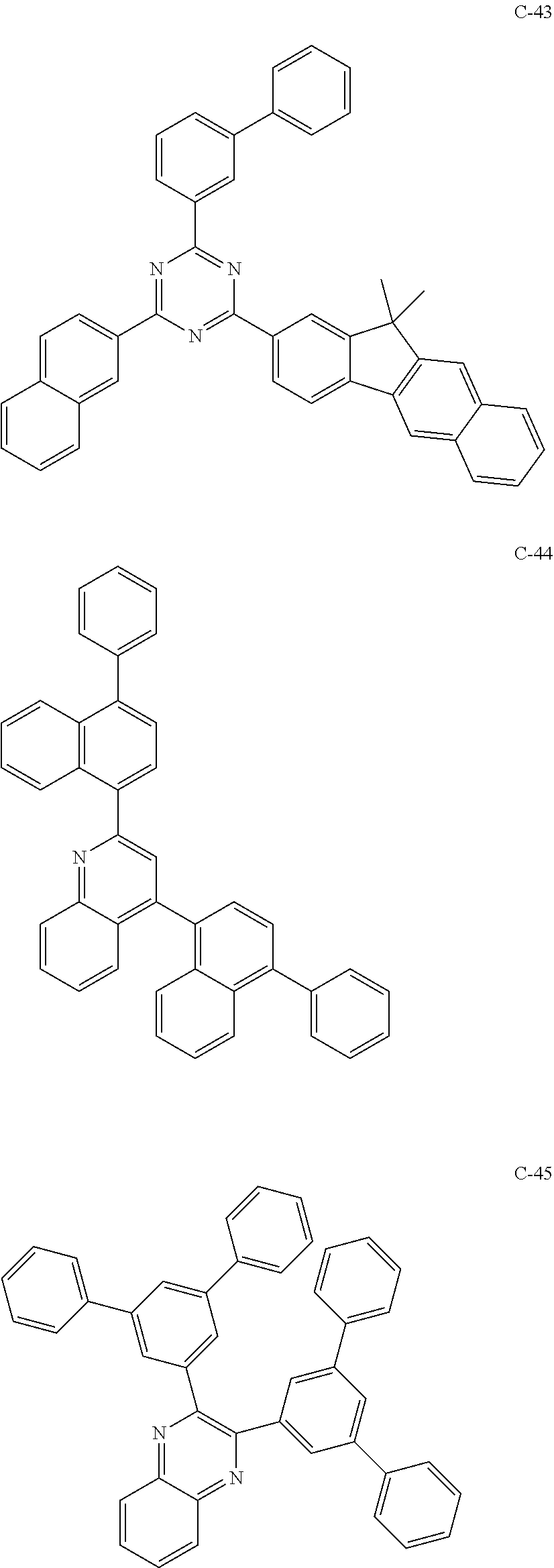
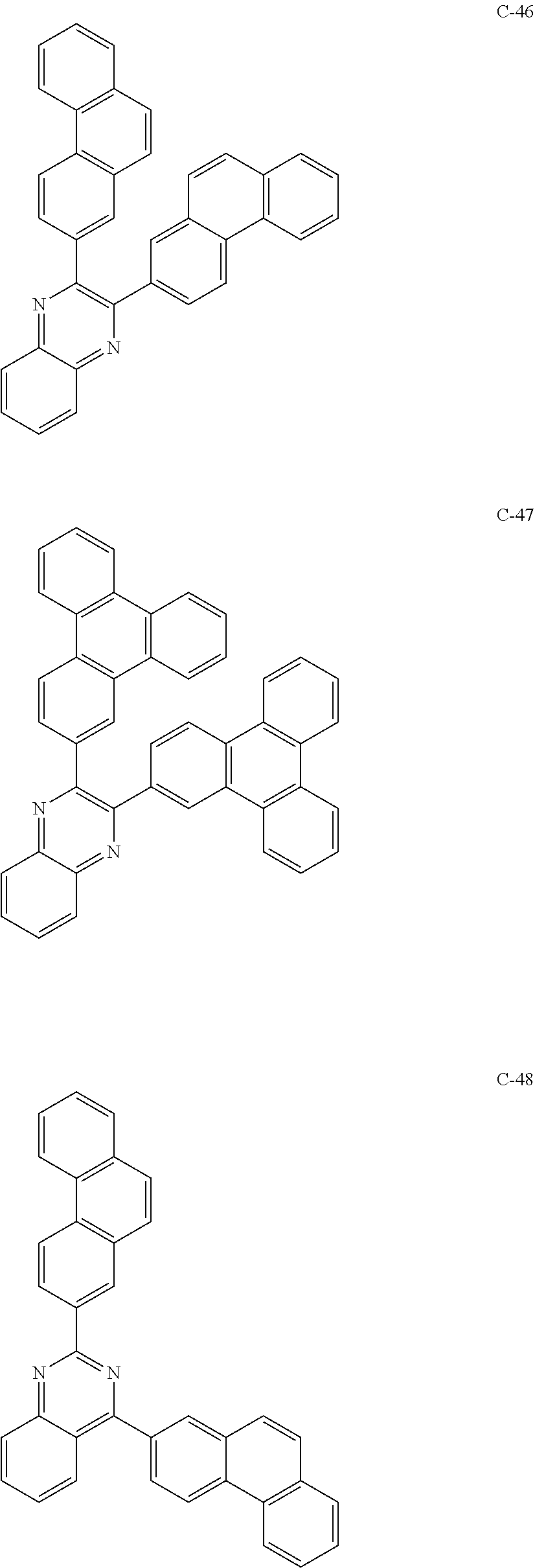













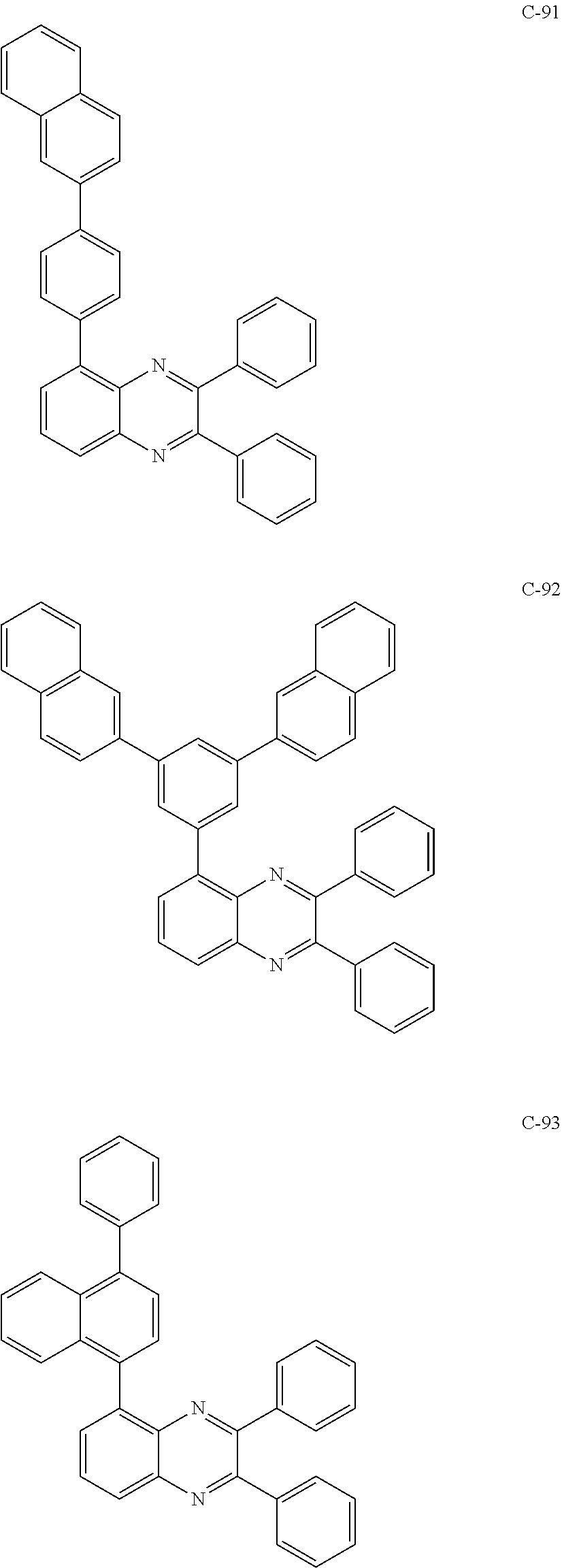






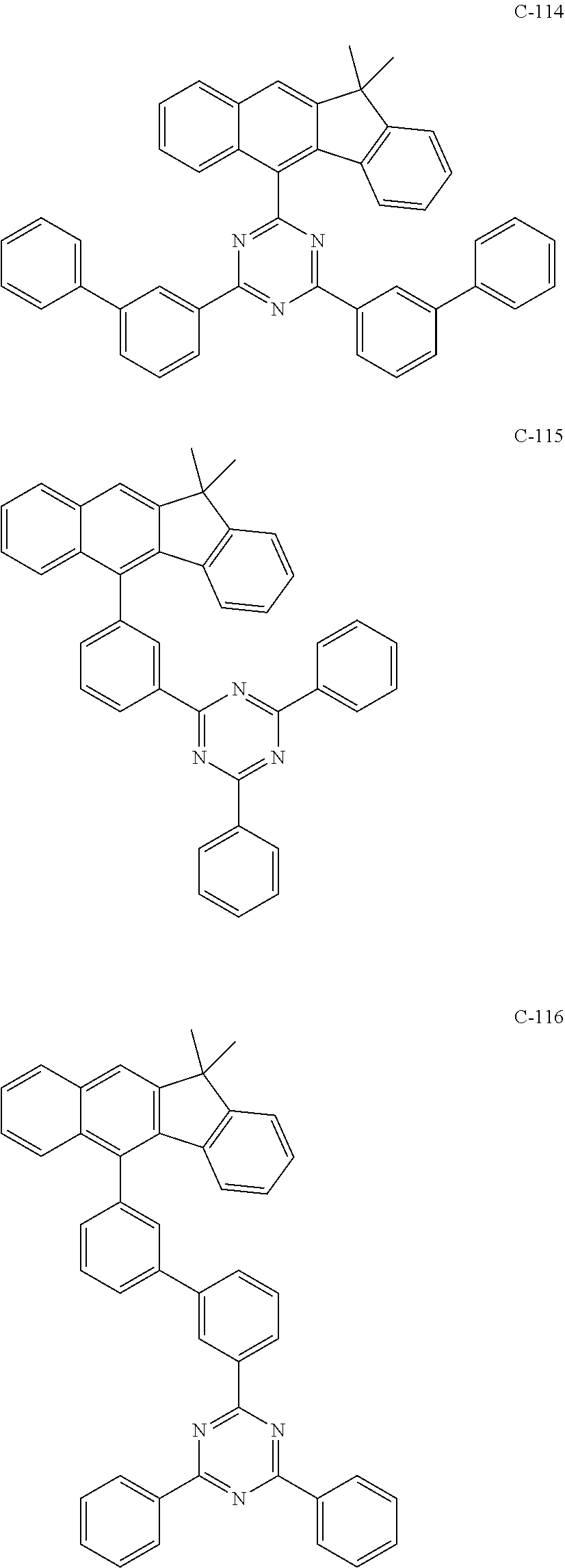


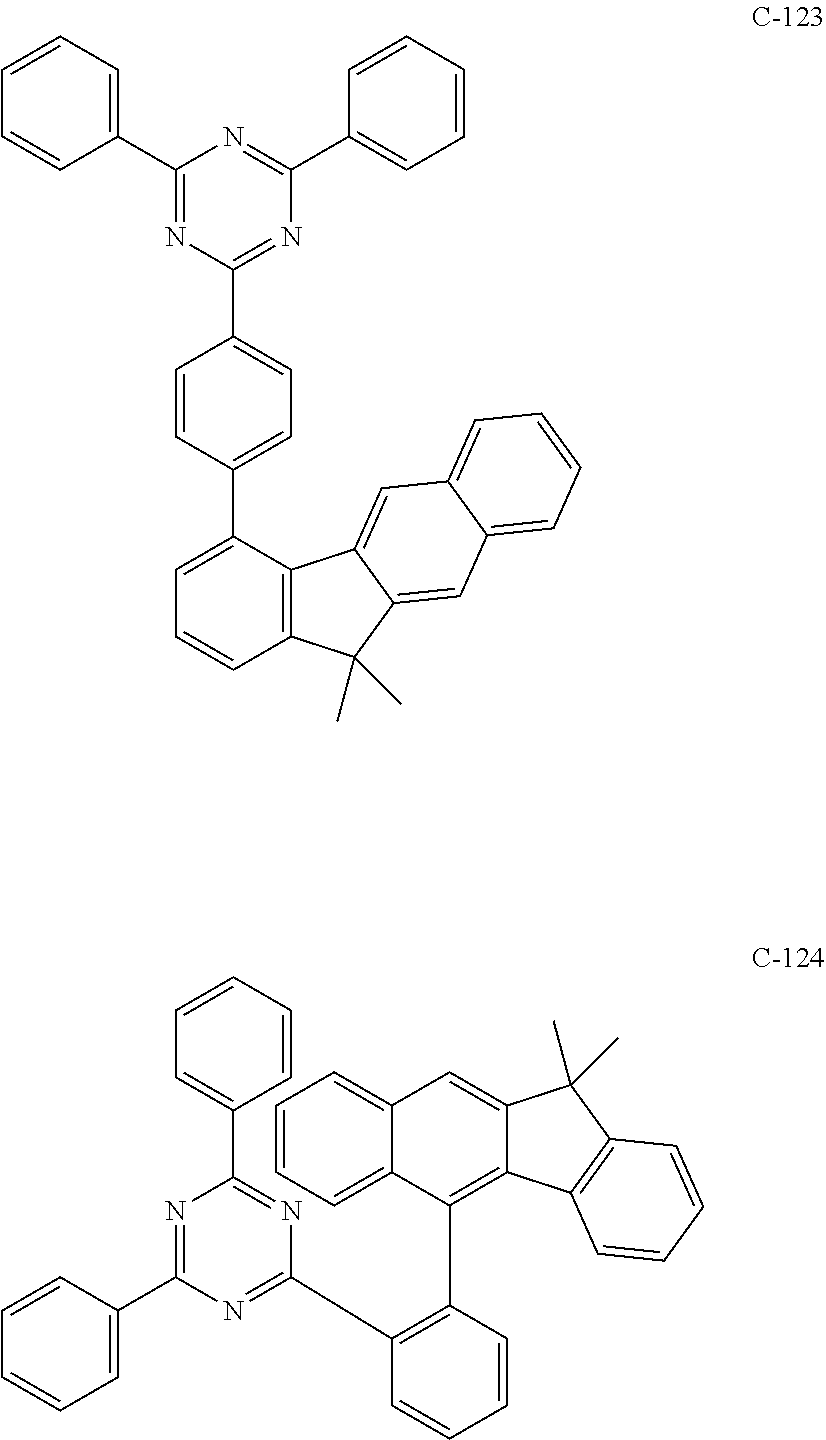


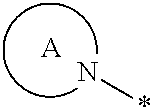
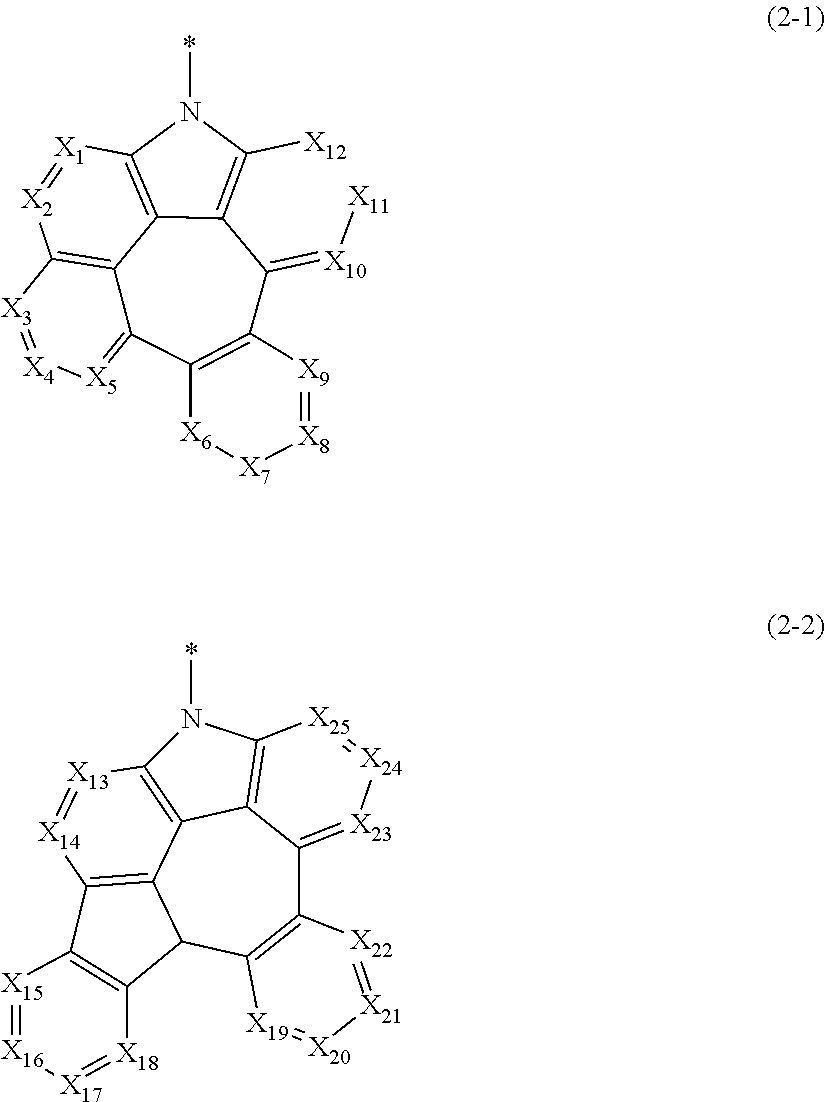
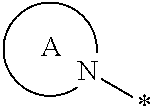
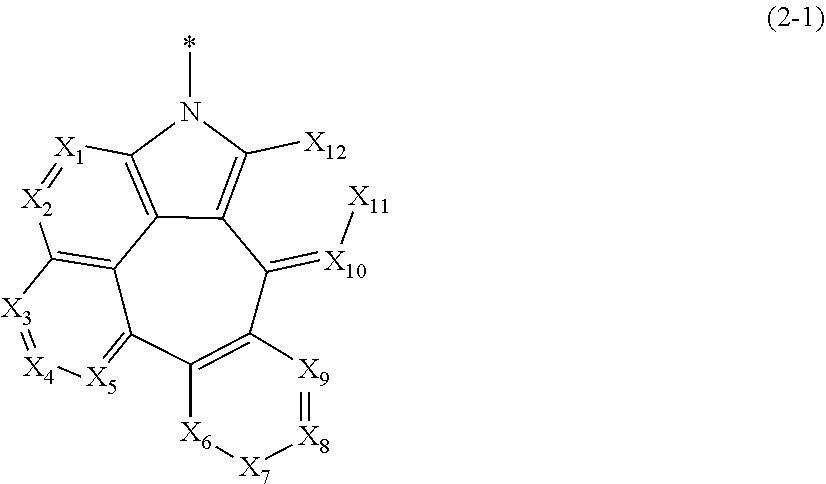
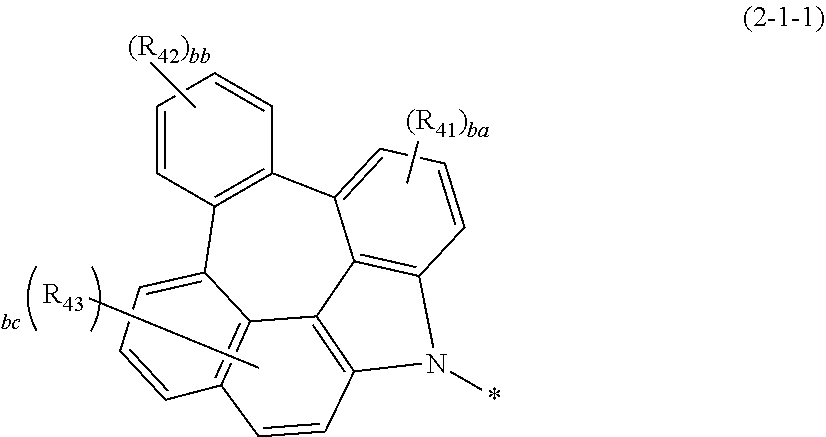
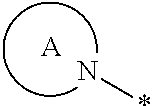
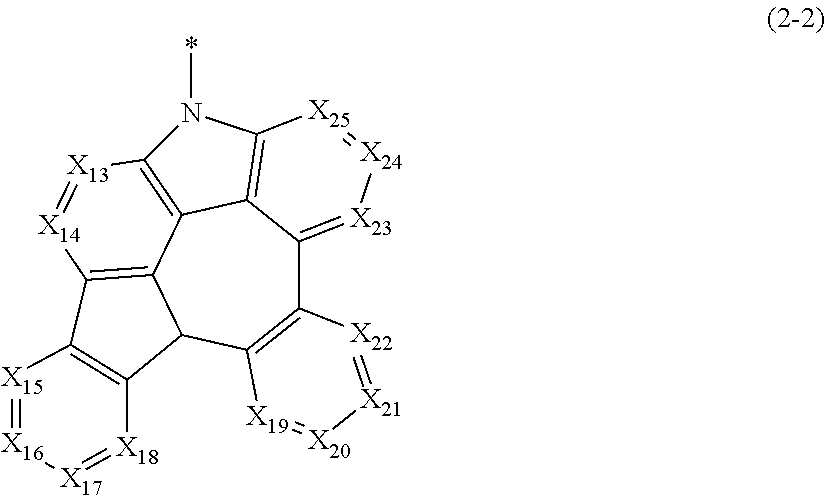
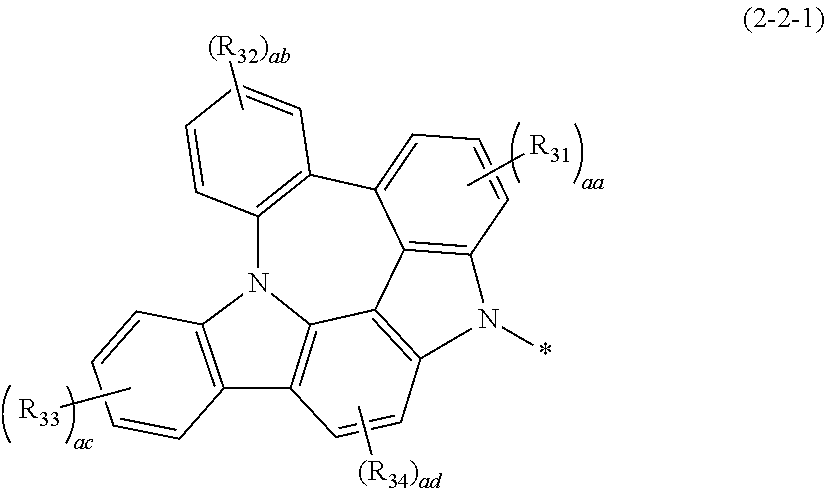

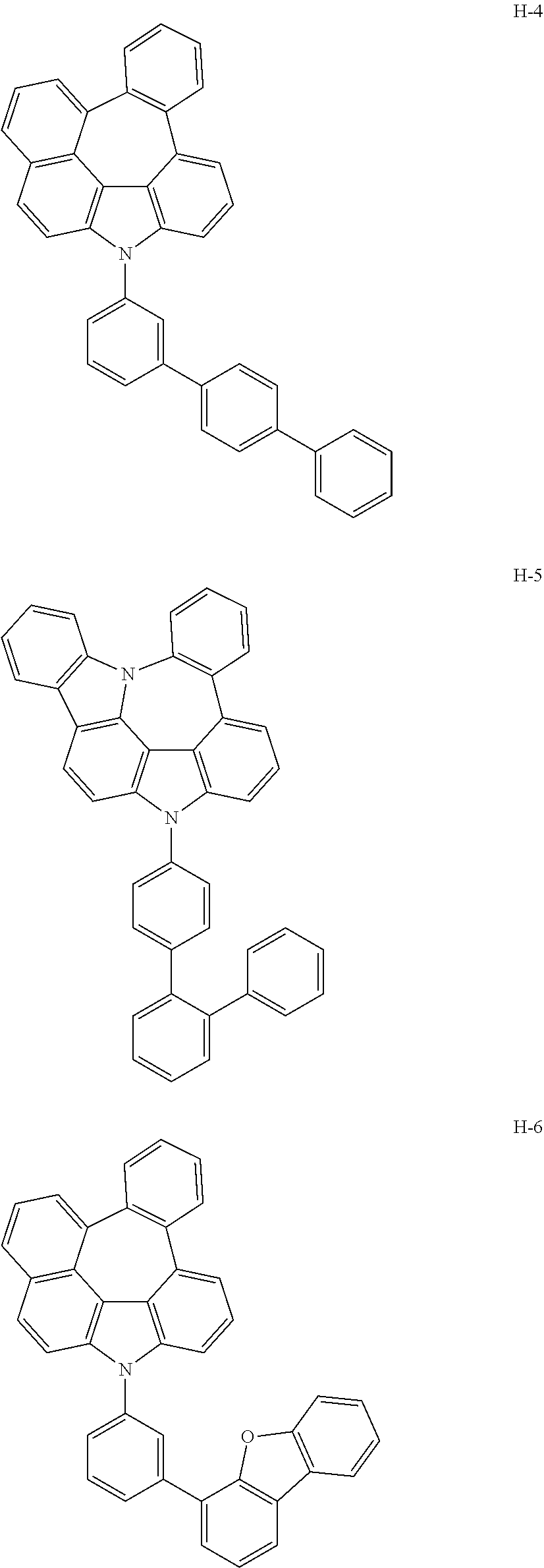
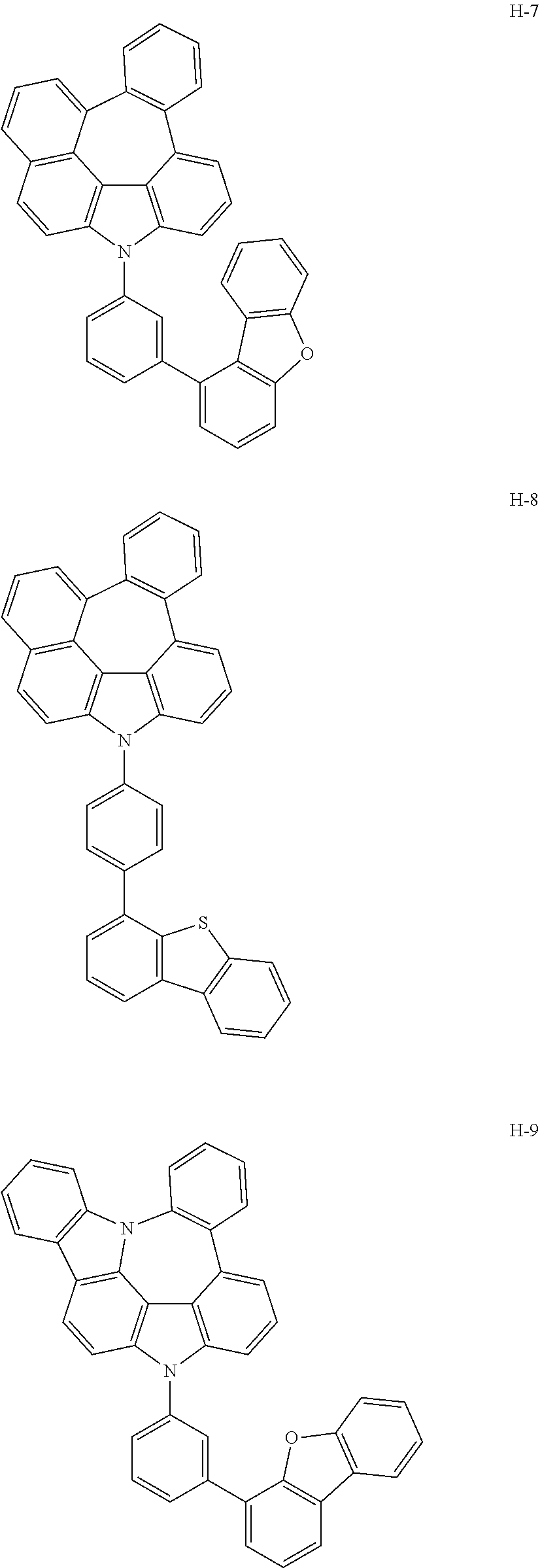


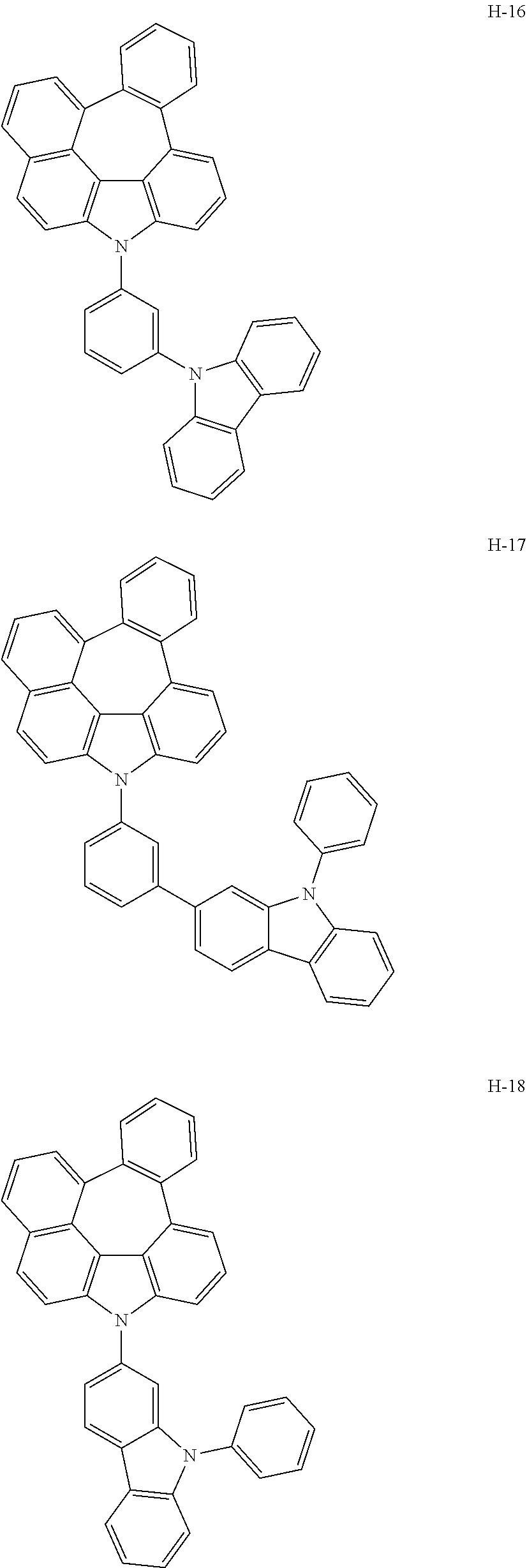


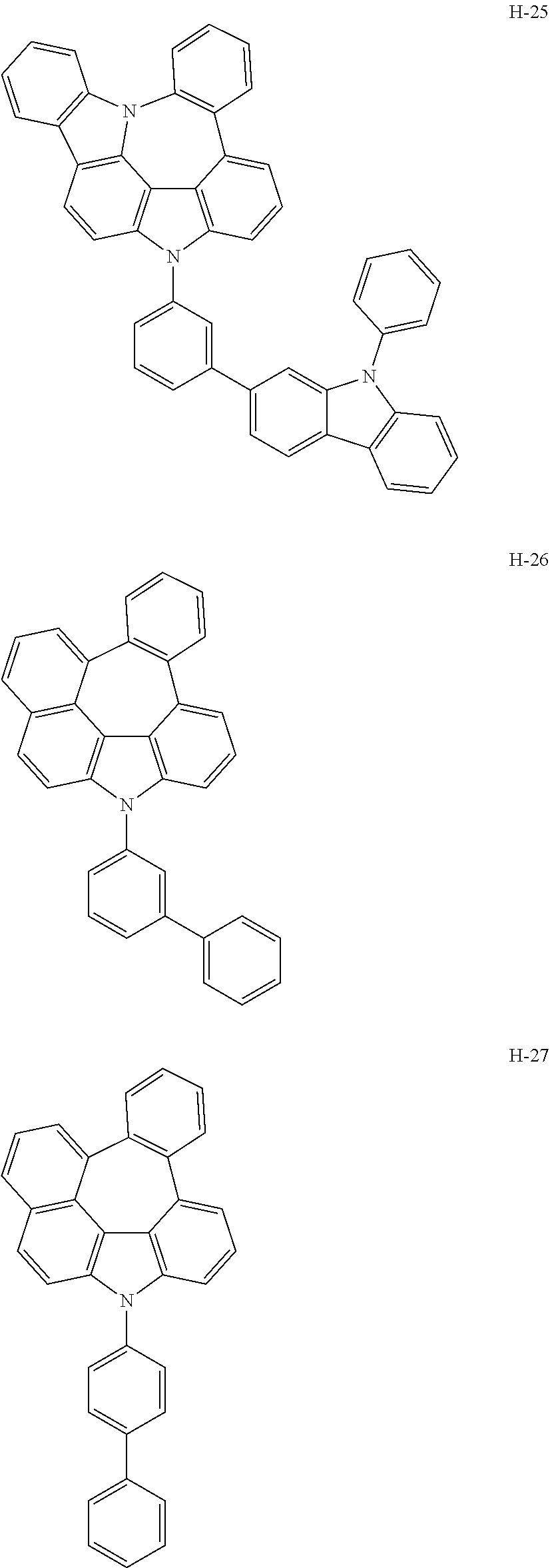
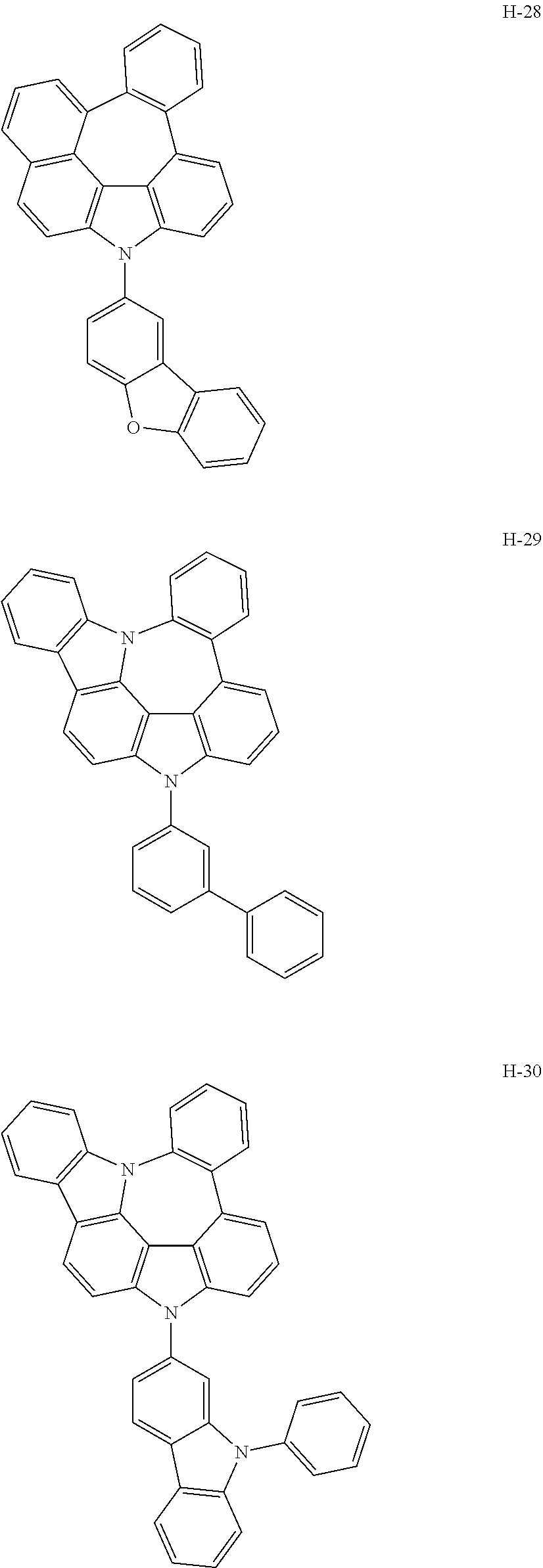


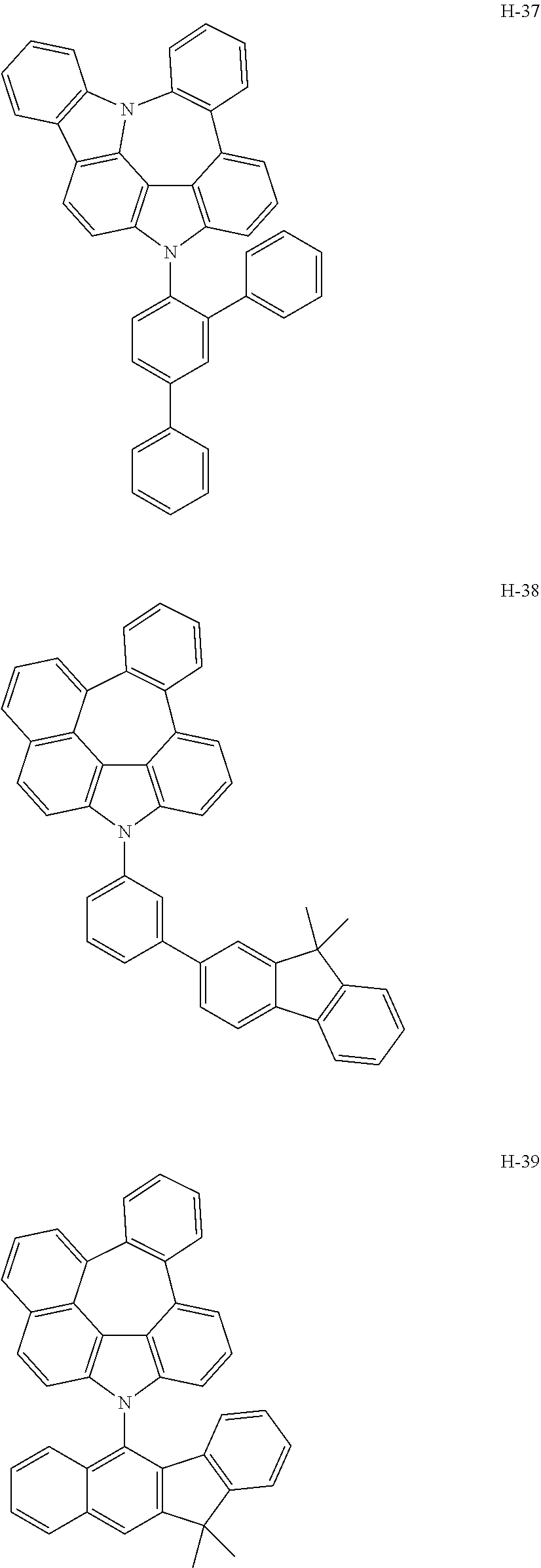
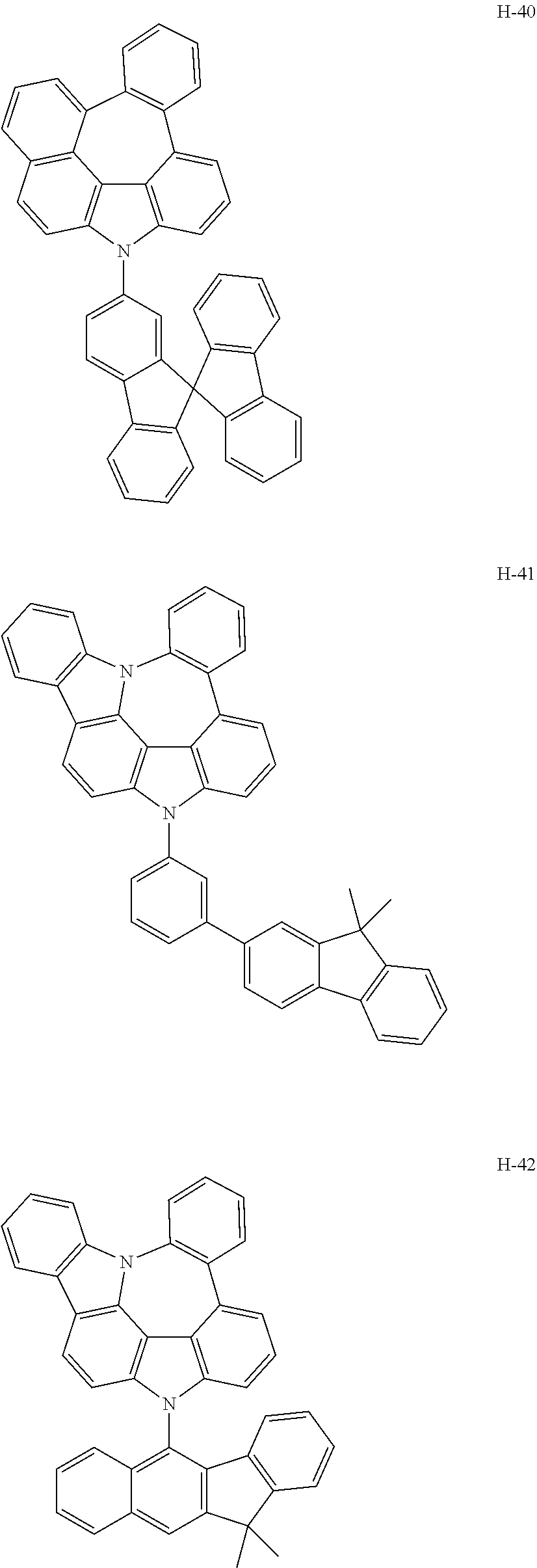



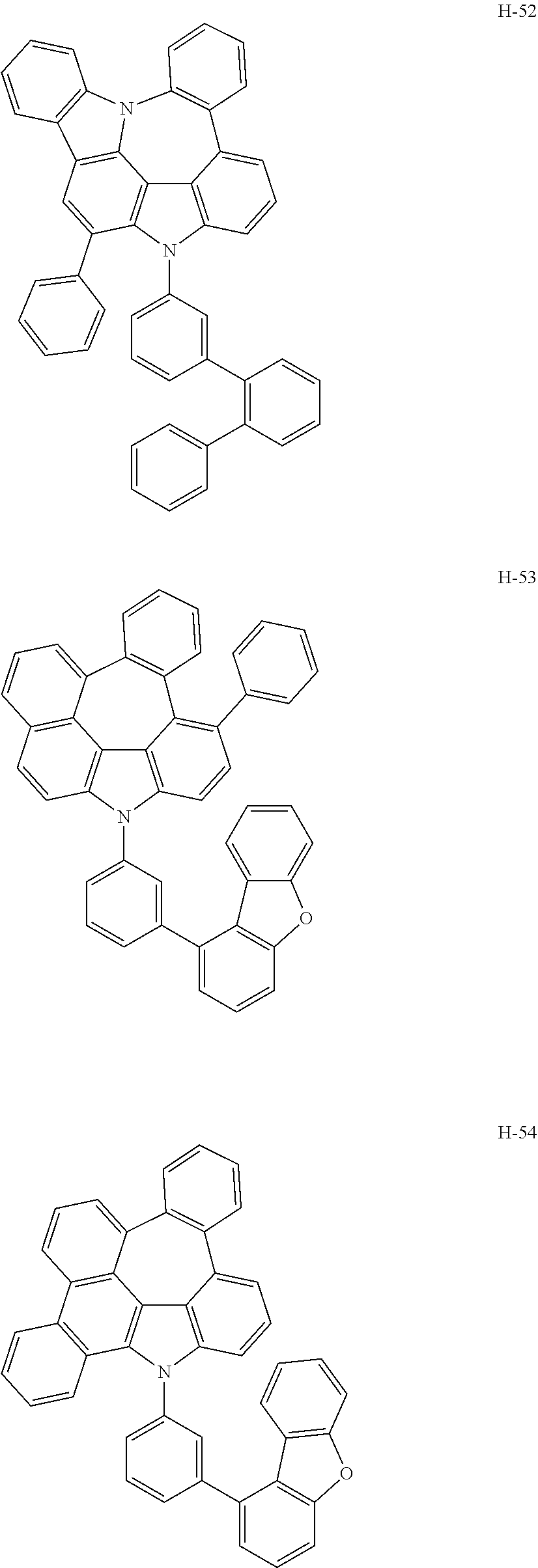
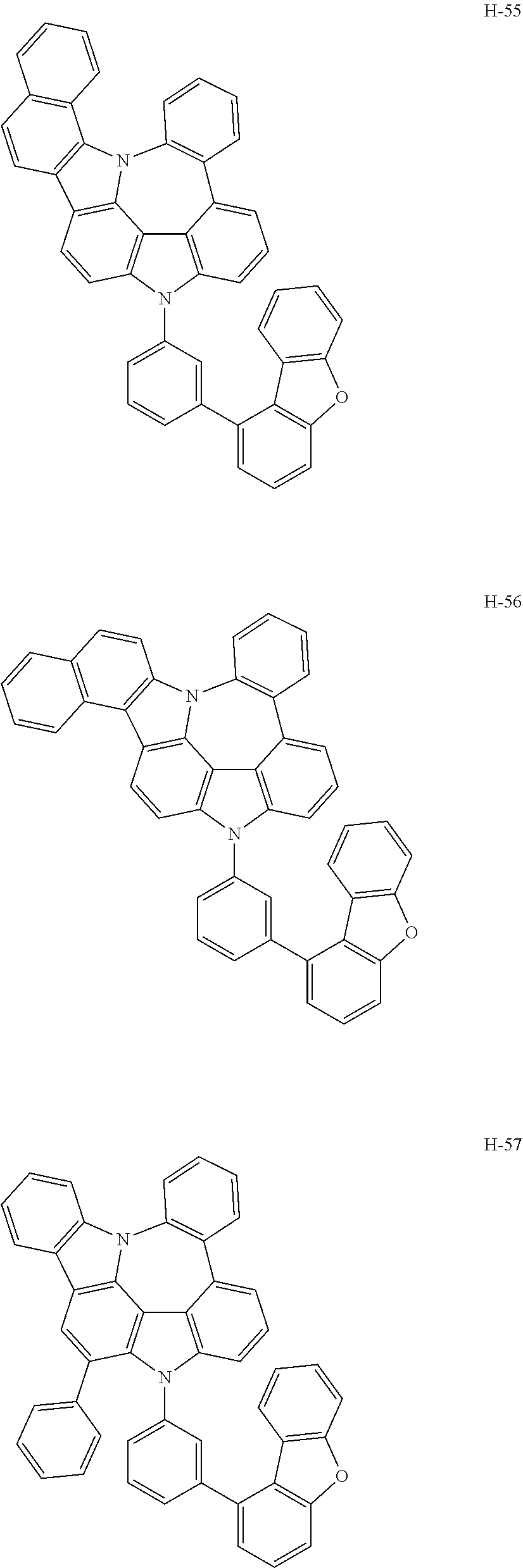


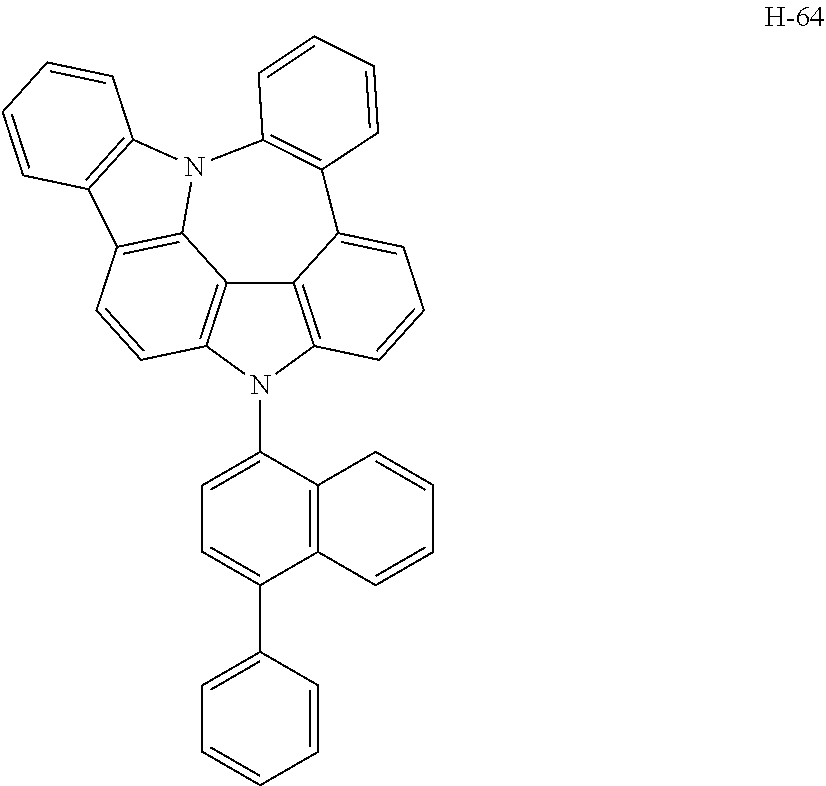
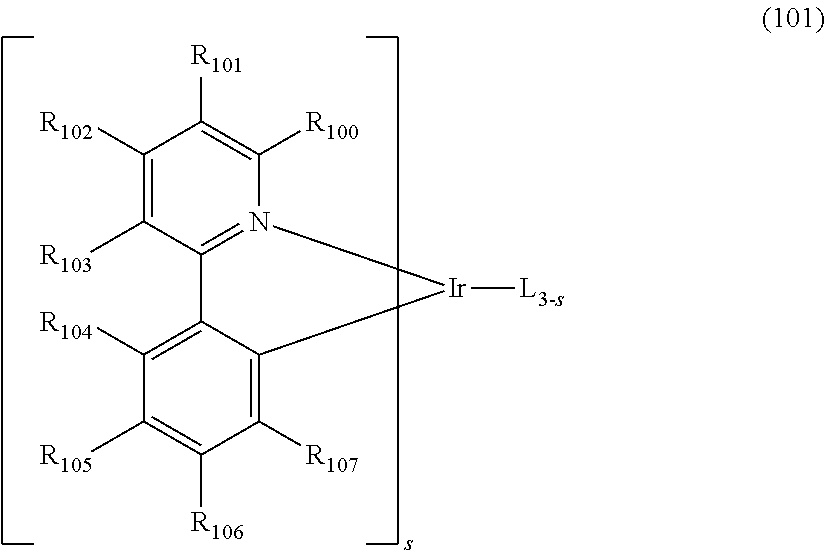
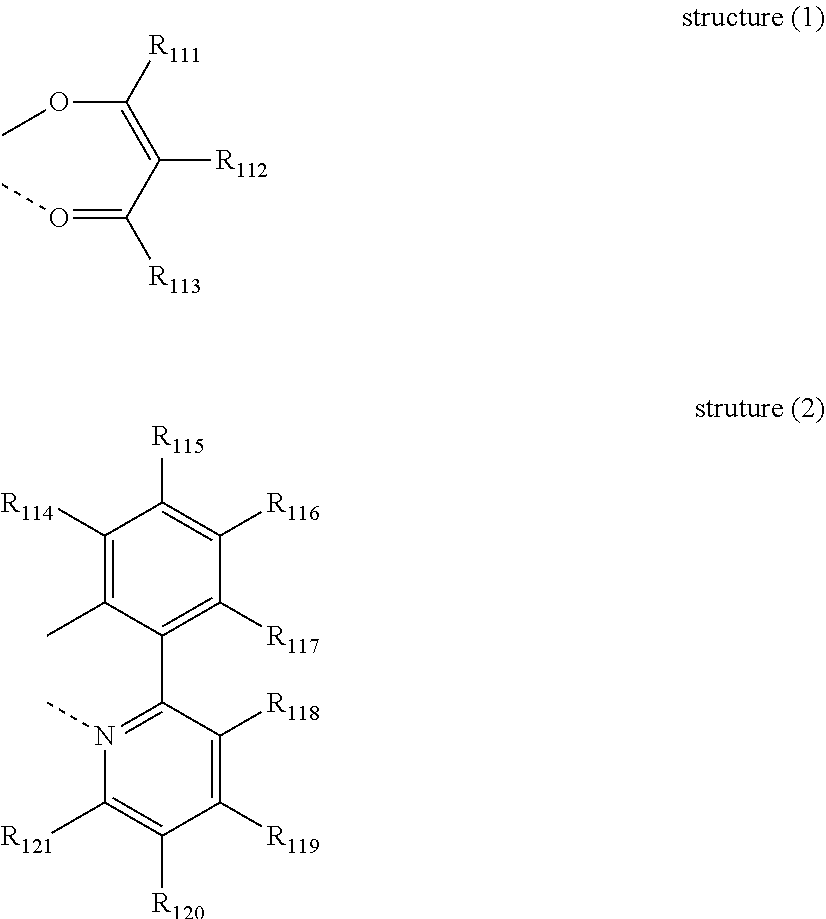







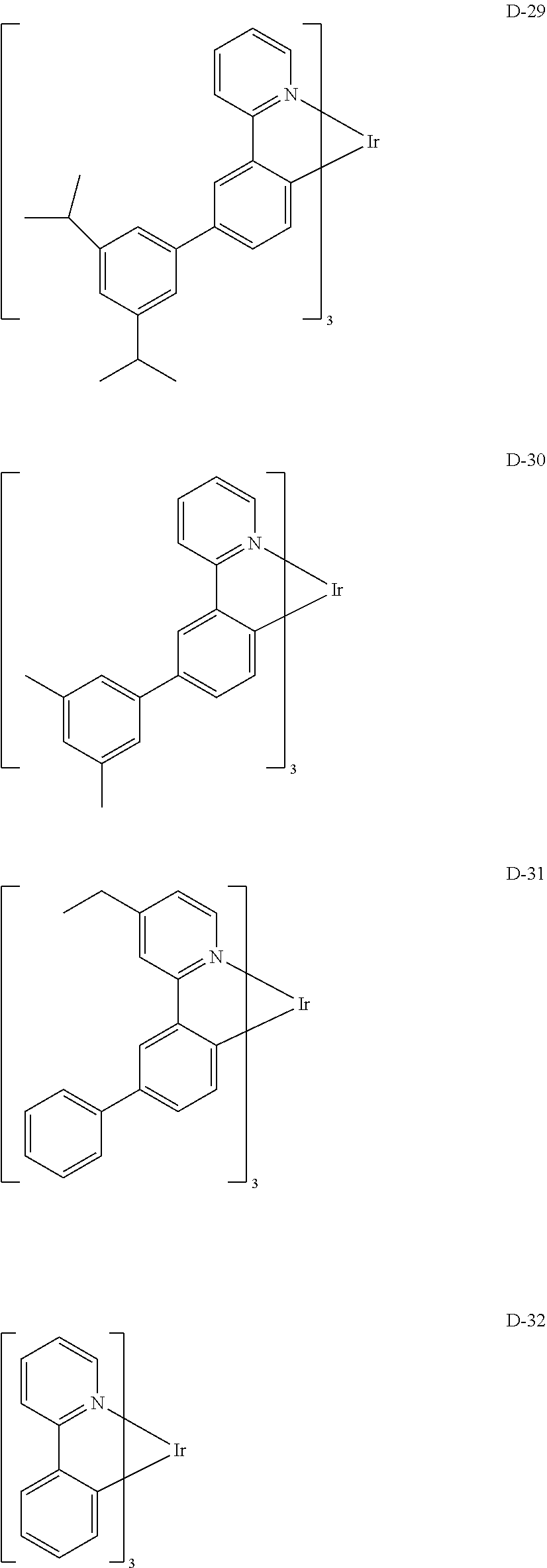
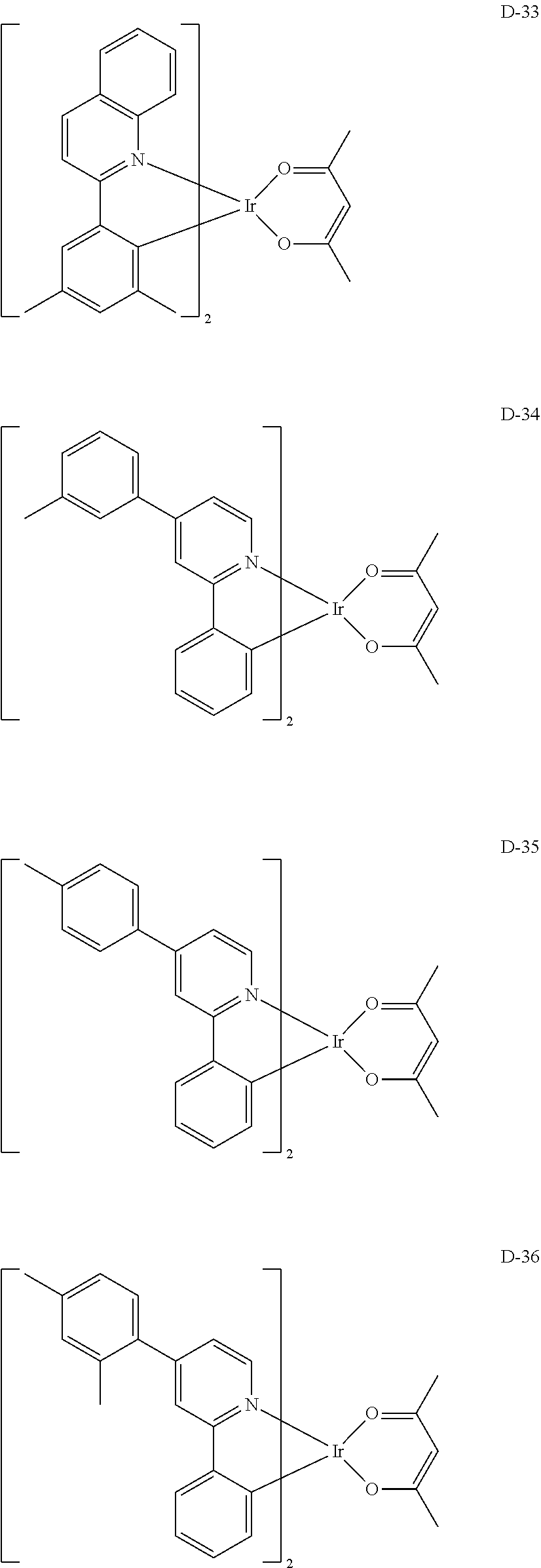



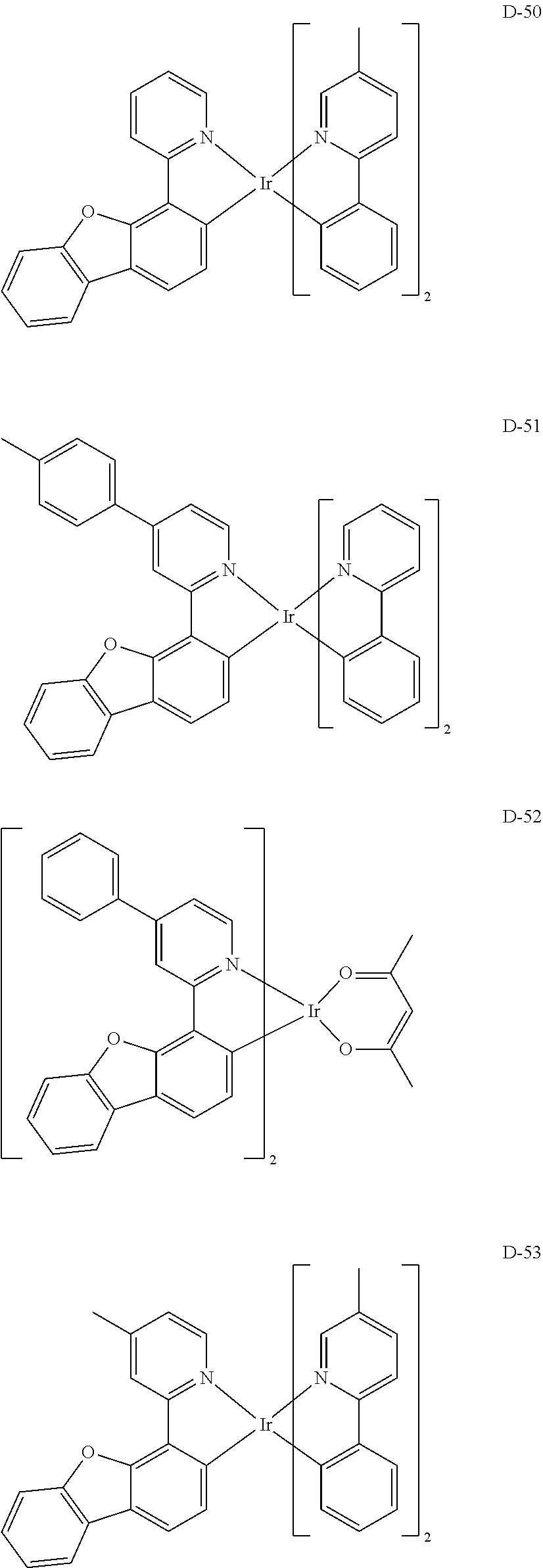

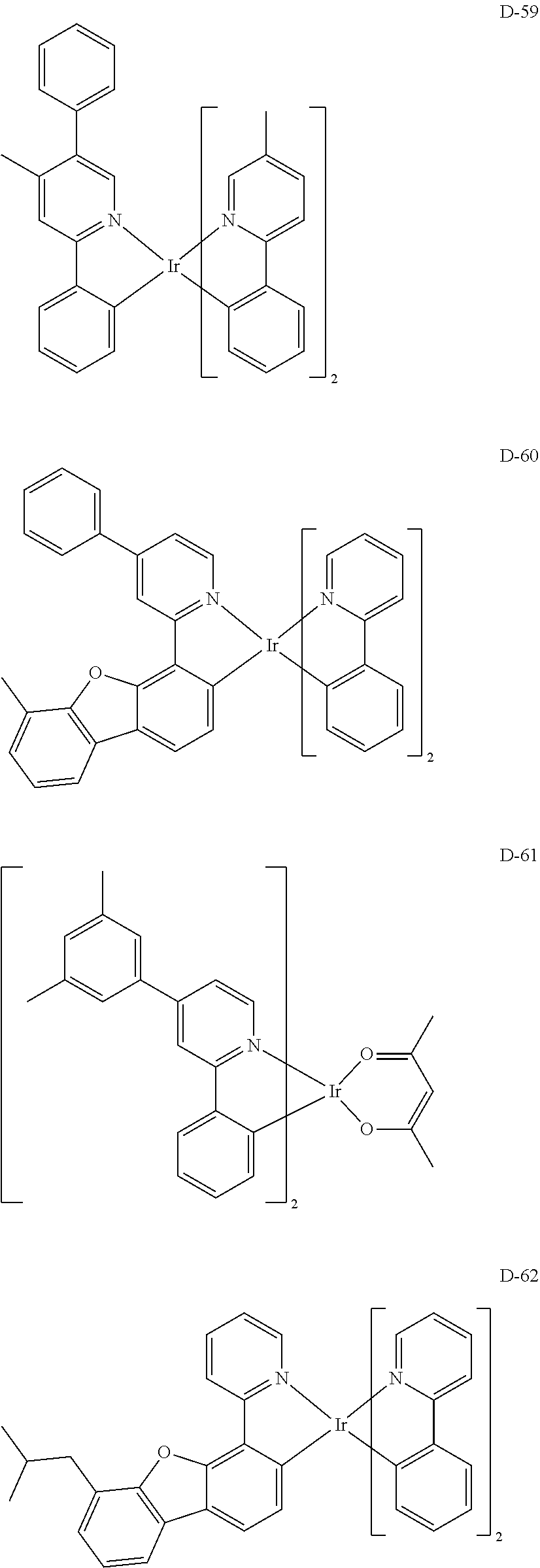





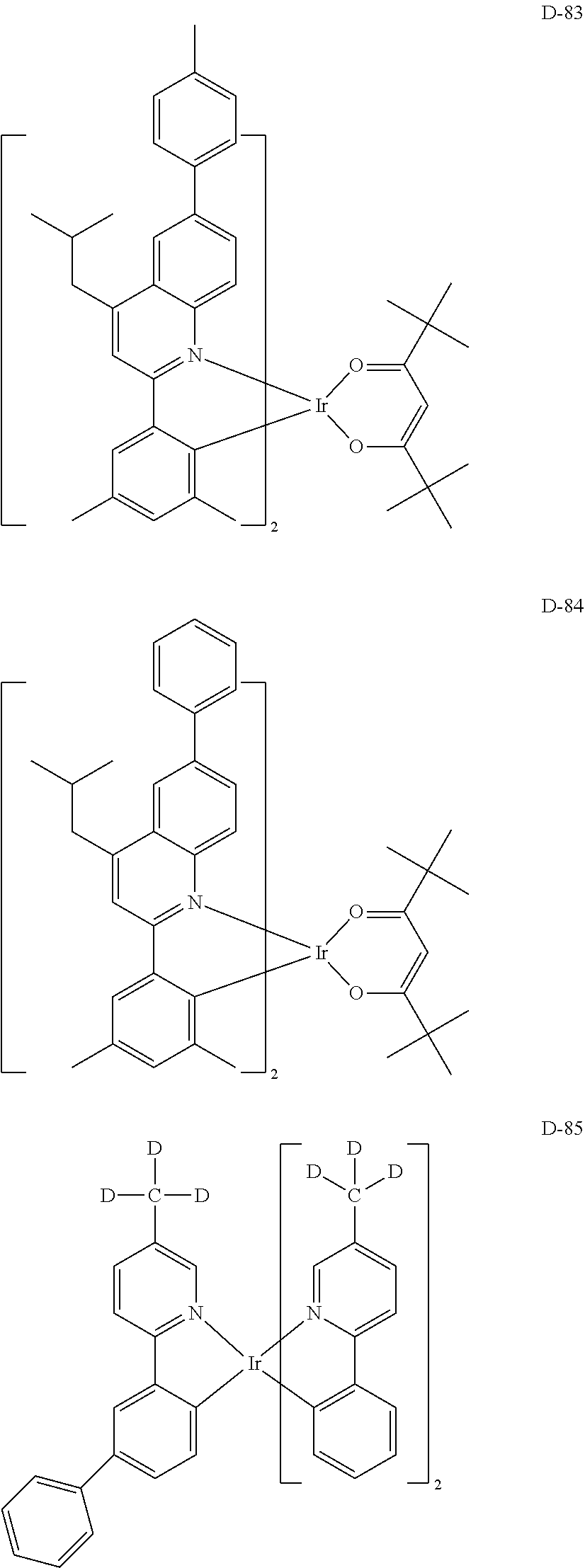
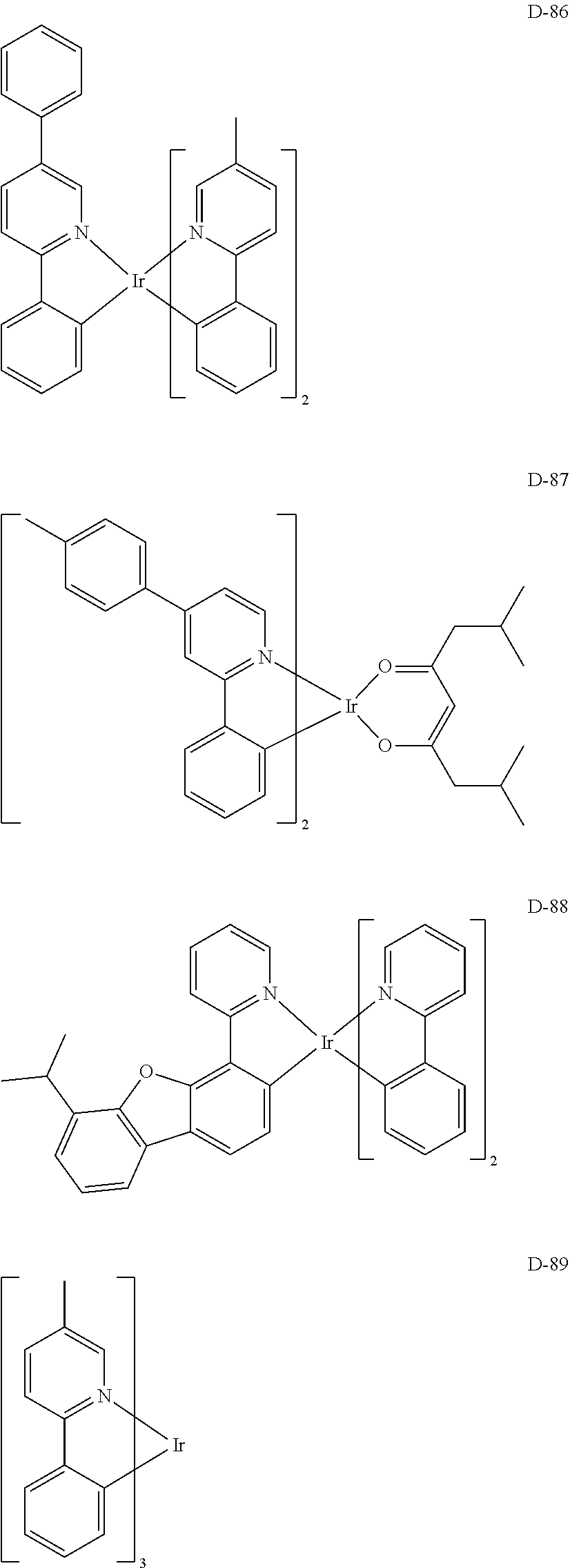

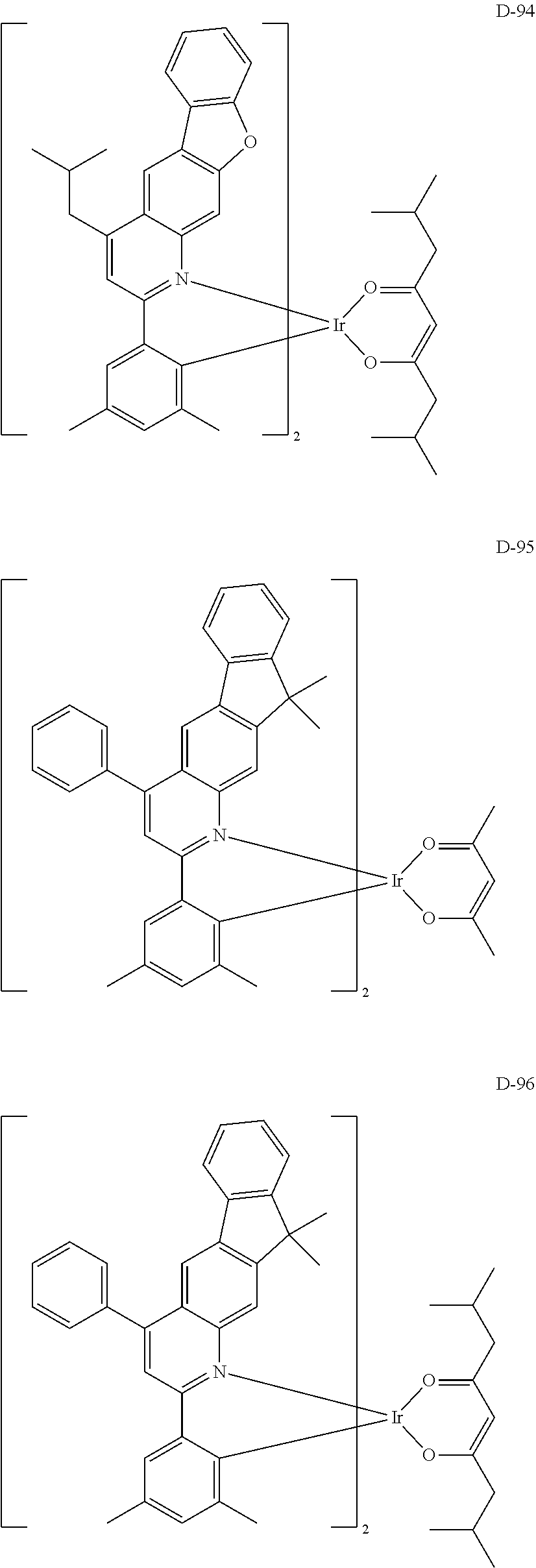


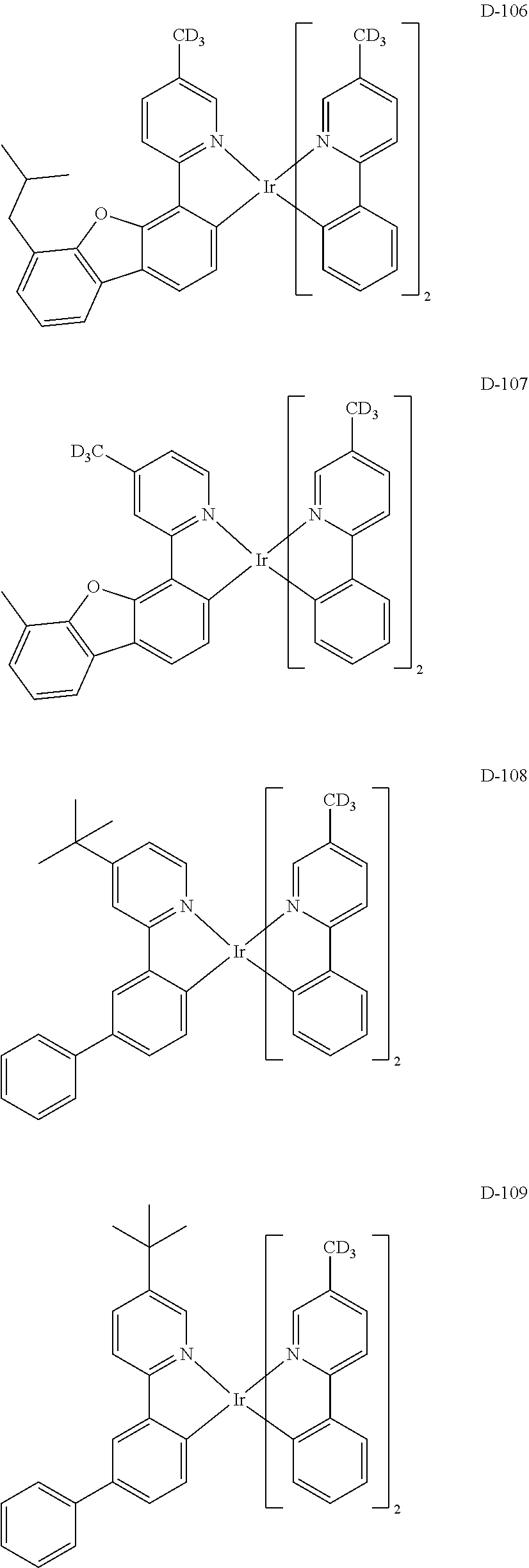
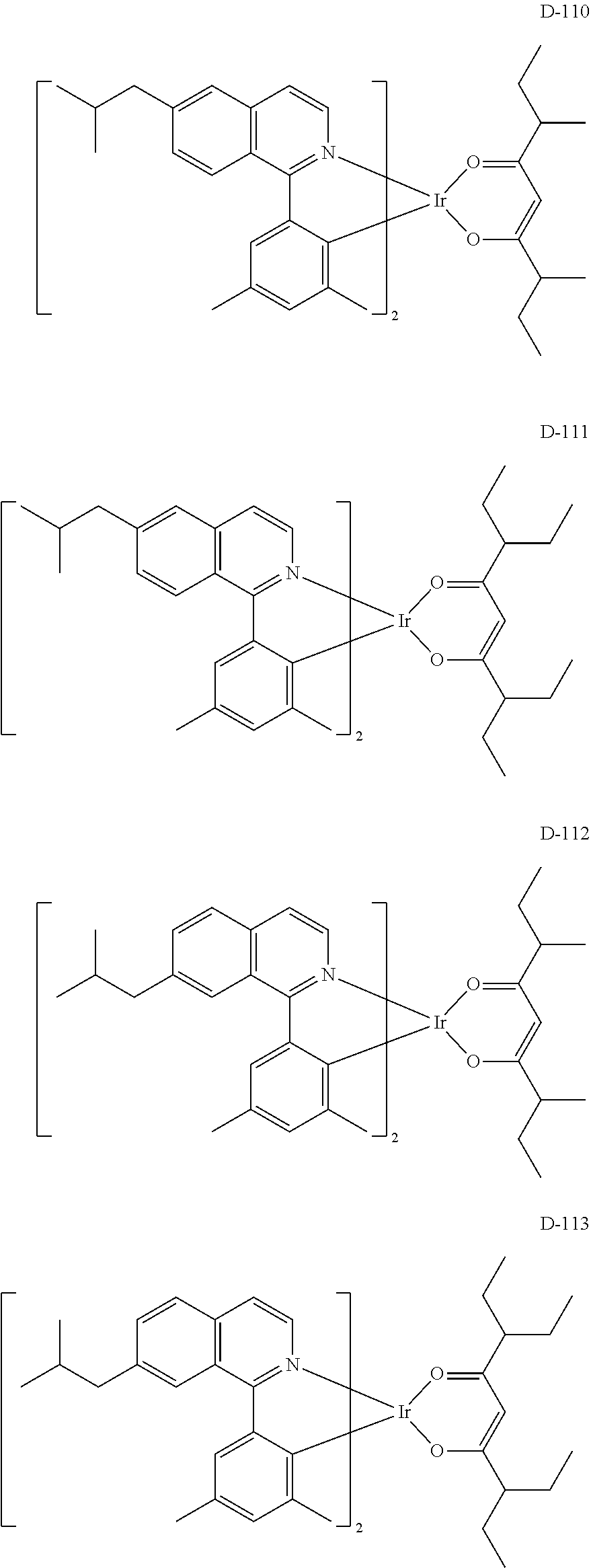
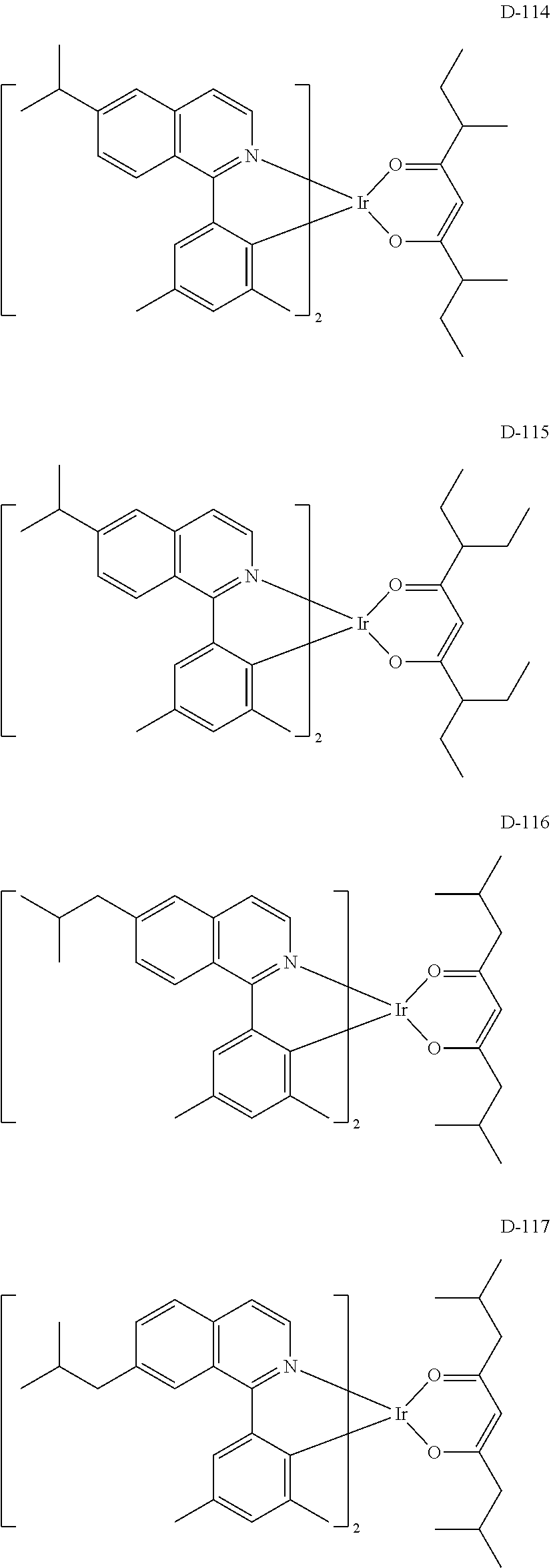
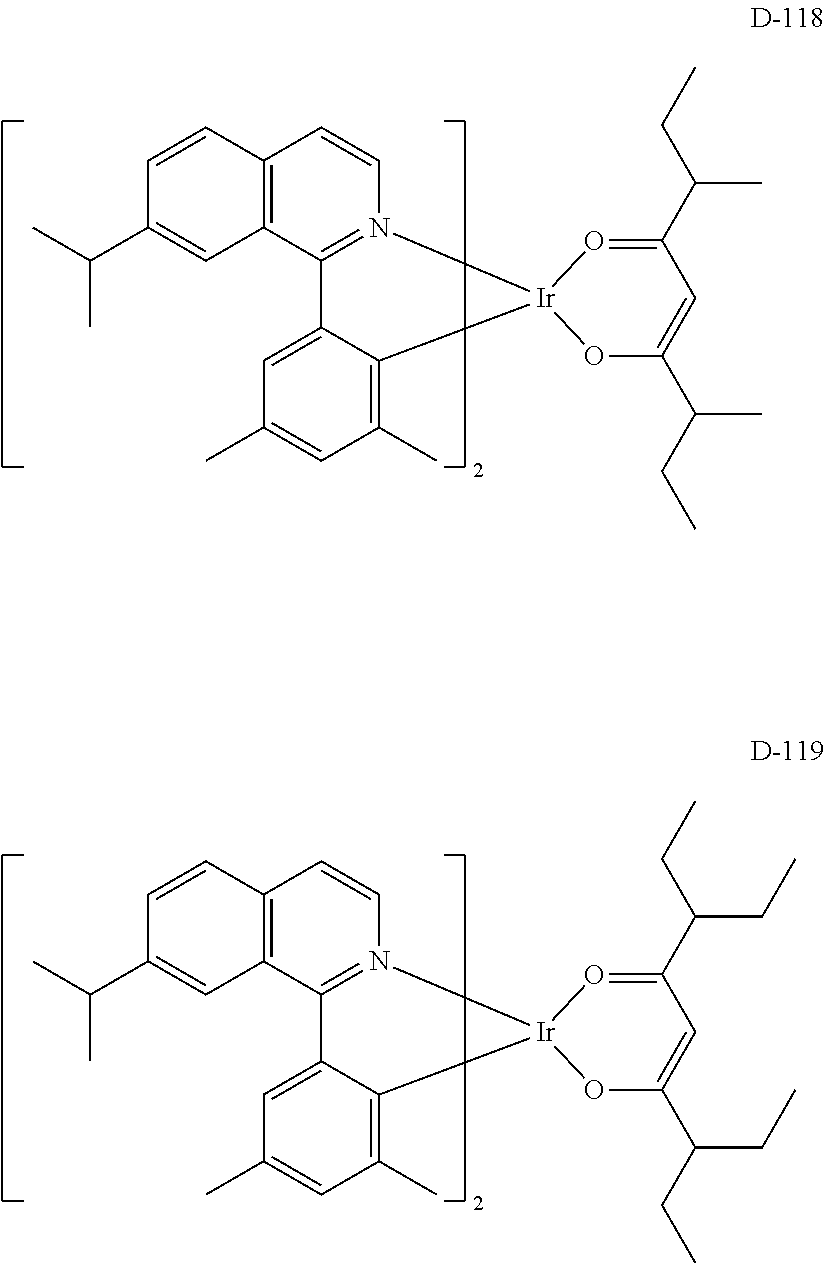
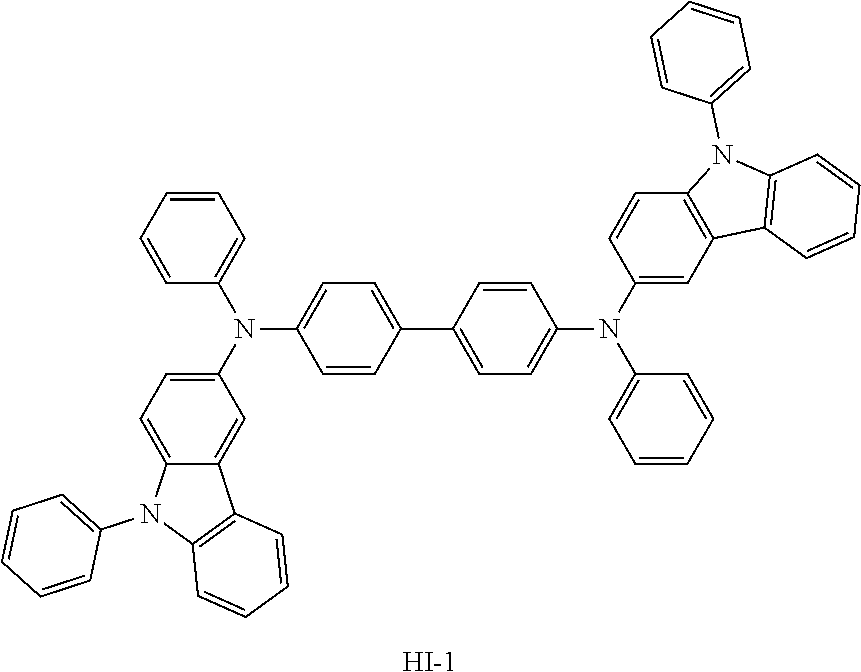
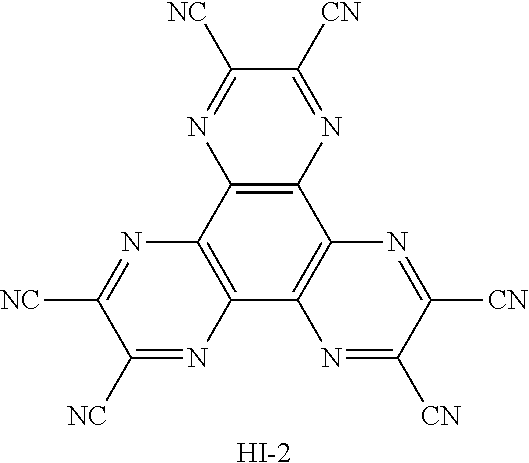
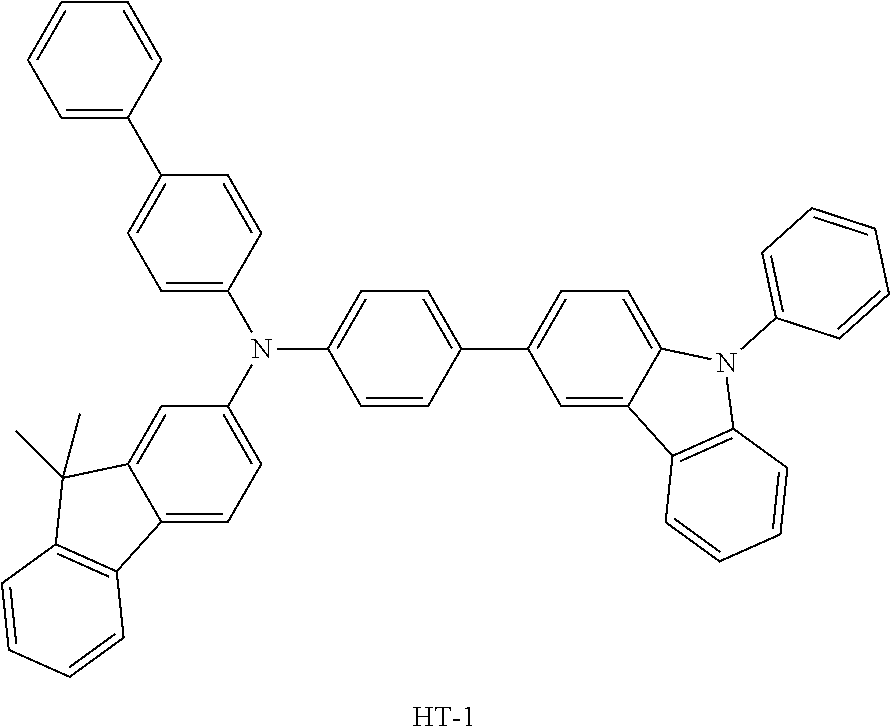
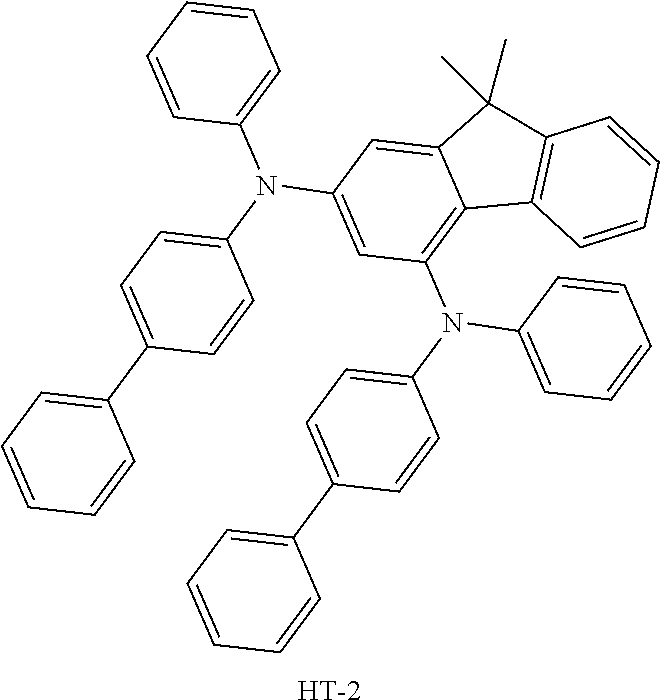
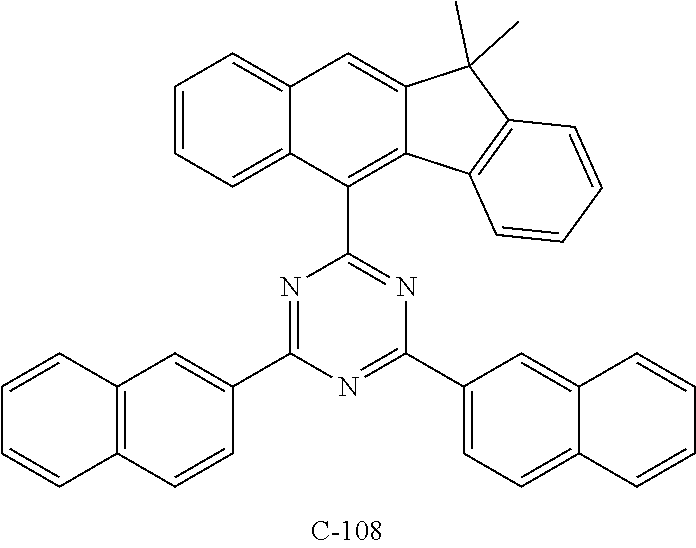
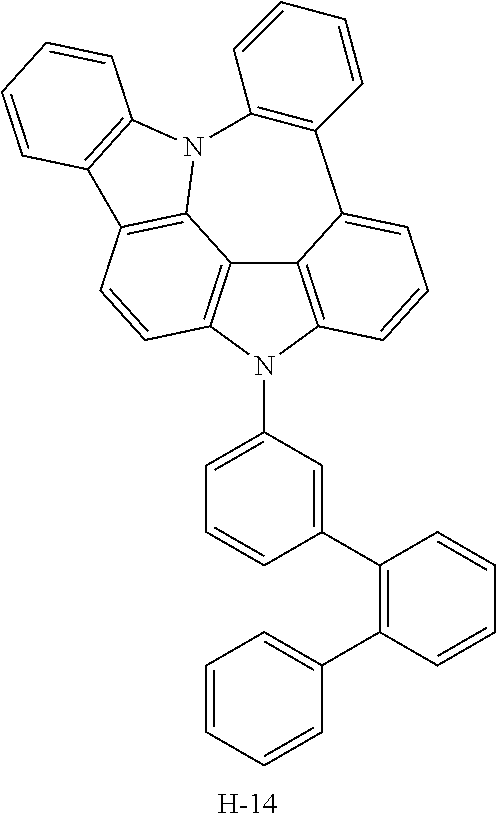
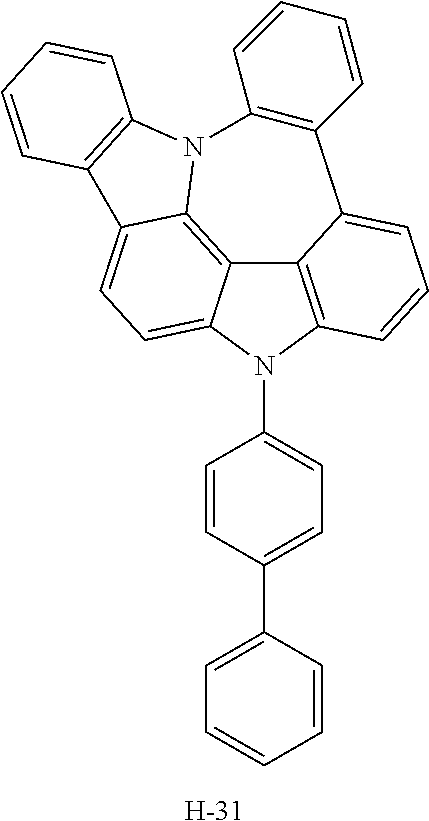
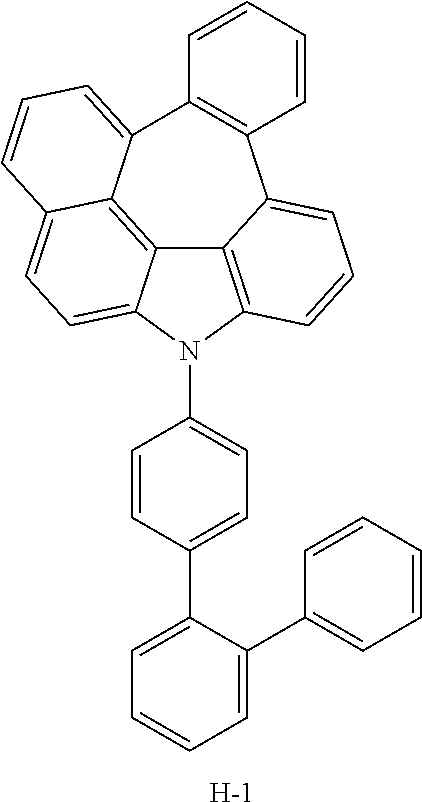
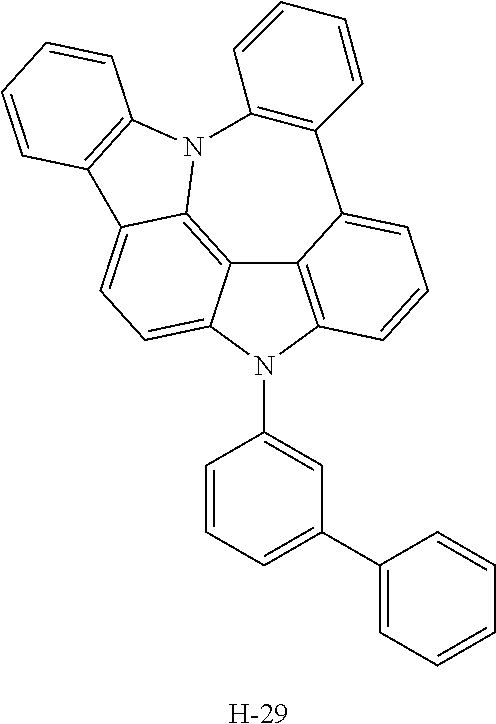
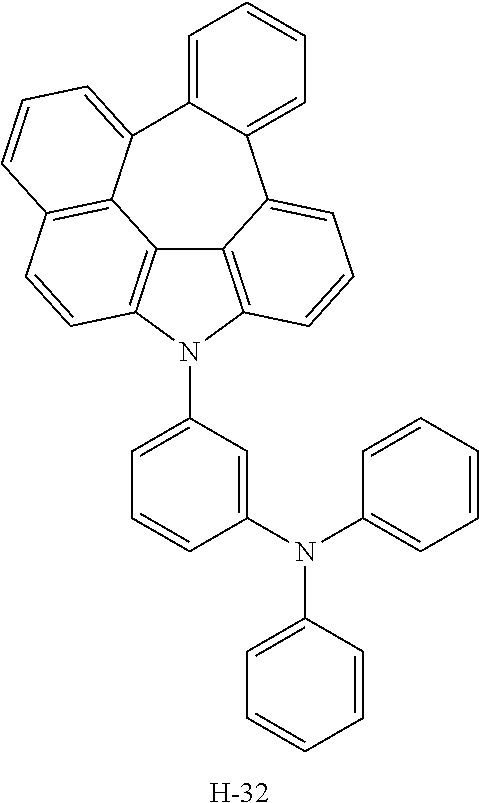
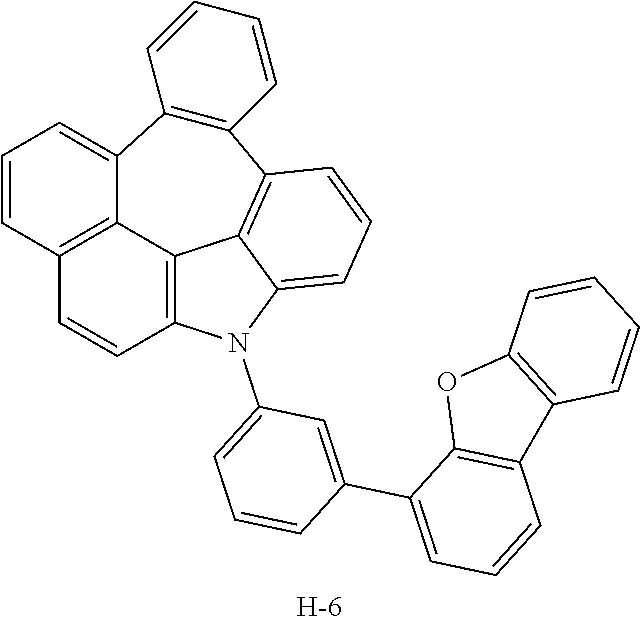
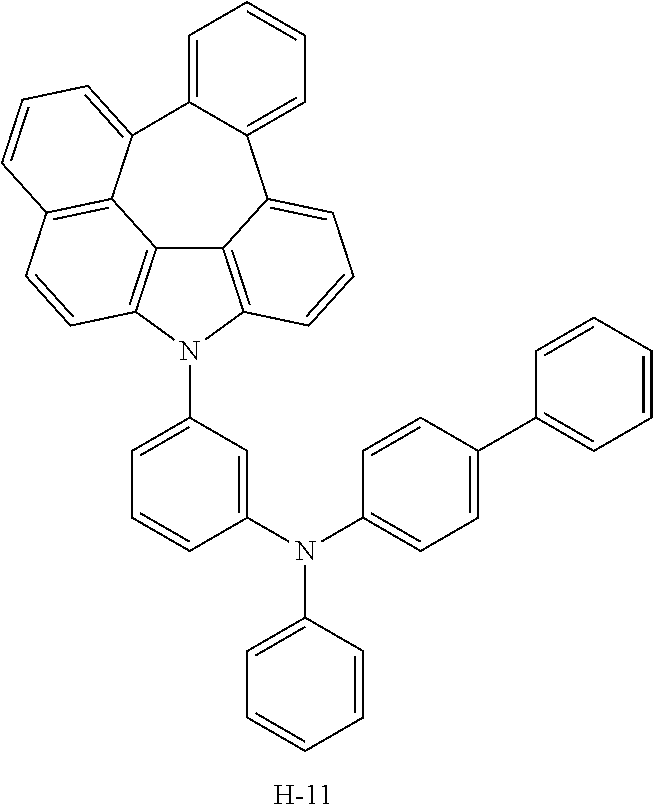
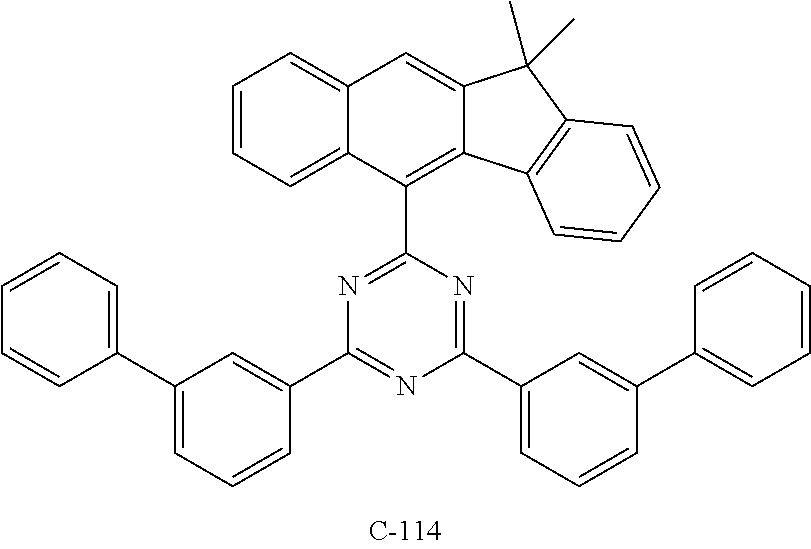
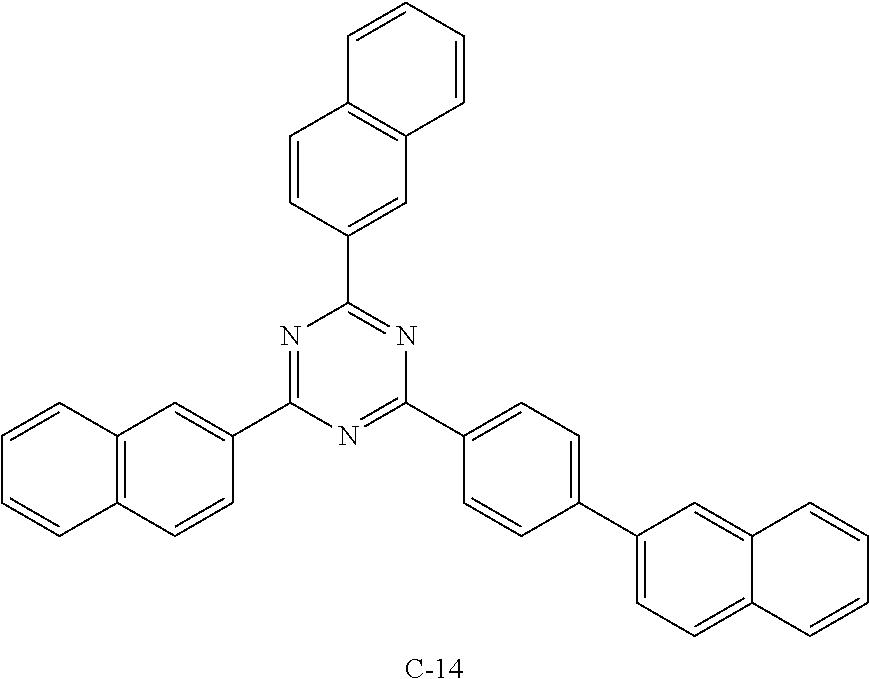
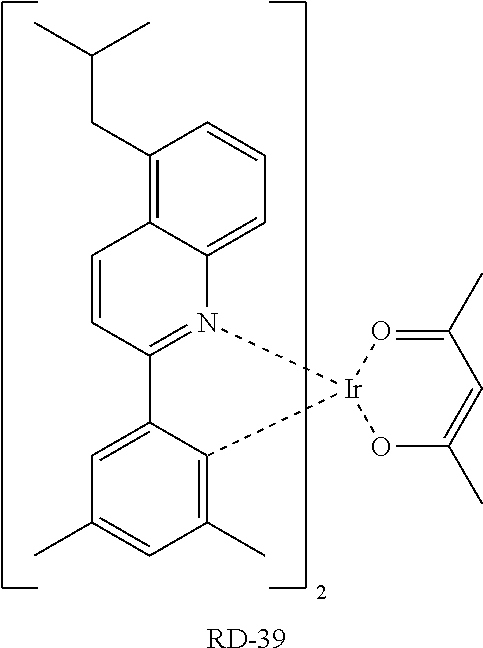
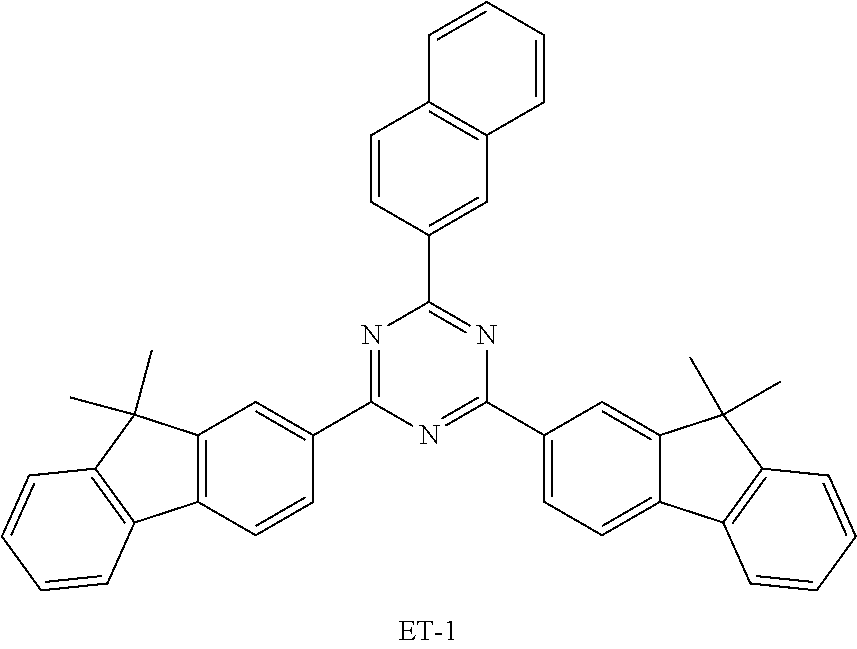
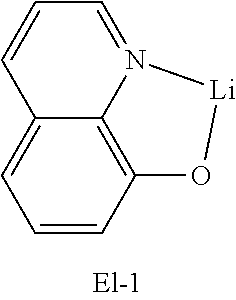


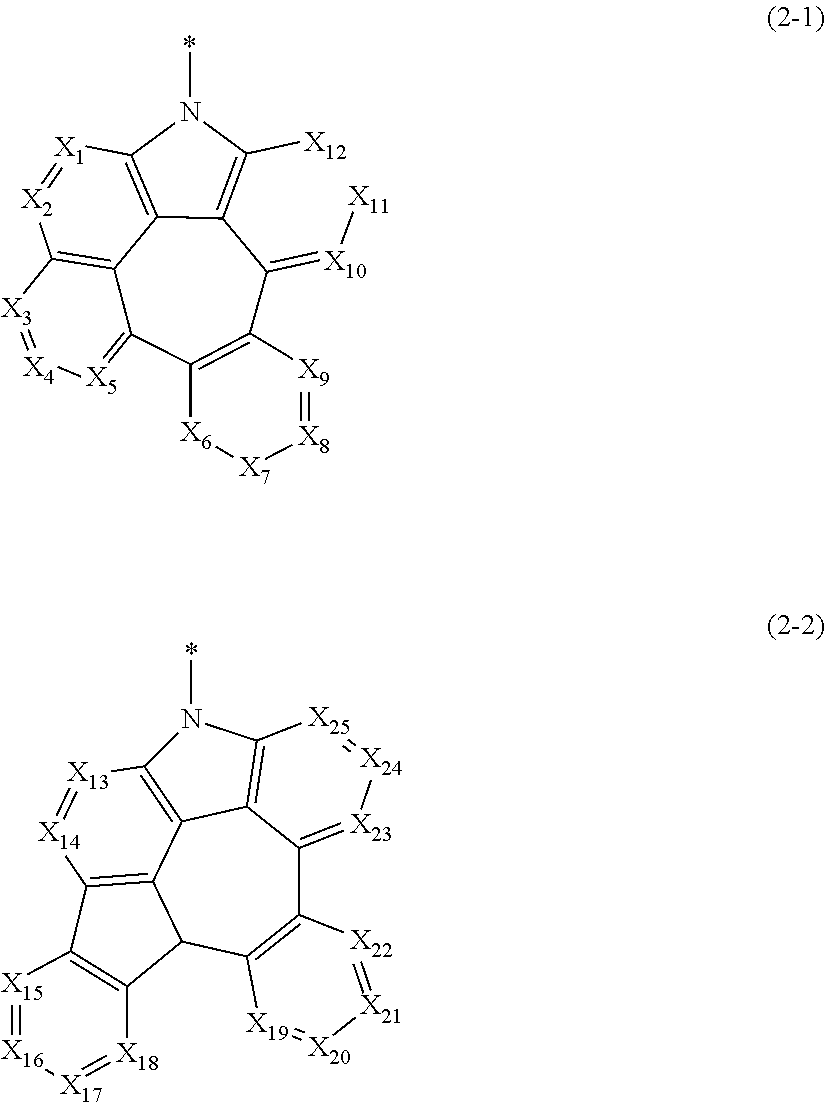
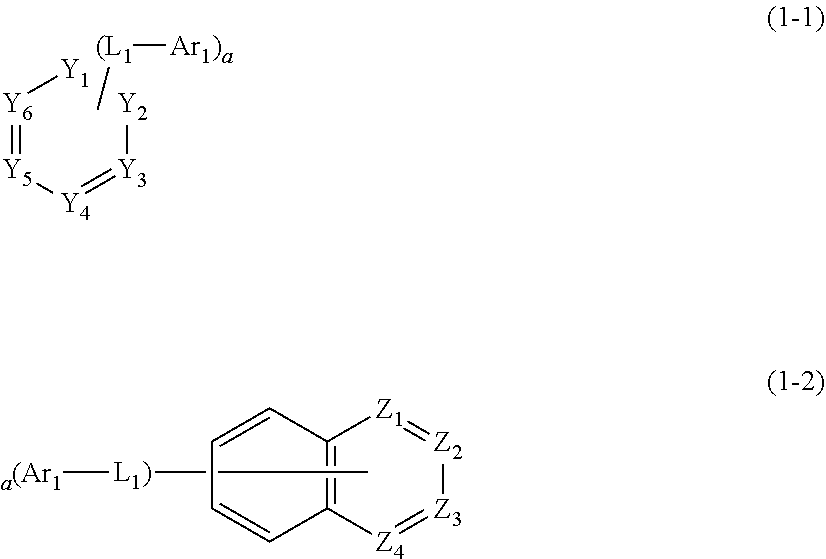
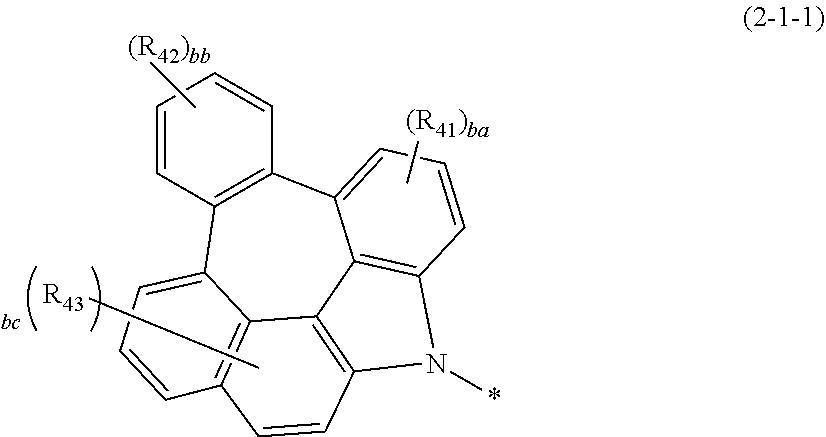





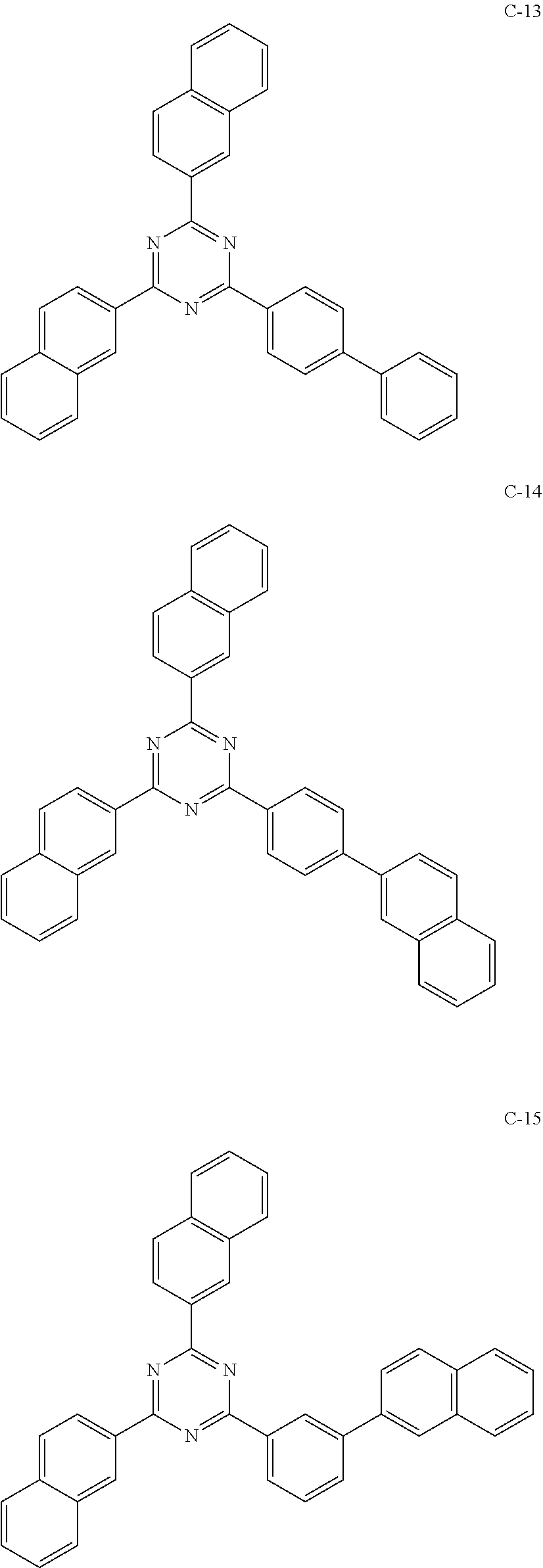
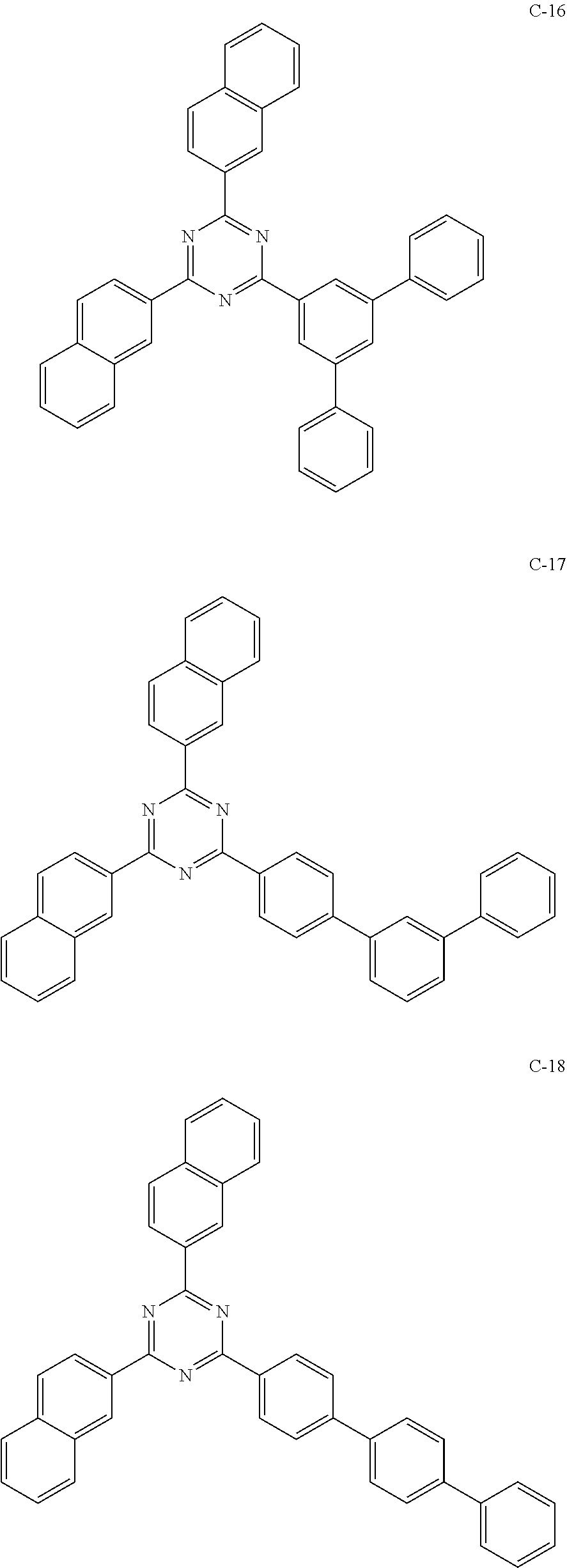









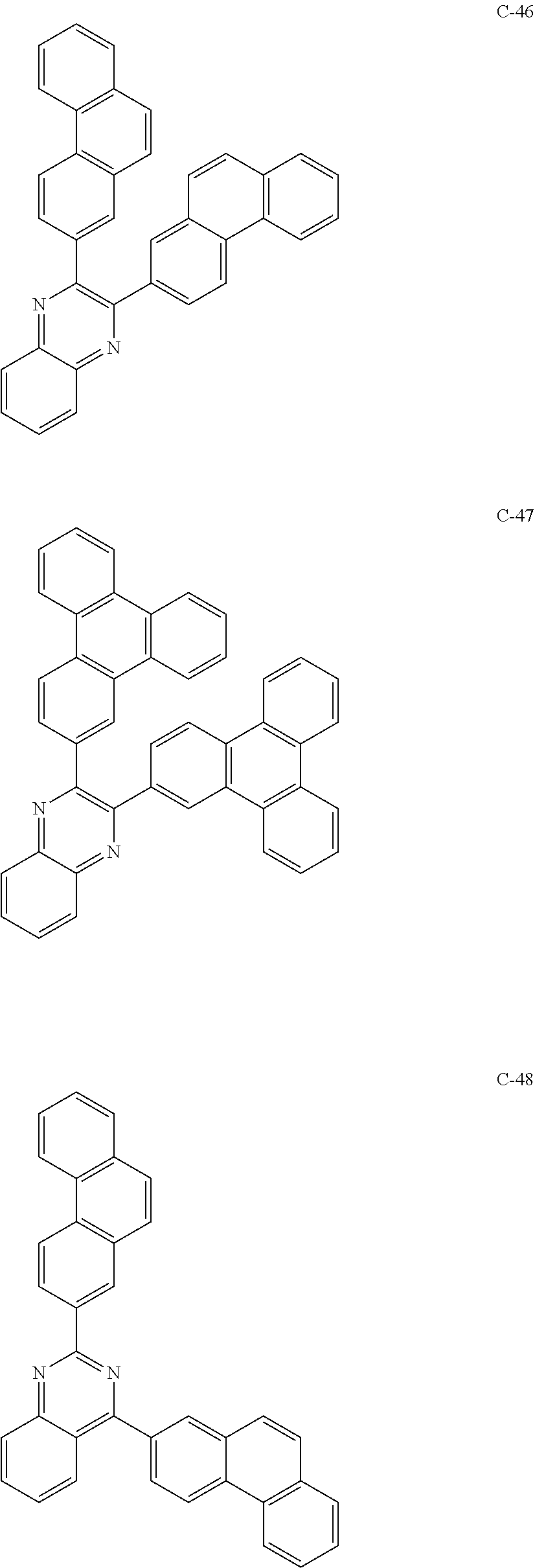













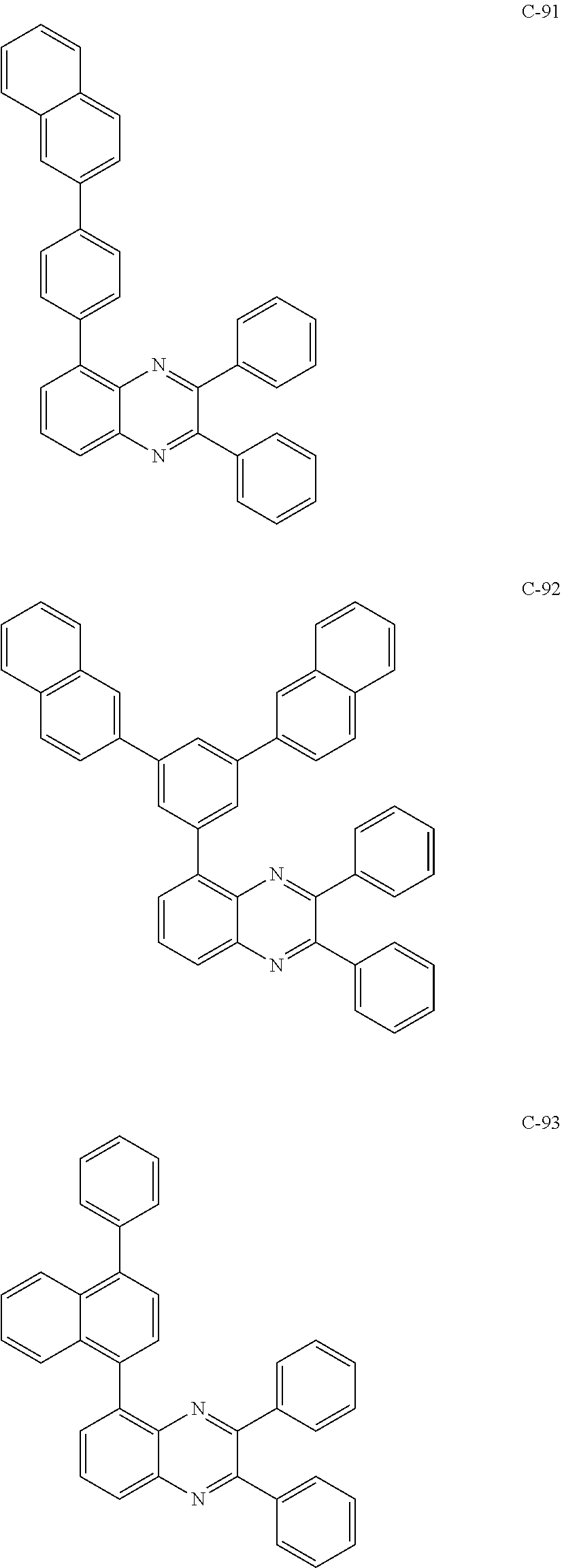






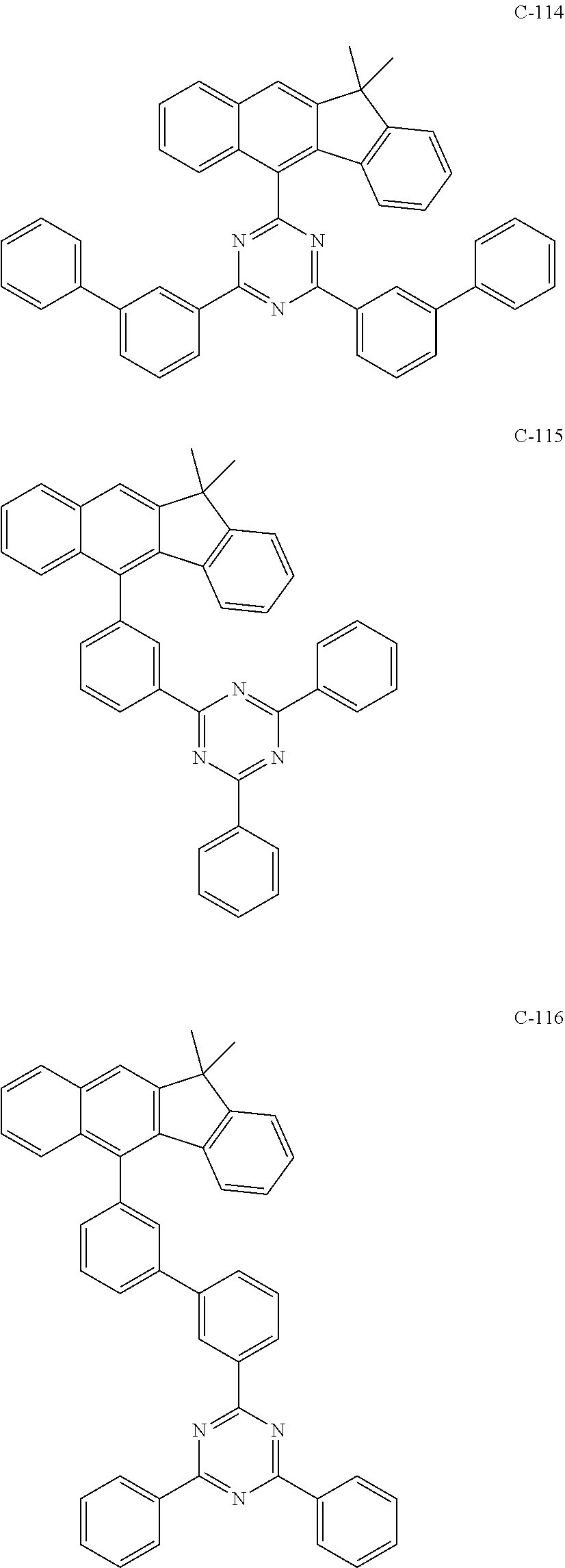
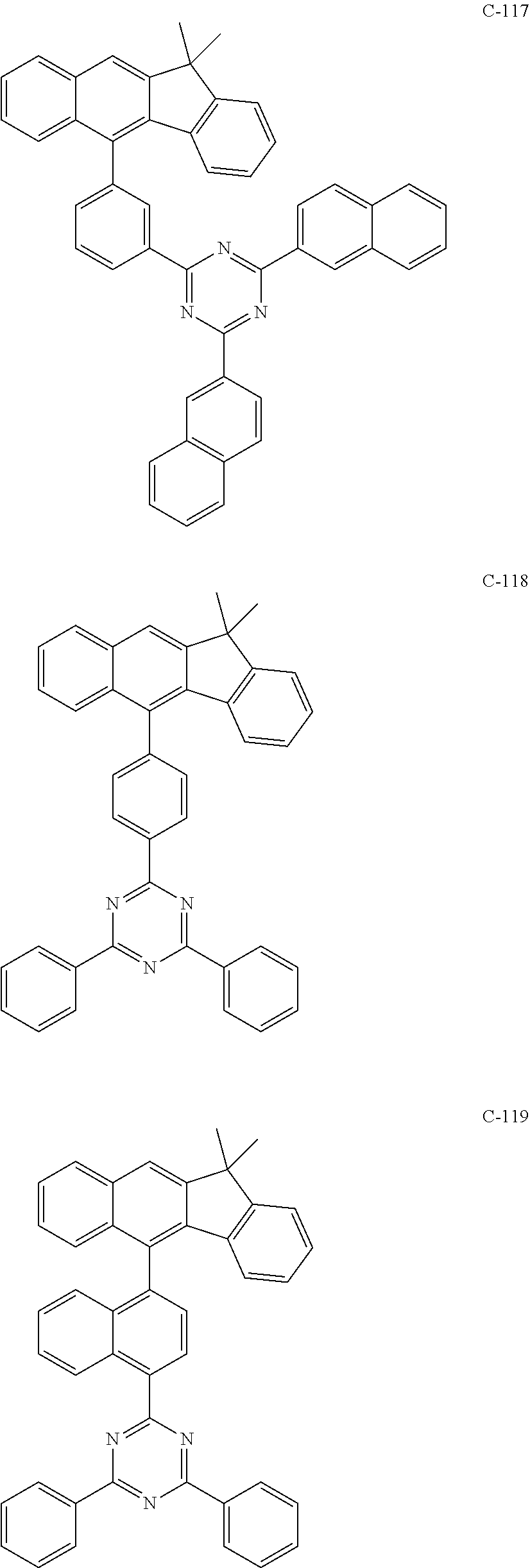

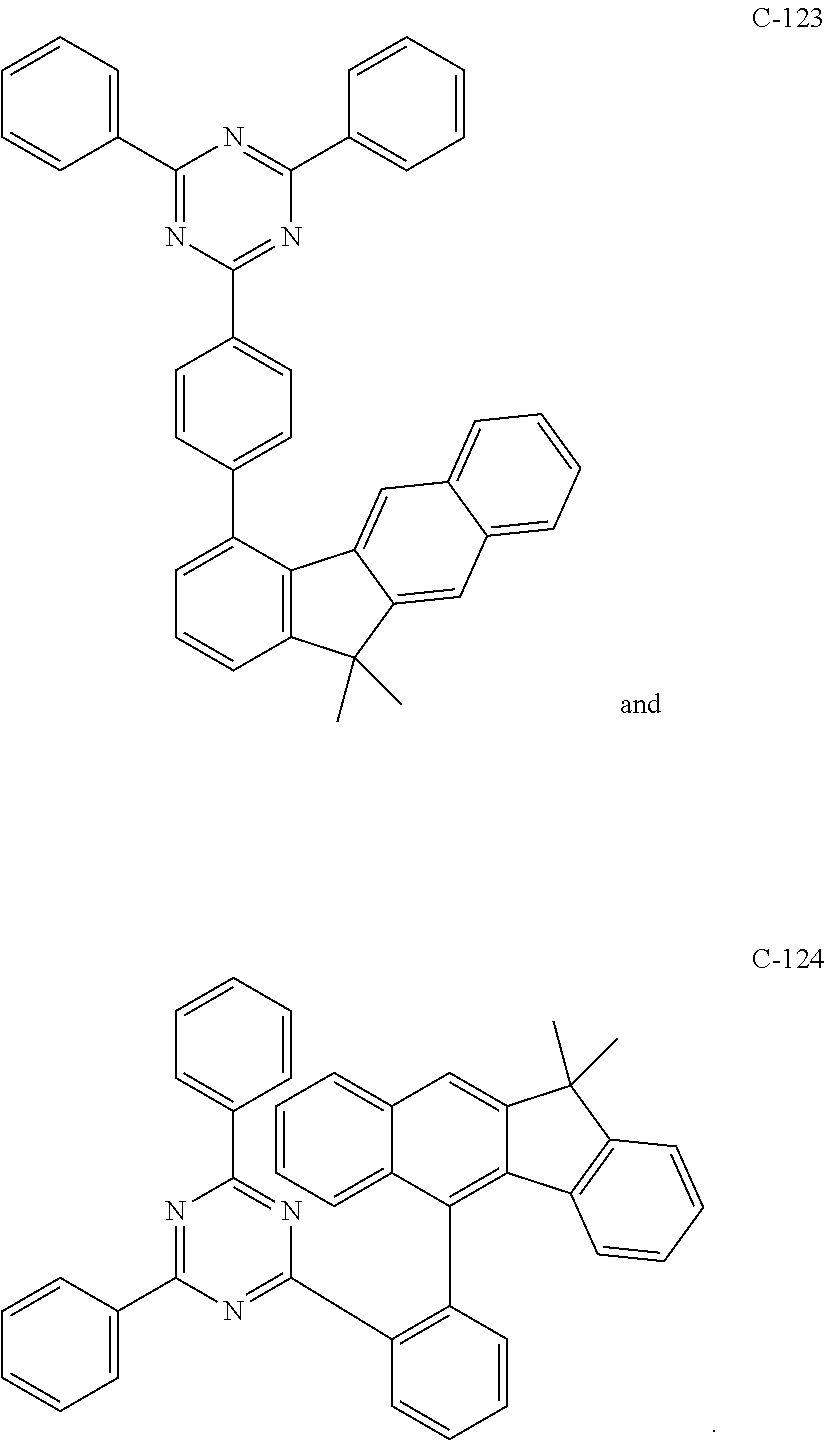

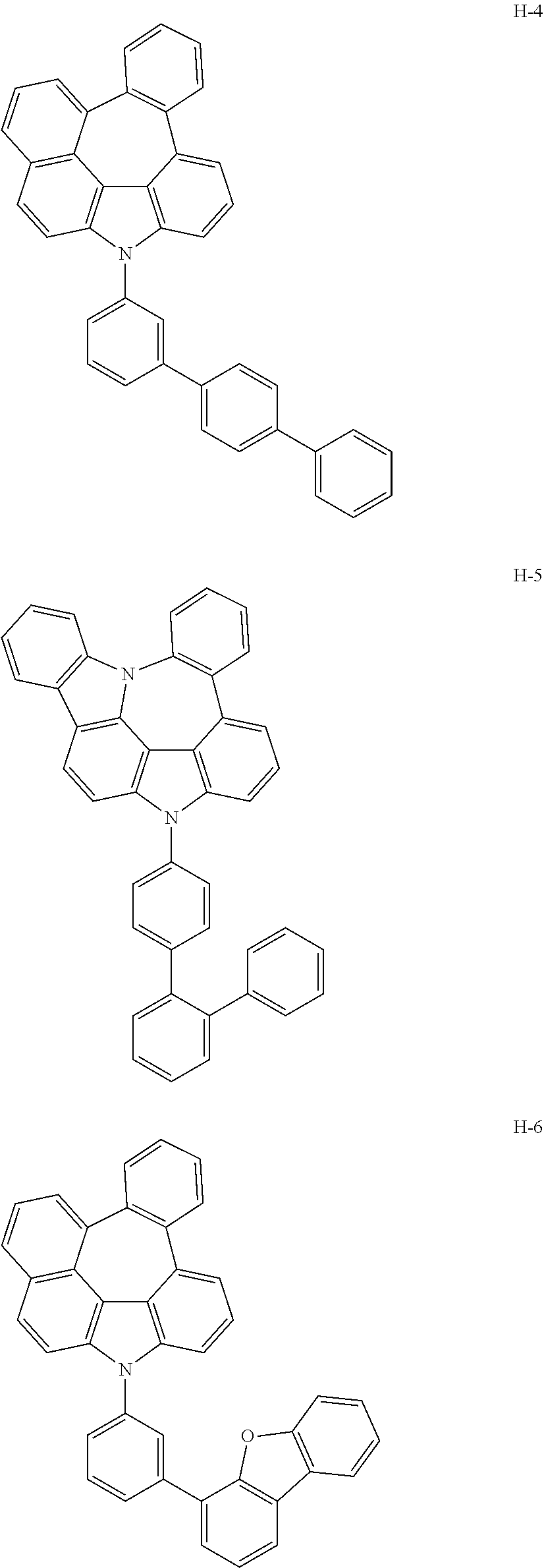
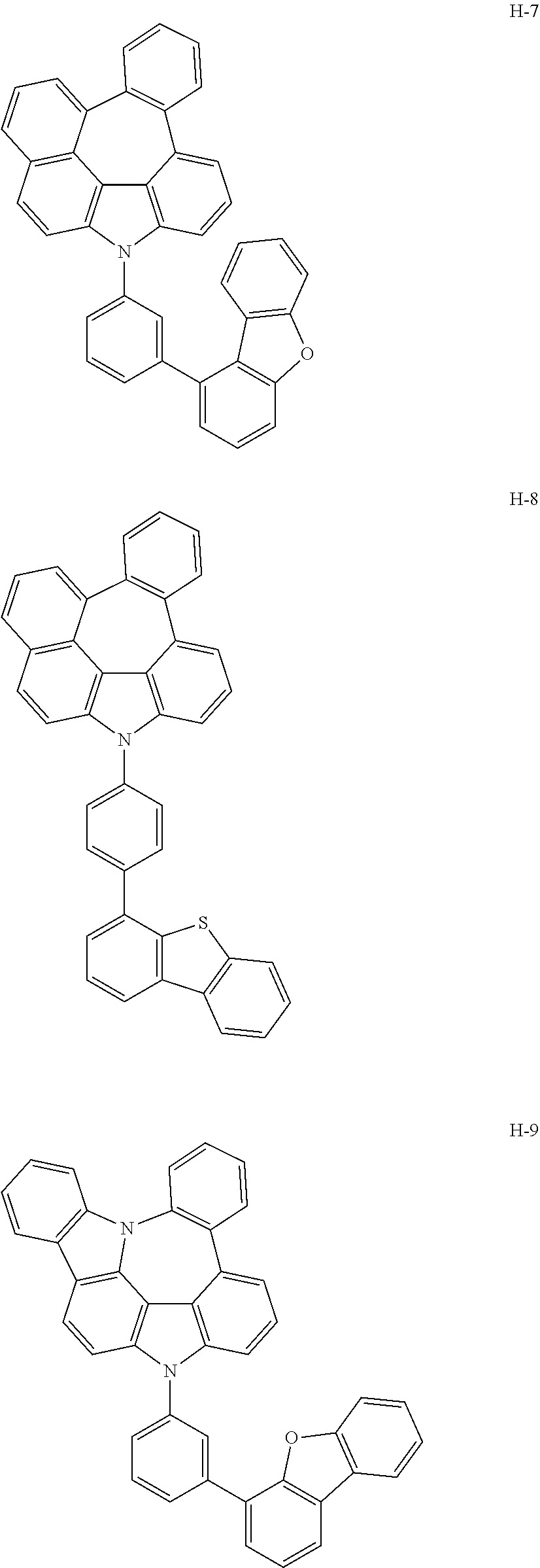


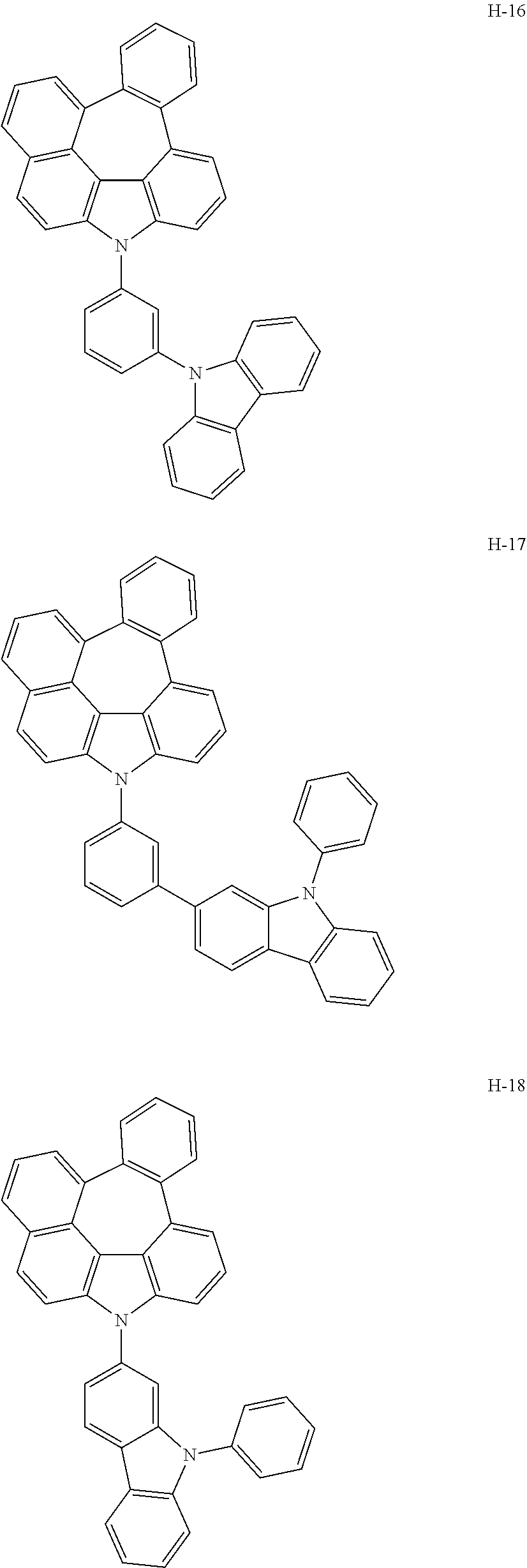


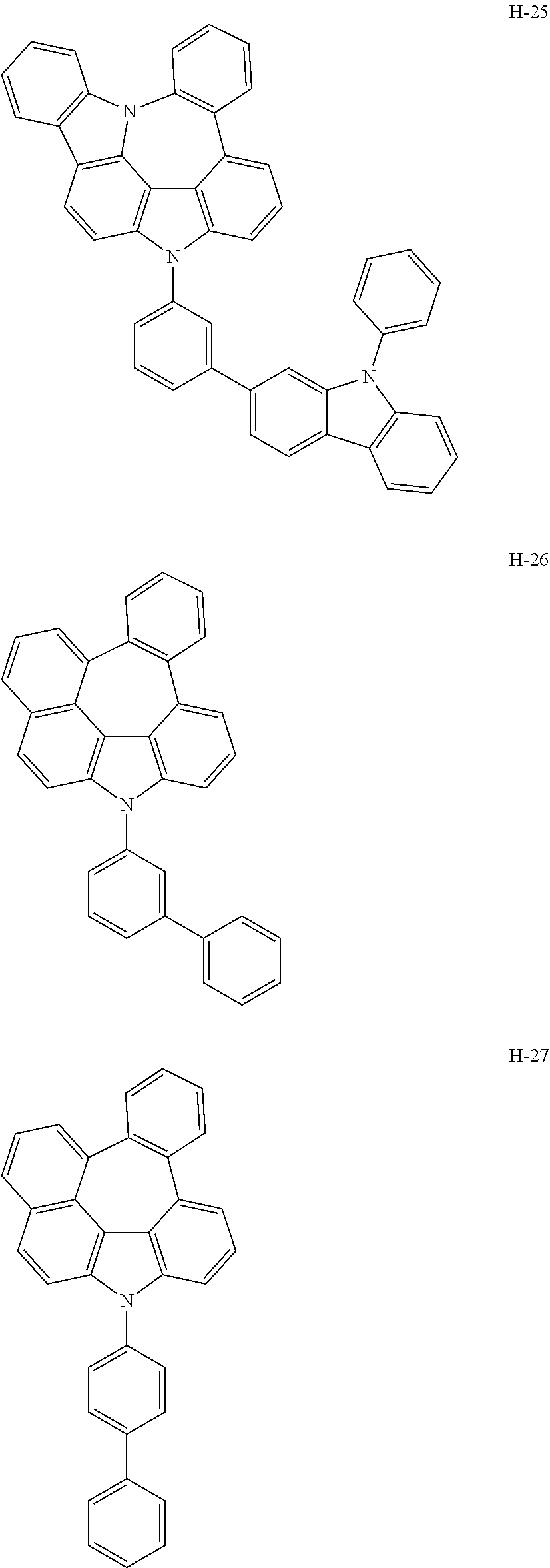
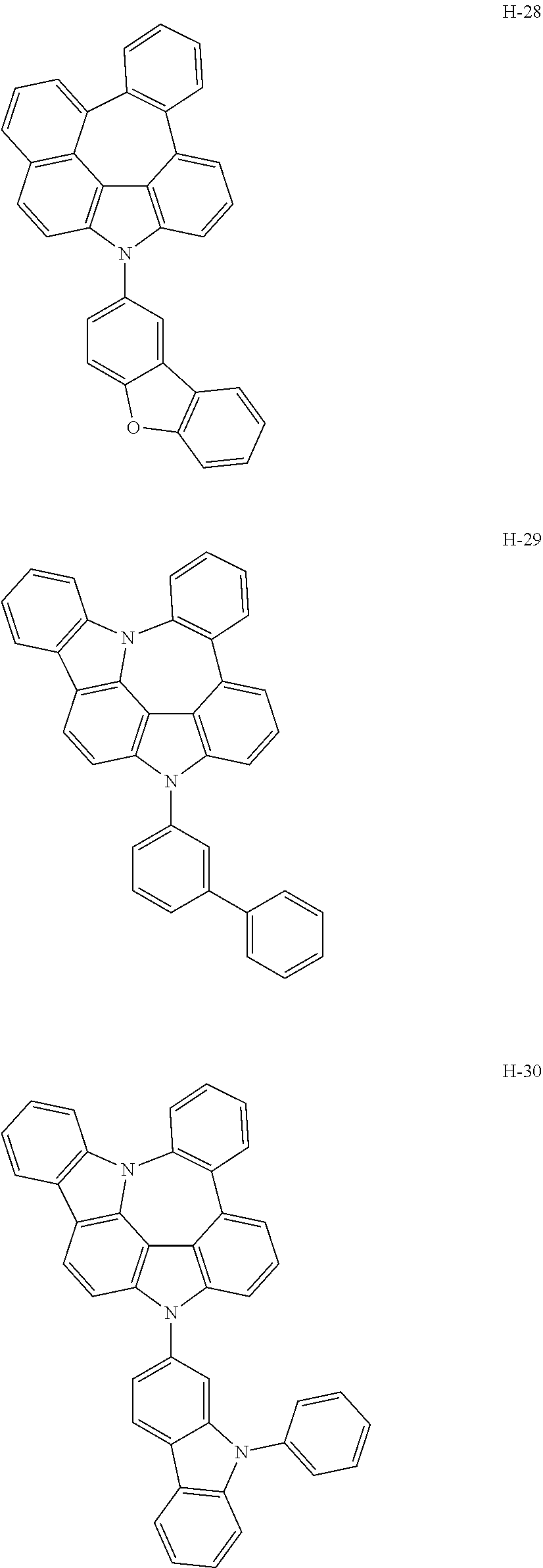


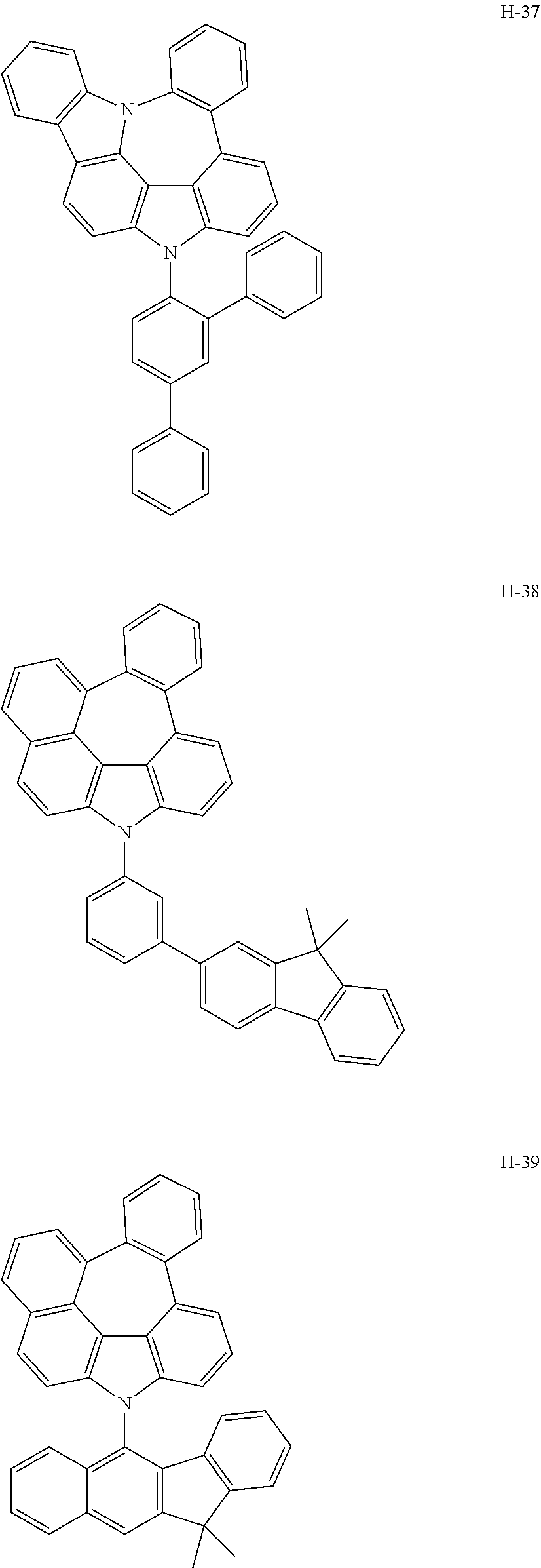
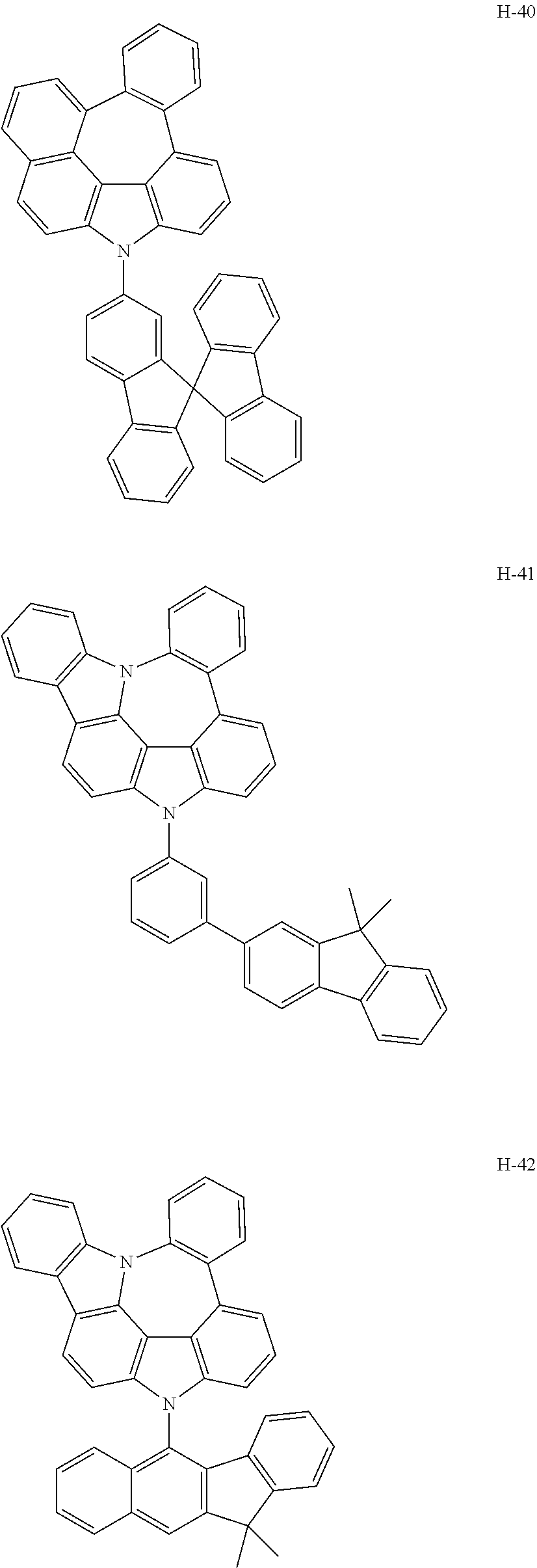



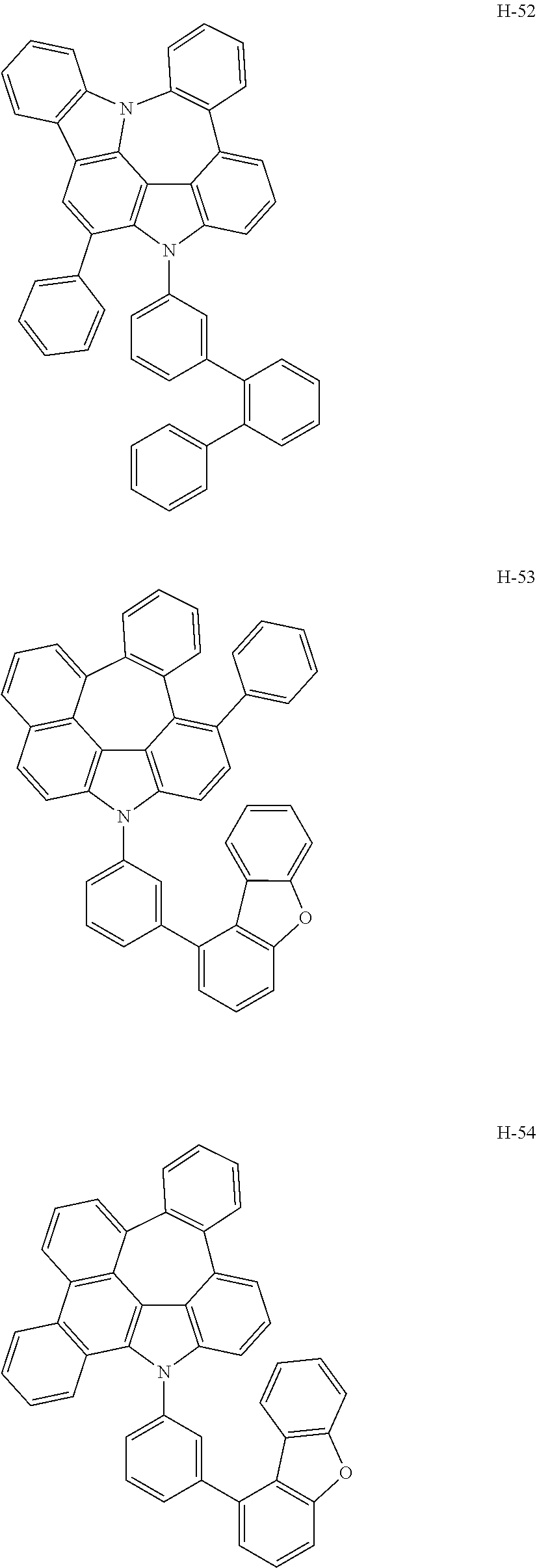



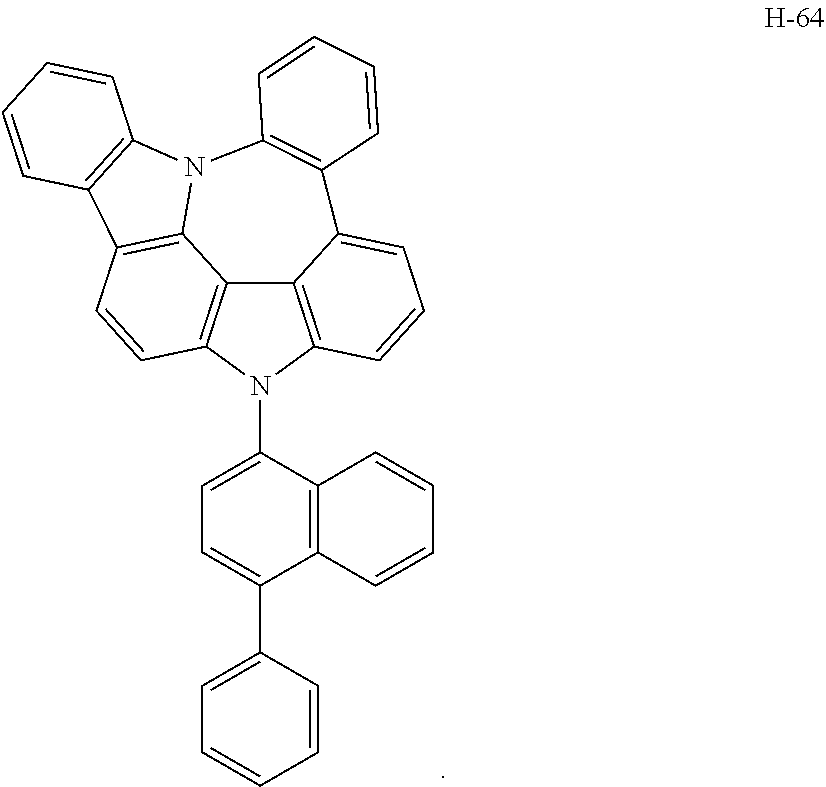
XML
uspto.report is an independent third-party trademark research tool that is not affiliated, endorsed, or sponsored by the United States Patent and Trademark Office (USPTO) or any other governmental organization. The information provided by uspto.report is based on publicly available data at the time of writing and is intended for informational purposes only.
While we strive to provide accurate and up-to-date information, we do not guarantee the accuracy, completeness, reliability, or suitability of the information displayed on this site. The use of this site is at your own risk. Any reliance you place on such information is therefore strictly at your own risk.
All official trademark data, including owner information, should be verified by visiting the official USPTO website at www.uspto.gov. This site is not intended to replace professional legal advice and should not be used as a substitute for consulting with a legal professional who is knowledgeable about trademark law.